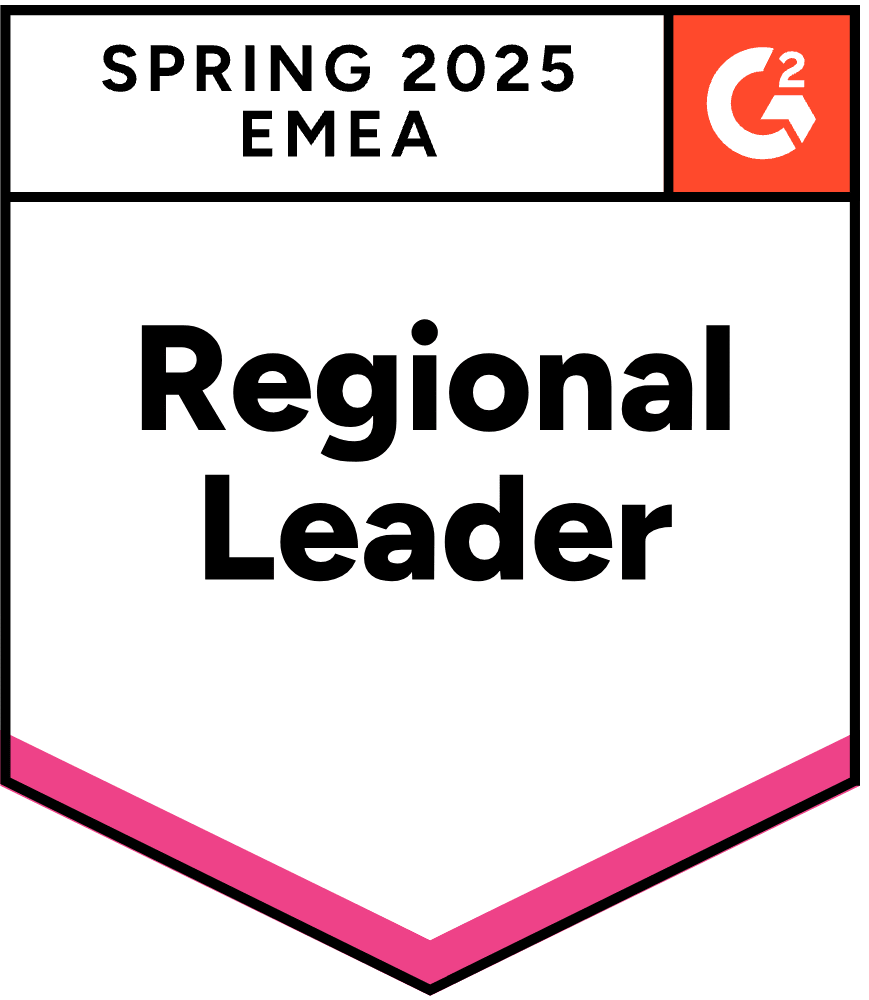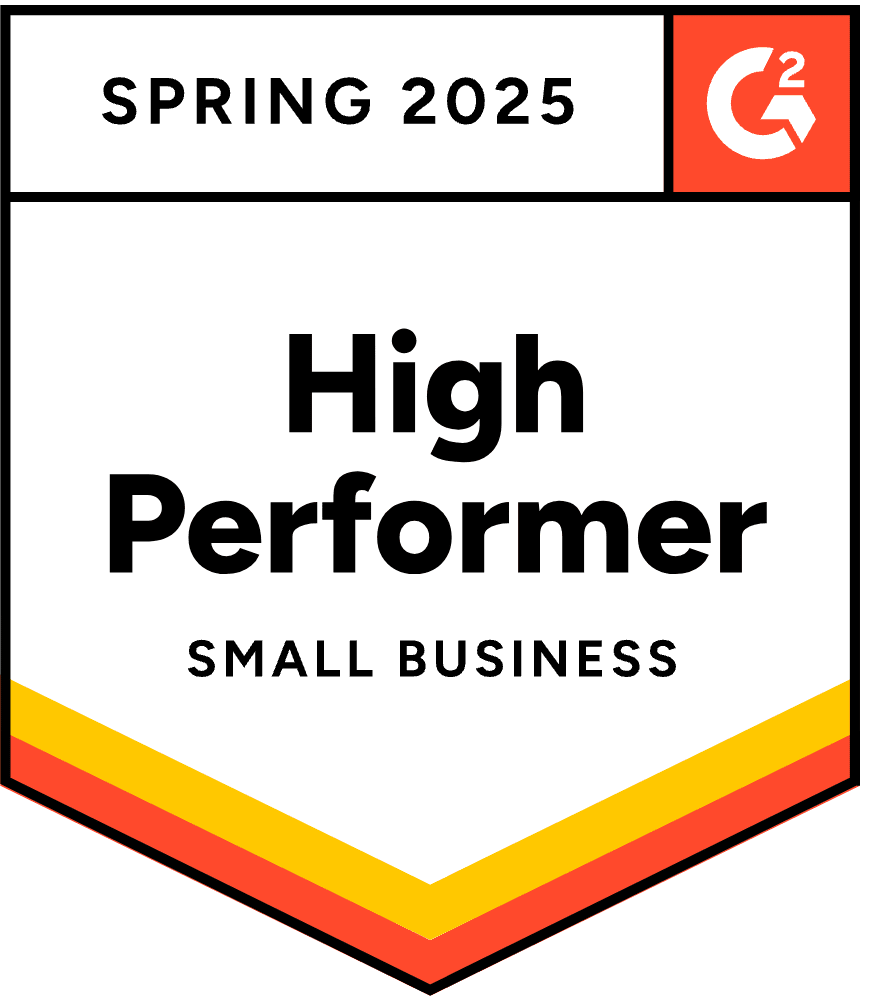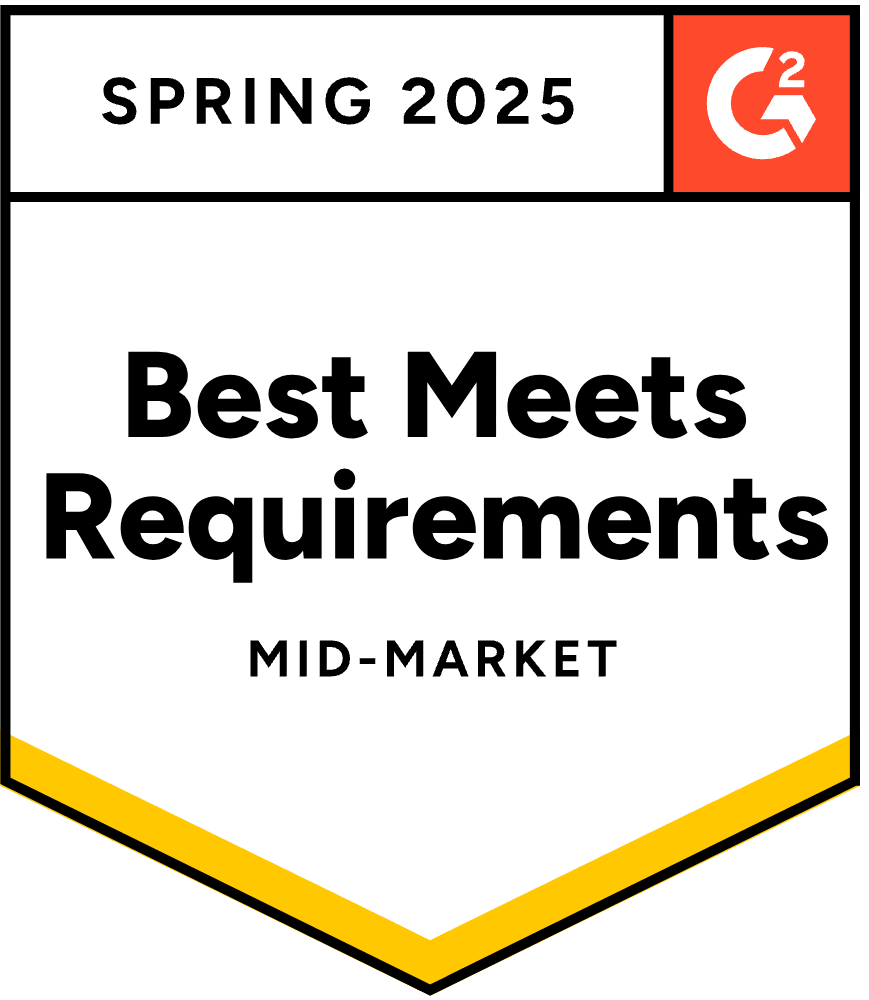- Blog
- 37 Ecommerce Web Design Examples That are Doing It Right in 2026
37 Ecommerce Web Design Examples That are Doing It Right in 2026
Table of Contents
If you’re looking to revamp your ecommerce web design, improve user experience, or simply draw inspiration from the best in the business, you’re in the right place.
Whether you’re building your online store from scratch or optimizing an existing one, these ecommerce website design examples will give you a fresh perspective.
In this article, we’ll share…
- 37 awesome ecommerce website design examples,
- what makes each one outstanding, and
- how can you apply these strategies to your own website.
Ready? Let’s dive in!
What makes an ecommerce website design really great?
Before we get into the examples, let’s first take a look at some key factors that make an ecommerce website design stand out.
1. Easily scannable
Users should be able to scan your website in seconds. Think about old-school newspapers: a clean layout, bold headlines, organized sections….
A modern ecommerce website should be the same.
Make use of:
- simple, unique fonts;,
- consistent color schemes; and
- easy-to-understand navigation.
Remember, less is more. You don’t want visual clutter.
Stanley’s website does an excellent job of creating a clean, scannable layout that lets users easily navigate and shop.

2. Clear site navigation
Clear and intuitive navigation is crucial. Visitors should be able to find what they’re looking for within seconds.
Keep your top navigation simple. Include only the essential categories, like:
- Products,
- Bundles, and
- About Us.
Everything else can go into the website footer.
By keeping the top bar clean and concise, you helps users focus on their shopping journey.
Here’s an example from Pipcorn. They use simple, effective site navigation design.
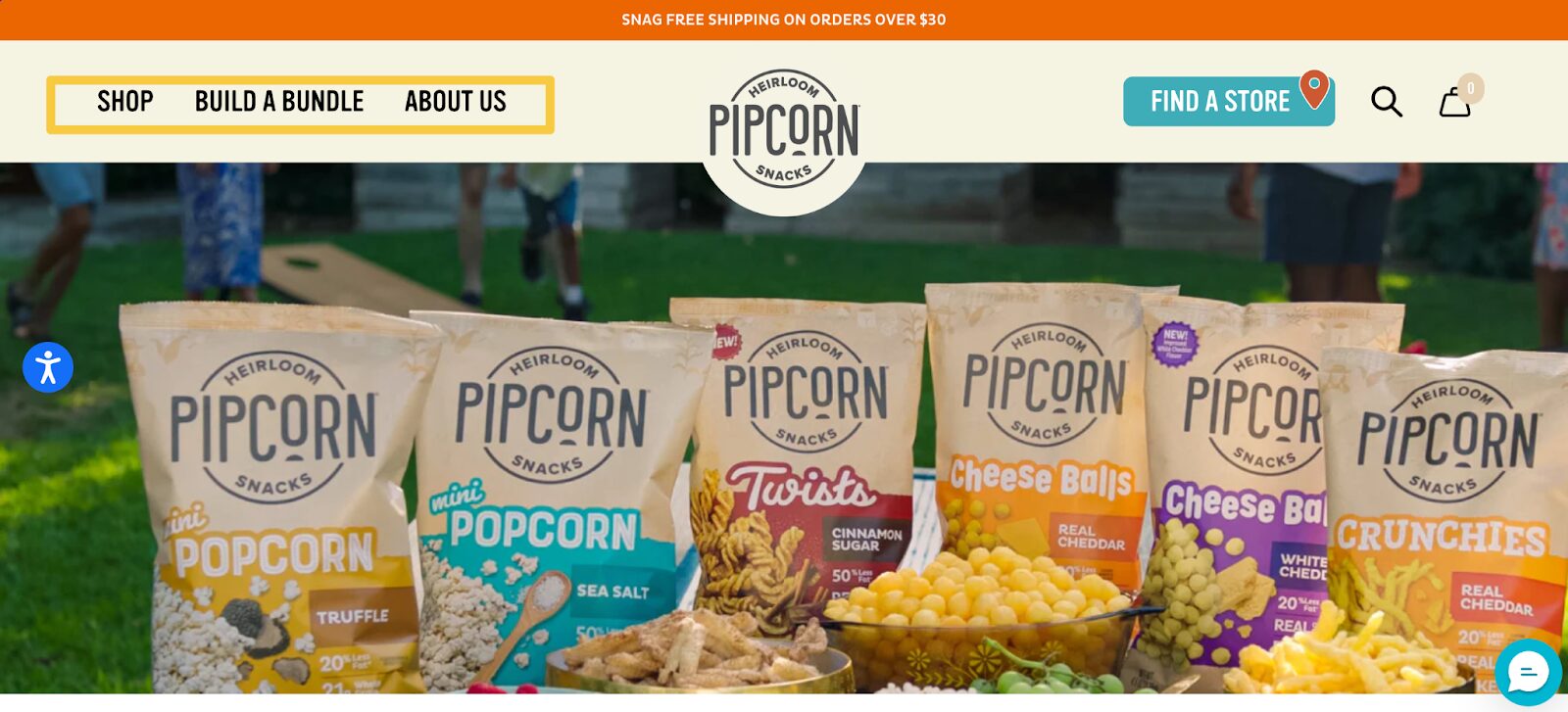
3. High-quality product photos and videos
Your product photos are your biggest asset. Use high-resolution images with zoom functionality and lifestyle photos that show products in real-life scenarios.
Adding short videos (like 360° views or how-to clips) can significantly boost trust and conversions.
Snow Peak excels at showcasing sophisticated, elegant imagery that beautifully reflects their brand identity.
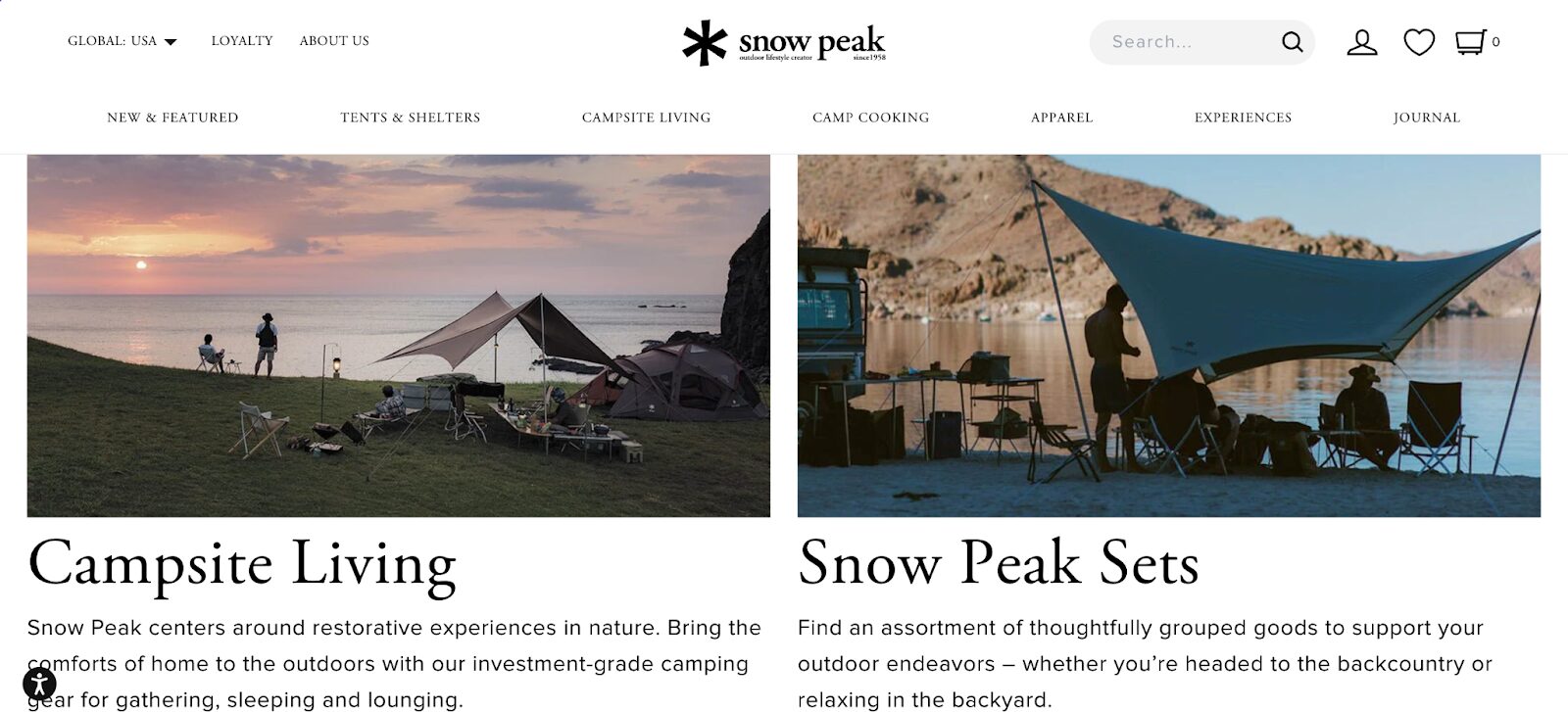
4. Fast loading speed
A beautiful website is only effective if it’s fast. Users expect pages to load in under three seconds—if it takes longer, they’ll likely bounce. Slow websites can negatively impact both user experience and your SEO rankings, so it’s crucial to optimize for speed.
Start by compressing images, implementing caching strategies, and selecting a reliable, fast hosting provider to guarantee smooth performance.
This will ensure your visitors can navigate your site without frustration, improving conversion rates and keeping users engaged.
5. Mobile-first design
With over 70% of ecommerce traffic now coming from mobile devices, mobile-first design has become really important.
By prioritizing mobile responsiveness, you ensure that your website, product pages, and checkout process are easy to navigate on any screen.
A mobile-optimized design helps you reach a larger audience, providing a seamless shopping experience no matter what device they’re visiting you from.
Rare Beauty excels in mobile-first design, ensuring their site is fully mobile-friendly with tappable buttons and stunning imagery that’s easy to navigate.
Every element is optimized for a seamless mobile experience, making it simple for users to shop and browse on any device.
They clearly understand how a user-friendly mobile interface can enhance customer satisfaction, making the shopping experience more enjoyable and convenient, which in turn boosts conversions.
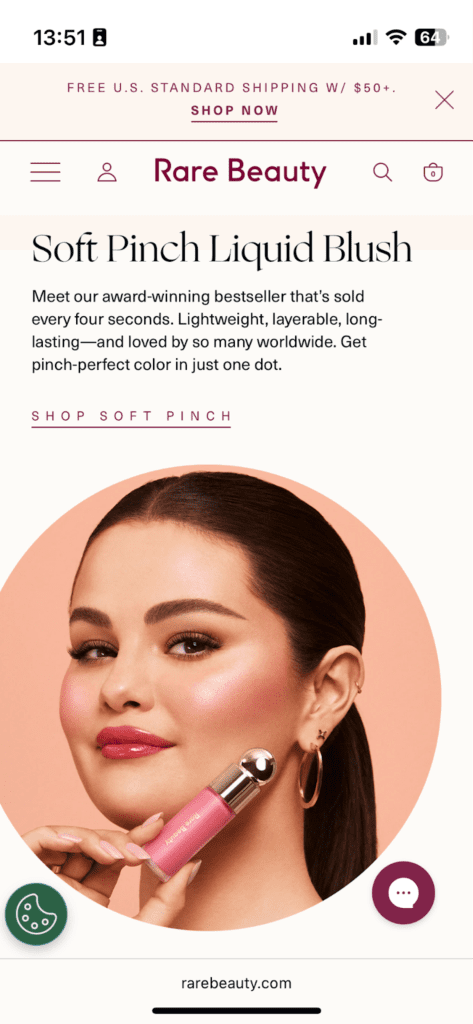
37 ecommerce website design examples to inspire you
Now that we’ve covered some fundamental design tips, let’s dive into 37 ecommerce website examples that can inspire your own site.
1. Rains
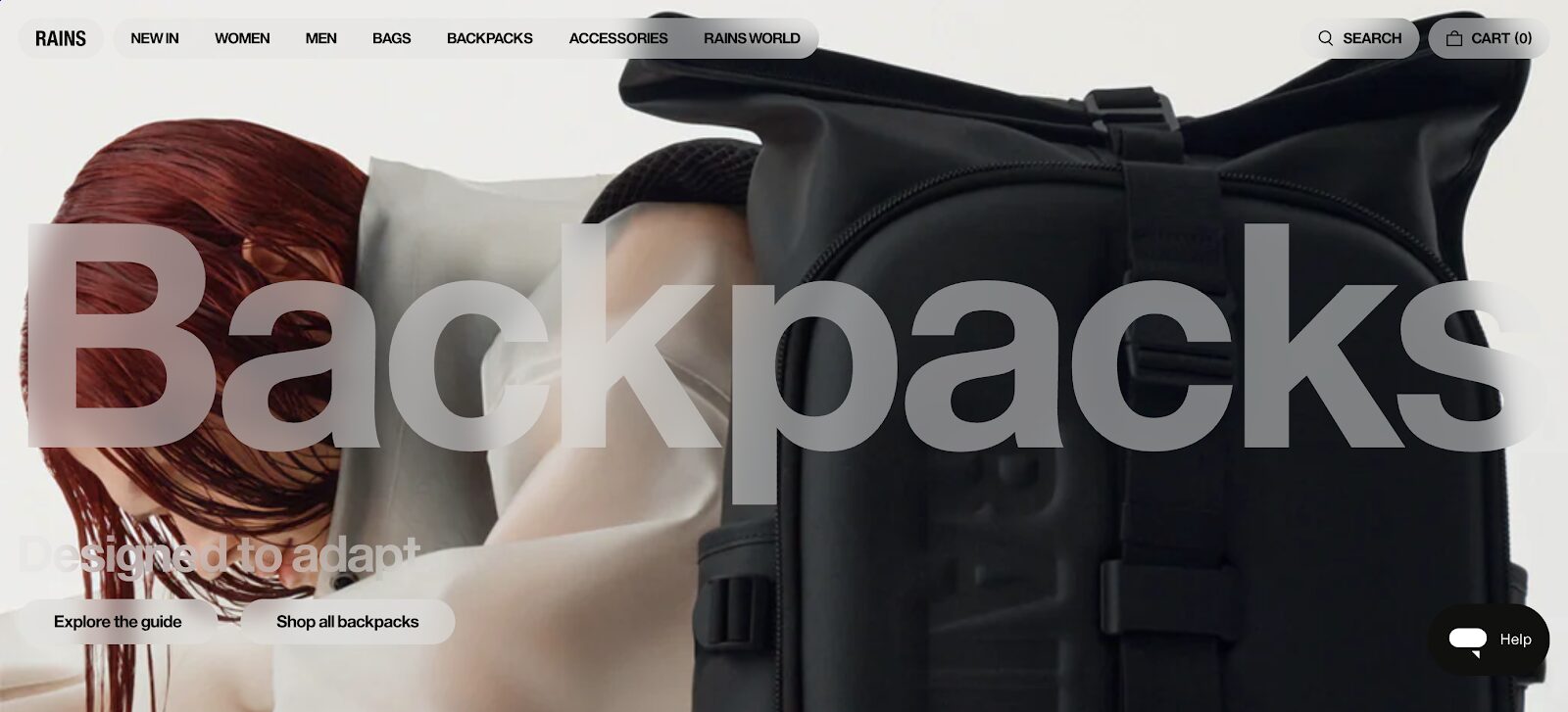
Rains is a brand specializing in waterproof products like bags, backpacks, and jackets. Their website exudes a blend of simplicity and sophistication, with a user-friendly layout that’s both clean and functional.
The website makes it easy for visitors to find their way around with a clear, easy-to-navigate header.
Plus, they’ve incorporated sticky buttons, such as “Explore the guide,” or “Shop all backpacks” that guide users directly to key product categories, making shopping intuitive and seamless.
What we love:
- Simple, practical design that speaks to the brand’s ethos
- Gorgeous, visually appealing landing page for backpacks that catches the eye
- Effortless navigation thanks to the sticky “Explore the Guide” button
2. Béis Travel
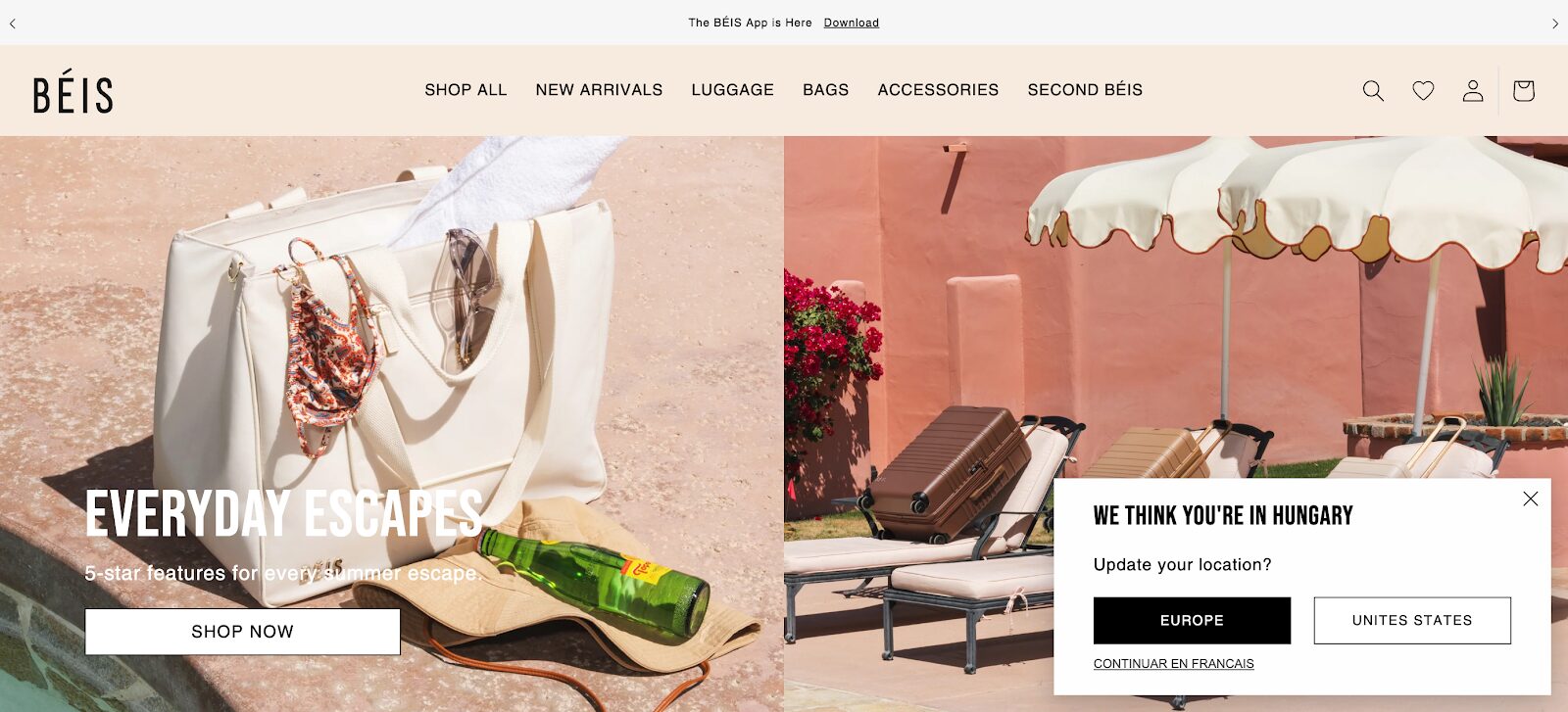
Béis, a travel gear brand, nails personalization with their great ecommerce website design. Their site allows users to filter products by destination, color, and use, offering a tailored shopping experience.
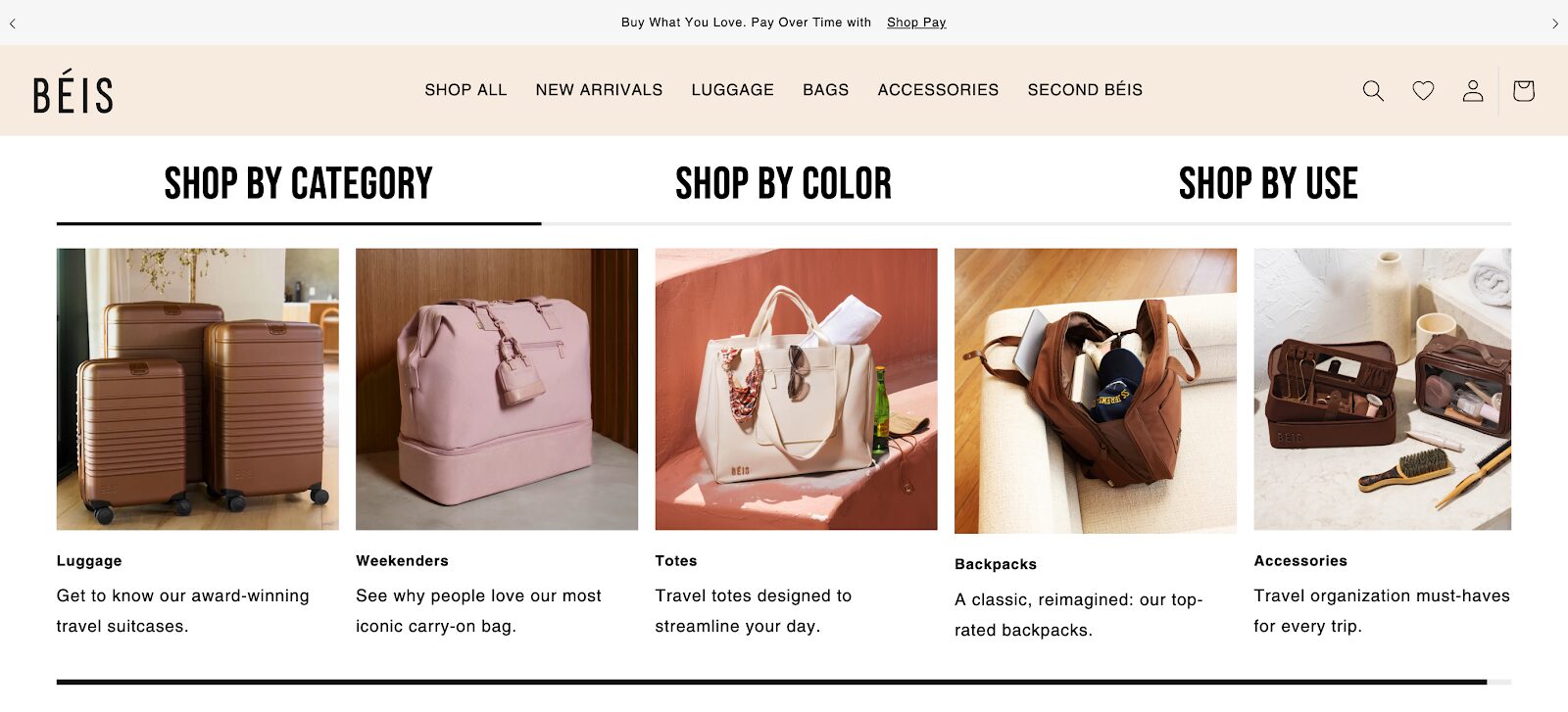
What we love:
- The site is scannable and makes good use of white space to improve the user experience
- A shopping category featured right on the homepage, making it visible and accessible without extra clicks
- A sticky bar that allows visitors to select their destination with ease, improving the browsing experience
Check out Beis Travel’s marketing analysis.
3. Khy by Kylie Jenner
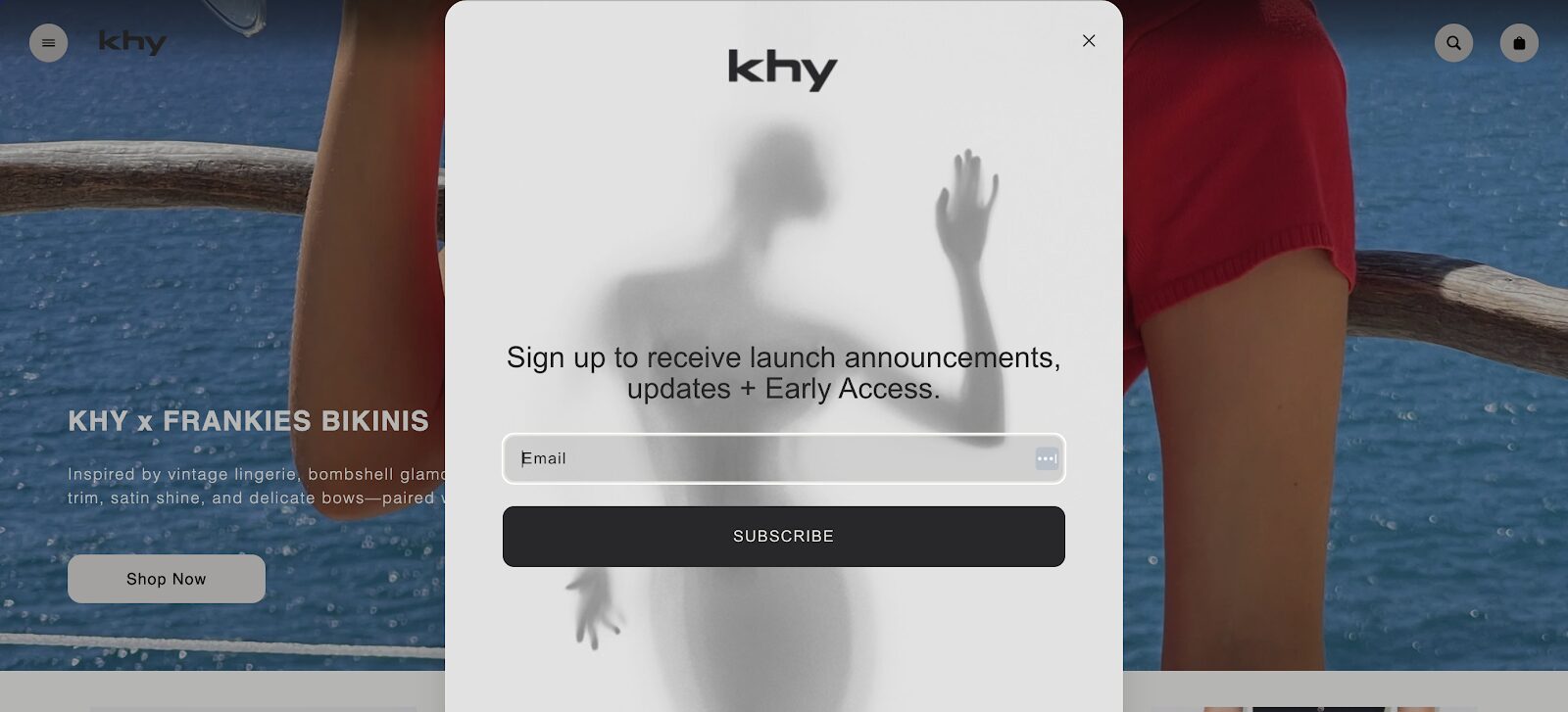
Khy, Kylie Jenner’s clothing brand, adopts a sleek and minimalistic approach to ecommerce design.
The website’s clean aesthetic is paired with a simple sign-up popup that encourages visitors to engage by offering early access and launch announcements.
The latest product drops are featured prominently on the homepage, making it easy for fans to shop the newest arrivals as soon as they land.

What we love:
- Clean, simple signup pop-up, offering value right away
- Clutter-free design with a clear focus on showcasing the newest products
- Quick, easy access to the latest drops, keeping visitors engaged and up-to-date
Discover what’s working and what’s not with Kylie Jenner’s brand.
4. Alo Yoga
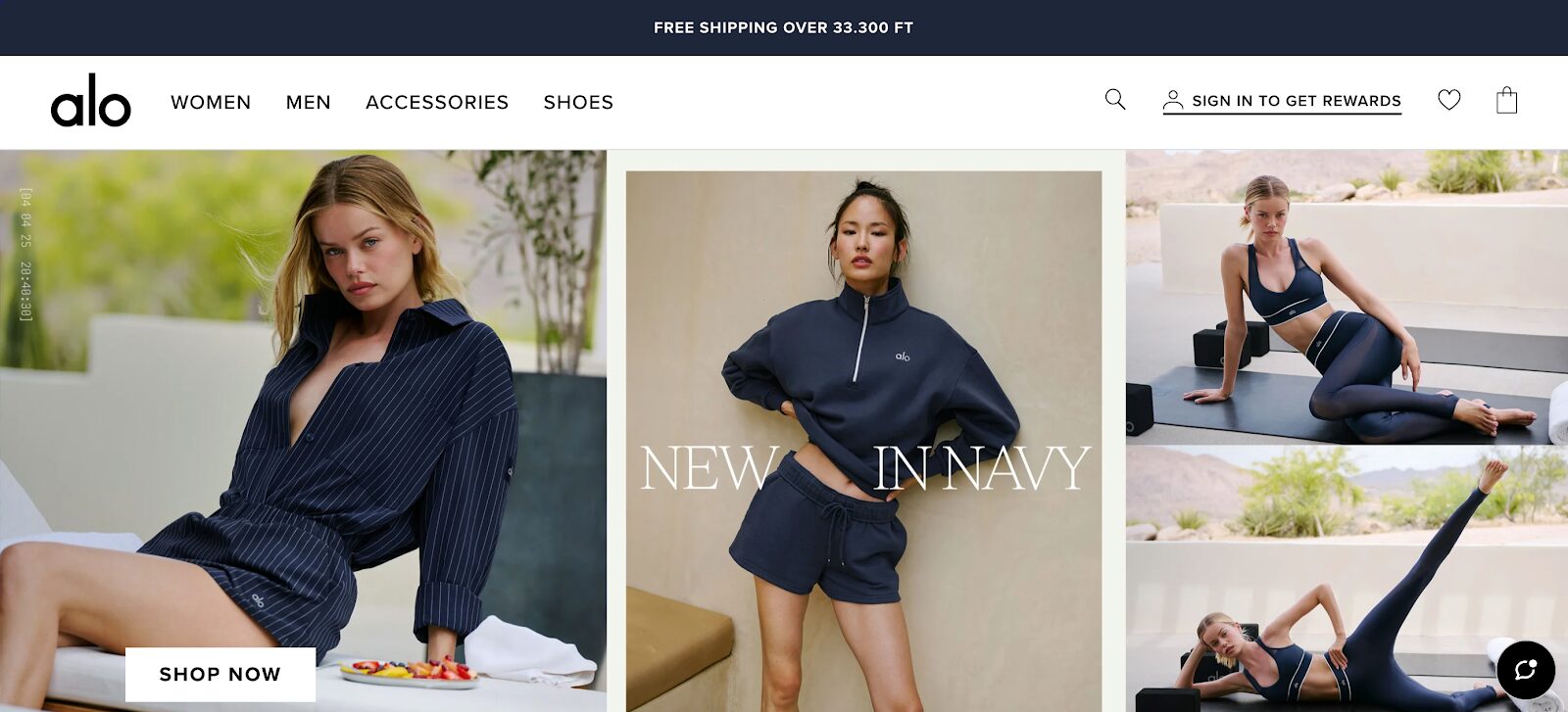
Alo Yoga’s ecommerce website does an excellent job of delivering a seamless shopping experience.
As soon as you land on the homepage, you’re greeted with the “Trending Now” section, which helps visitors easily discover the latest products.
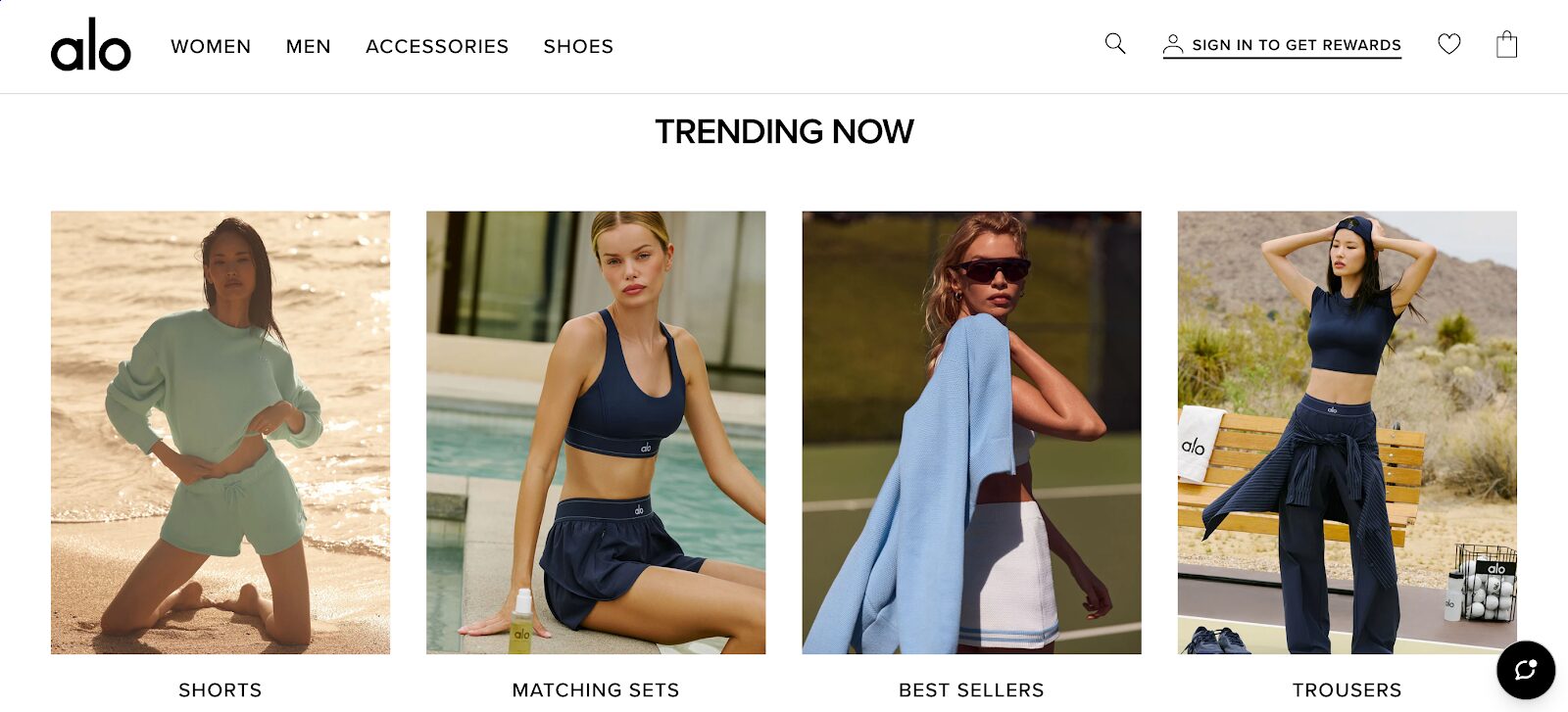
Additionally, their popup offering a discount on sign-up is a smart tactic to boost conversions and enhance the customer experience.
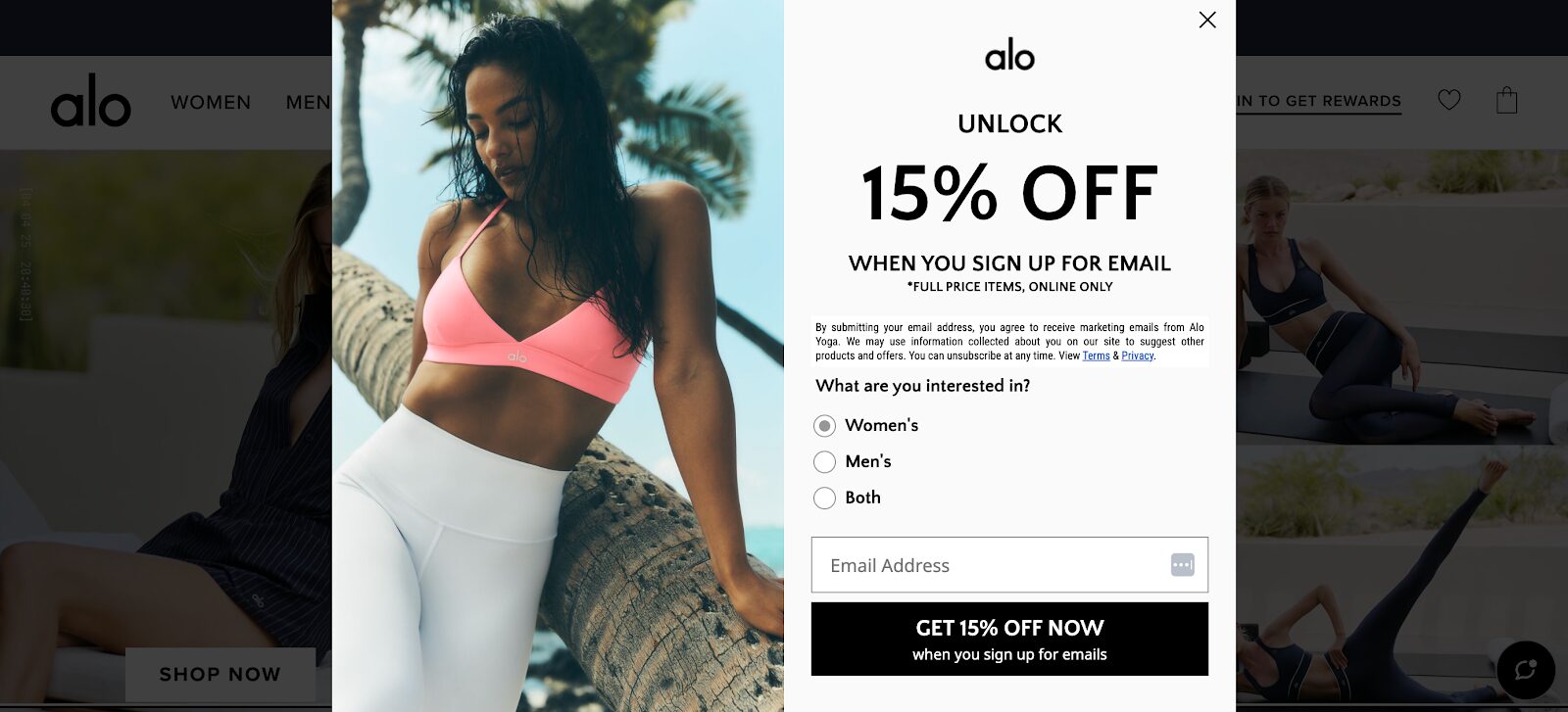
What we love:
- Free shipping bar displayed at the top of the site, reassuring users about shipping costs
- “Trending Now” section to help visitors quickly browse hot new items
- A well-placed popup that segments customers and increases conversion rates by targeting specific shoppers
5. Allbirds

Allbirds, known for their sustainable, eco-friendly footwear, keeps their website design interactive yet straightforward.
Their homepage features a rotating carousel with eye-catching images, highlighting new arrivals and key product categories like Men, Women, and Sale.
The simple, uncluttered top navigation makes it easy for users to find what they’re looking for with minimal effort.

What we love:
- Interactive elements, like the changing home page carousel, keep the site engaging
- Clear, user-friendly navigation focuses on ease-of-use
- Transparent communication about shipping, returns, and the brand’s sustainability initiatives
6. McCormick
McCormick’s website stands out by using high-quality videos on their homepage to showcase products in action.
This visually engaging approach grabs attention right away, making the brand’s products feel fresh and dynamic.
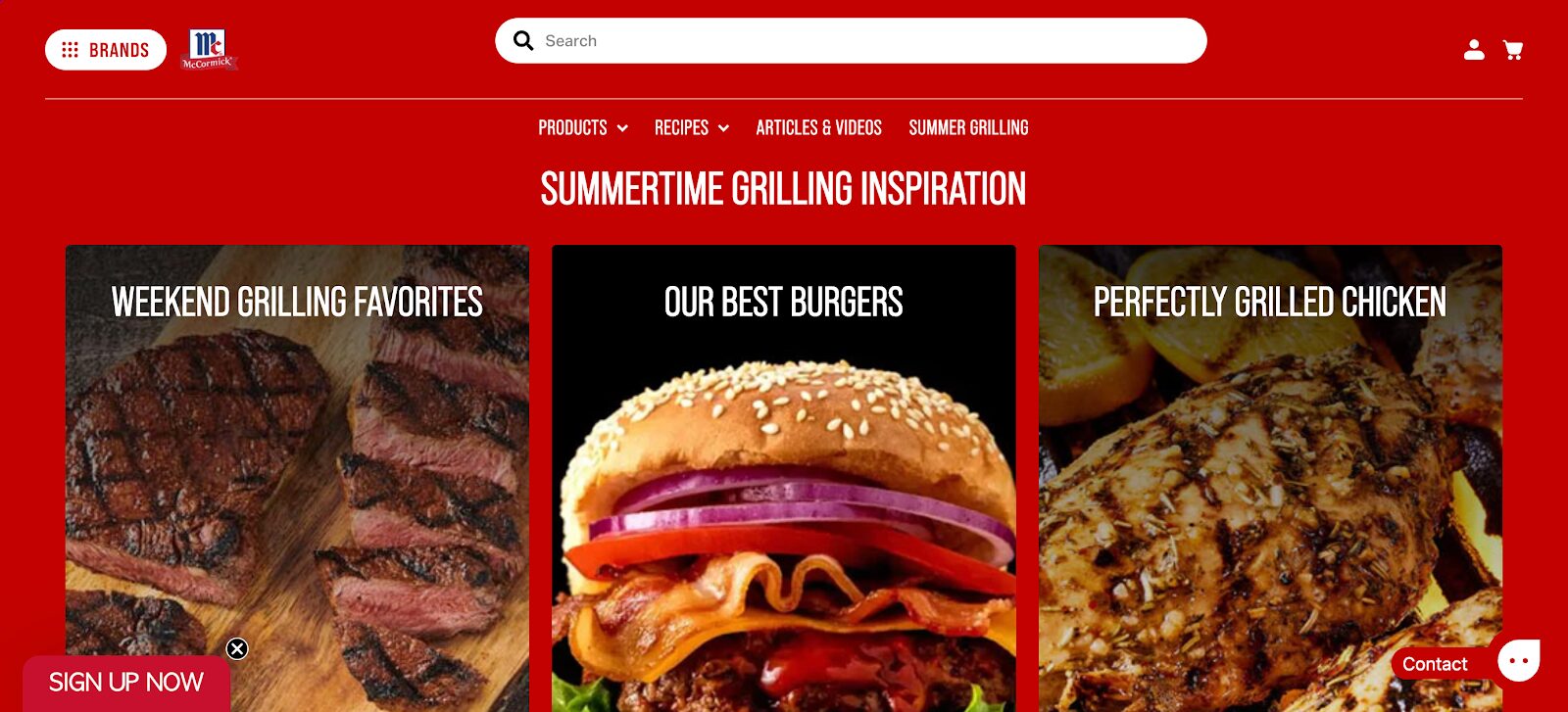
Alongside this, their sidebar provides an excellent example of how you can categorize your products to make navigation easier.
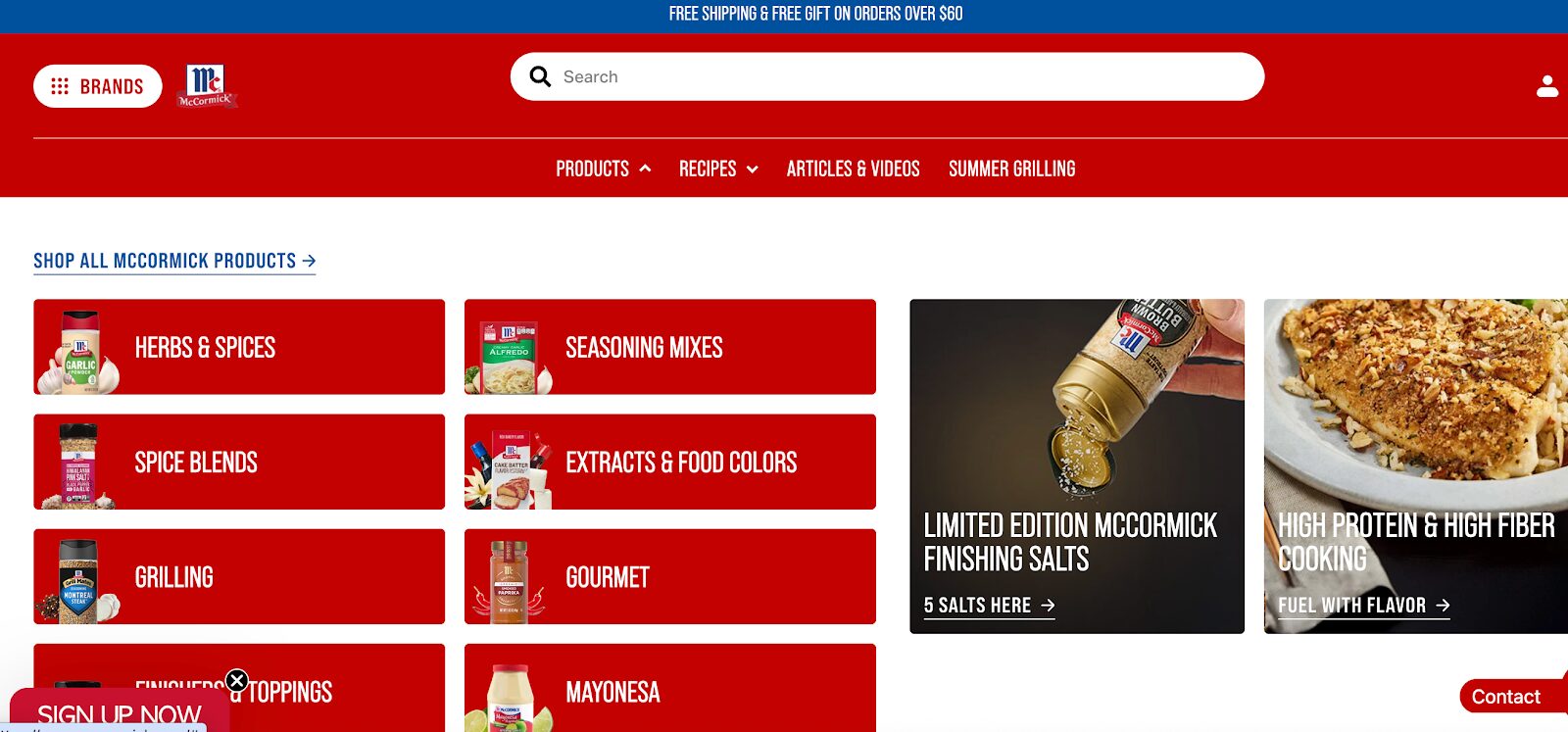
What we love:
- Engaging, high-quality video that demonstrates the products in real life
- Sidebar with neatly organized content, making it easy for visitors to explore
- Follow-up teaser after closing the popup, keeping engagement high
7. Bombas

Bombas’ website design perfectly reflects the brand’s fun, charitable personality. The design is clean and easy to navigate, and brings a nice playful touch.
They also have a simple yes/no popup, offering 20% off shoppers’ first order.
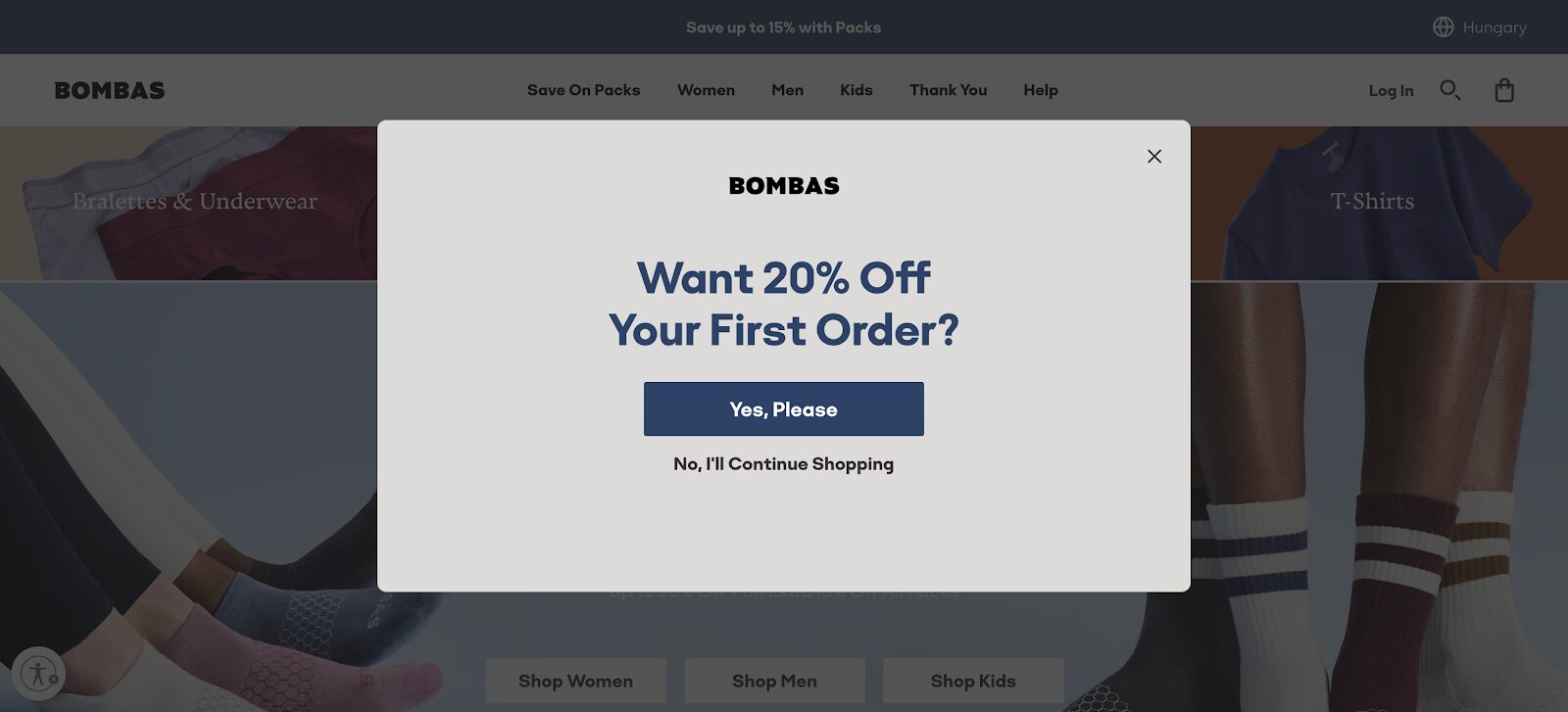
They emphasize their ethical marketing and donation practices, building trust with customers.

A “Save on Packs” section encourages shoppers to bundle products, boosting AOV.
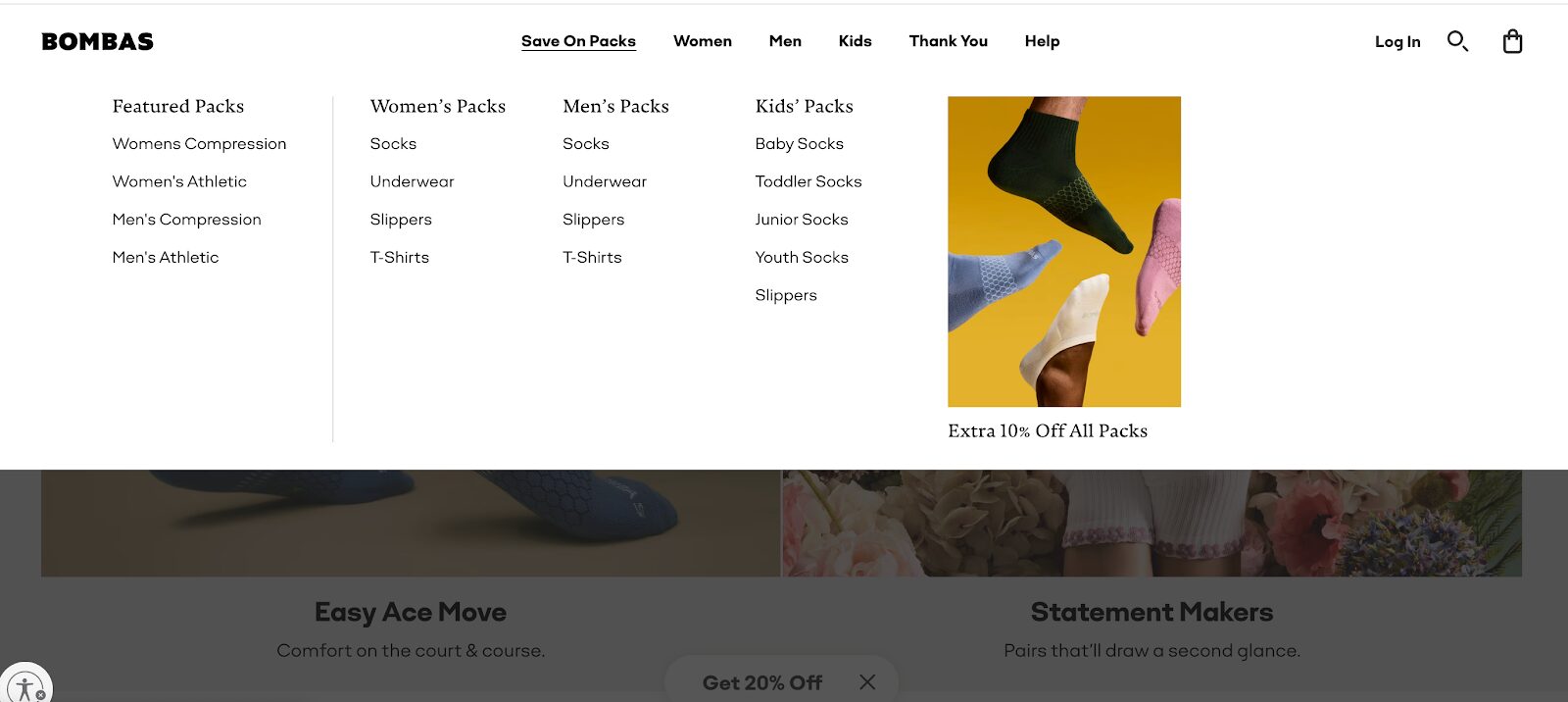
What we love:
- Playful, engaging design that reflects the brand’s personality
- A section dedicated to saving on packs, making shopping more enticing
- Clear communication of ethical marketing and donation initiatives that build customer loyalty
Ready to try yes/no popups? Take a look at these templates.
8. Gymshark
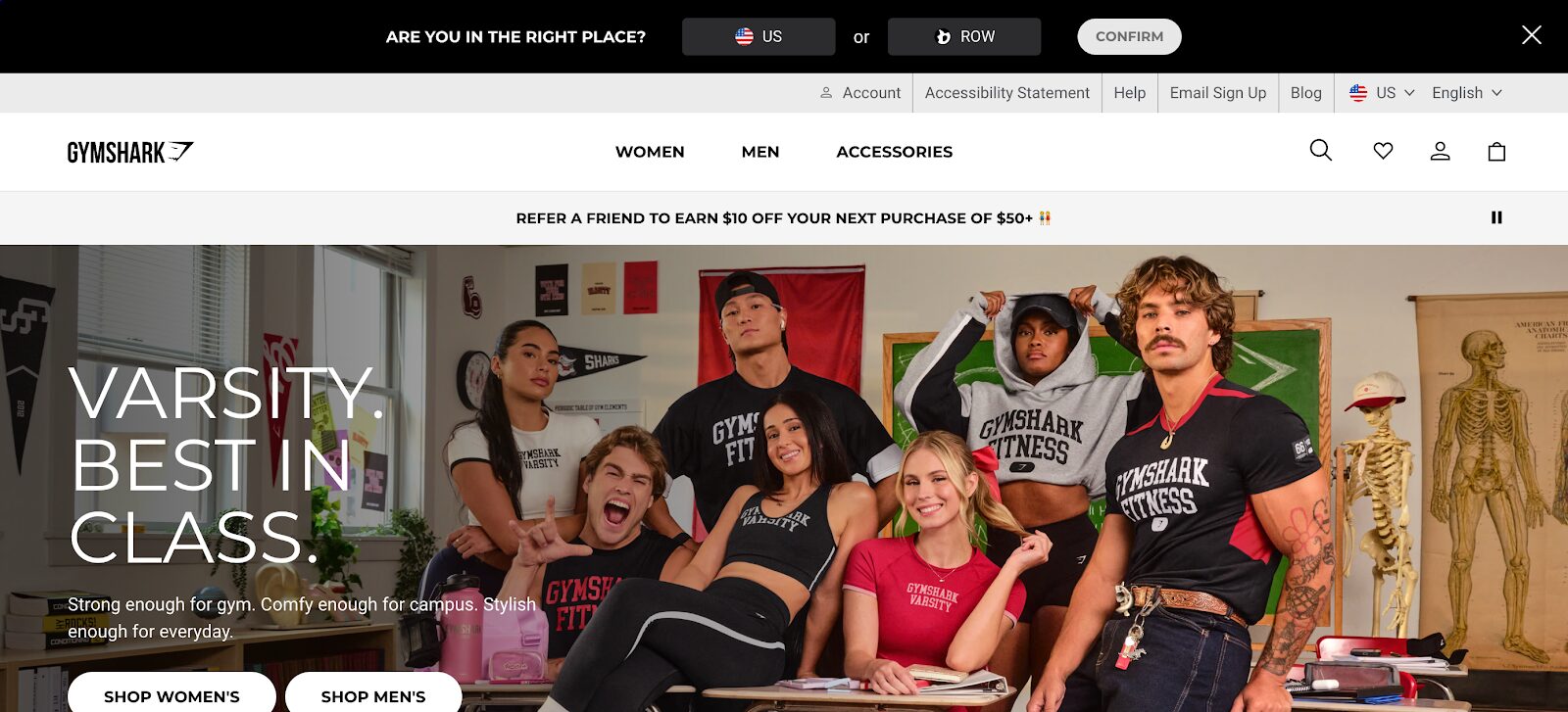
Gymshark, a leading fitness brand, has a website designed to help users shop based on their fitness goals.
The clear destination selector allows customers to quickly find what they need, whether they’re shopping for women’s, men’s, or accessories.
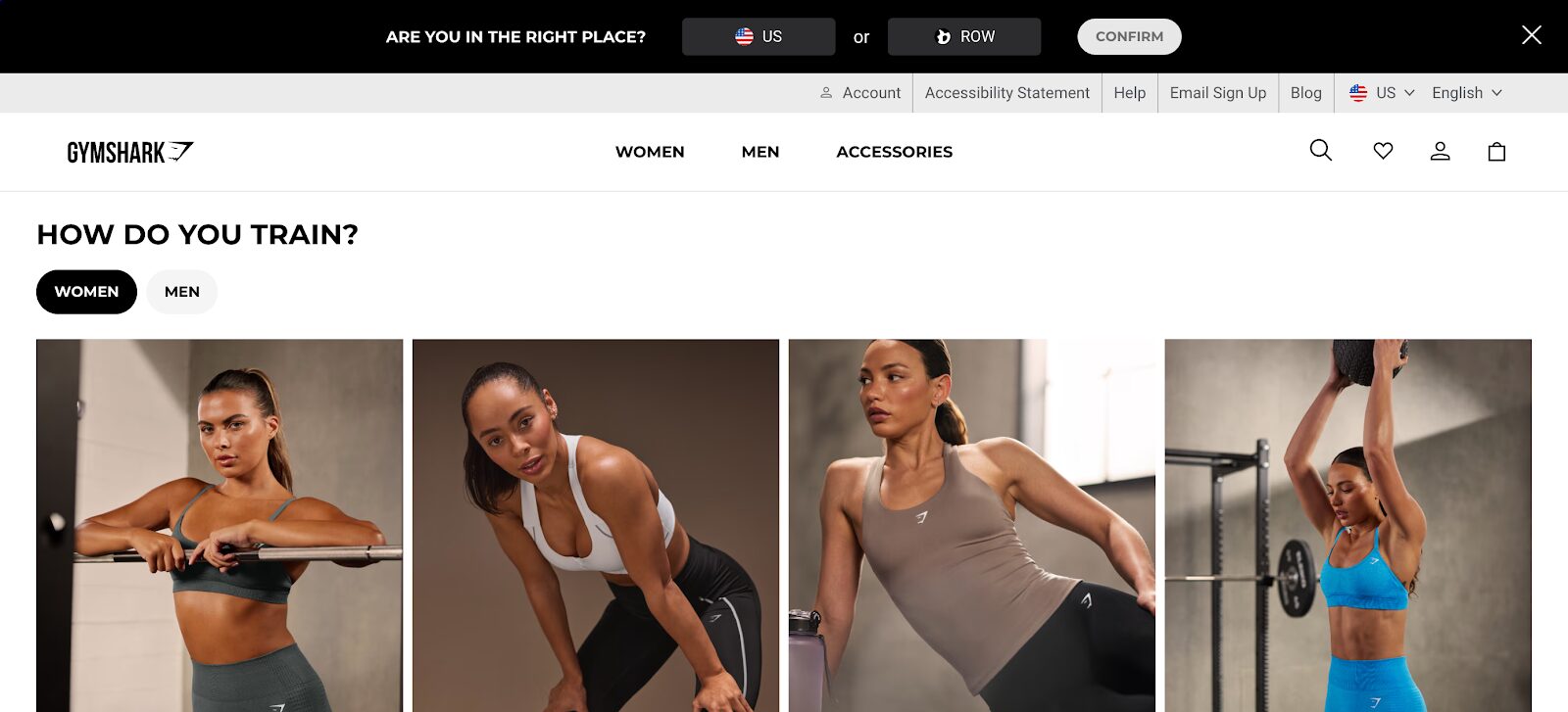
Additionally, their dynamic shipping bar changes depending on promotions, offering a personalized experience with relevant discounts and offers.
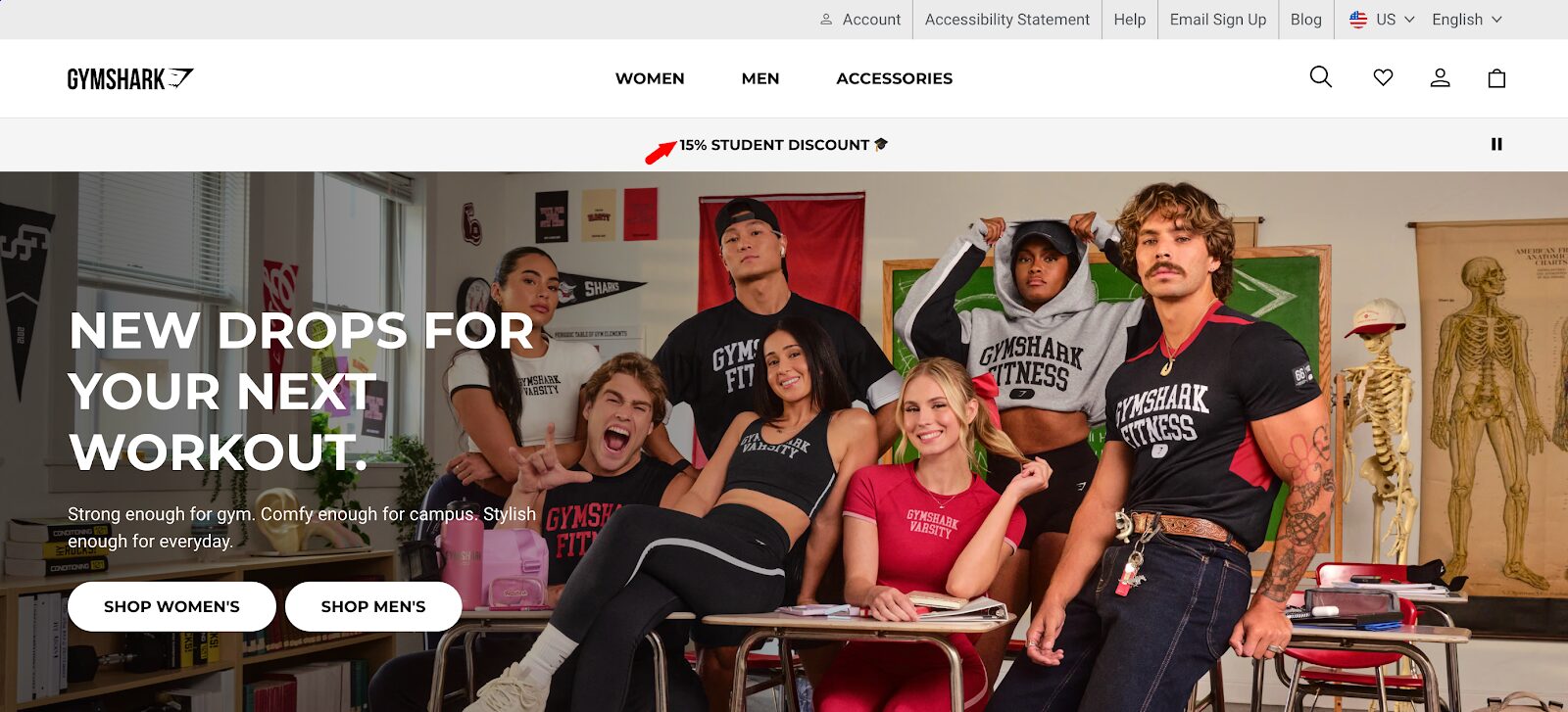
What we love:
- Clear destination selector that helps customers find what they’re looking for quickly
- Dynamically changing shipping bar that highlights various offers and promotions
- The ability to shop based on specific fitness goals, making the shopping experience more tailored
Unlock the key to Gymshark’s success, read it now!
9. Stanley
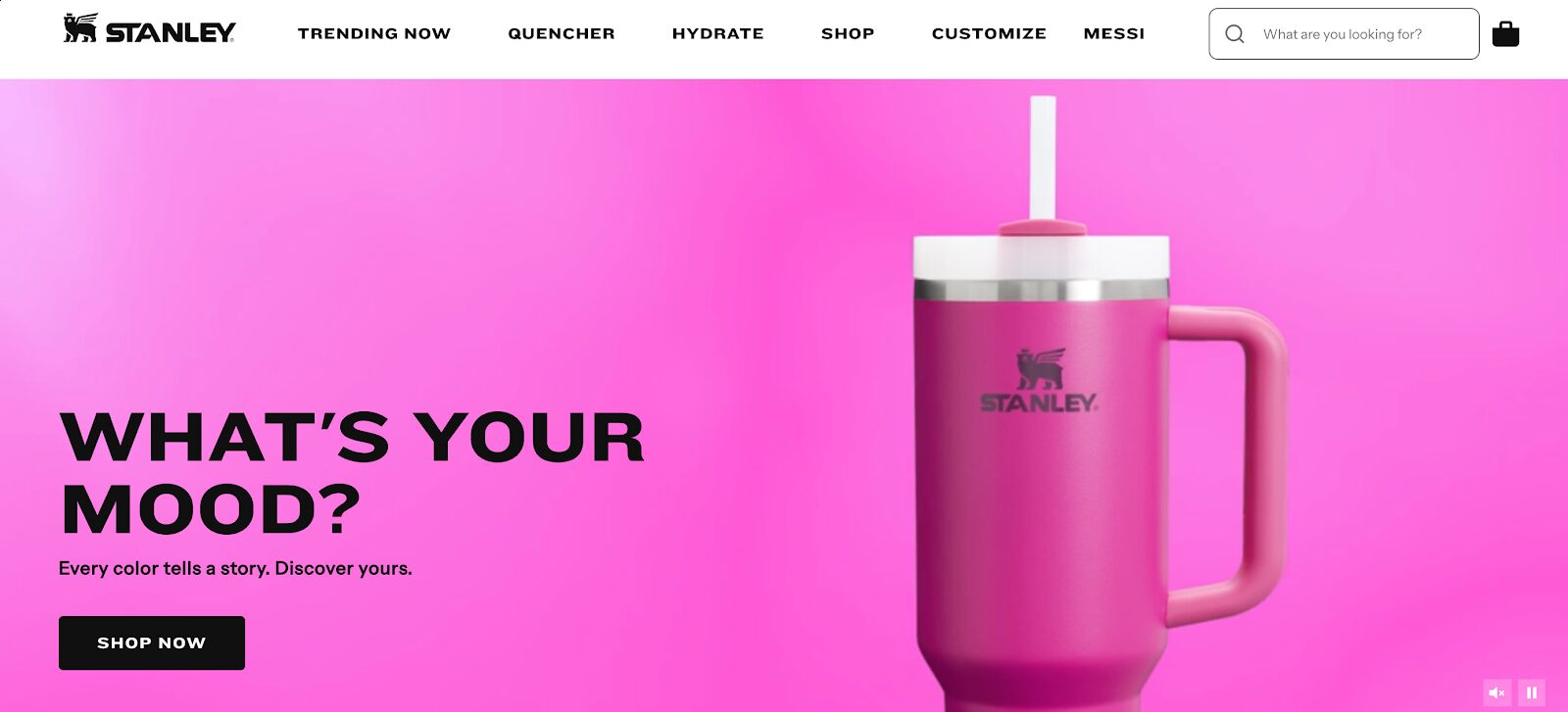
Stanley has one of the best ecommerce websites, with a perfect blend of simplicity and playfulness.
The “Stanley Favorites” section helps users discover popular products quickly…

…while the dynamic shipping bar keeps visitors informed about the latest promotions.

The clean, uncluttered design makes navigation a breeze, allowing users to easily explore the brand’s range of products.
What we love:
- Simple, fun design that aligns with the brand’s personality
- The “Stanley Favorites” section for quick access to popular items
- A dynamically changing shipping bar that keeps users engaged with current offers
Watch as we break down Stanley’s success:
10. The Body Shop
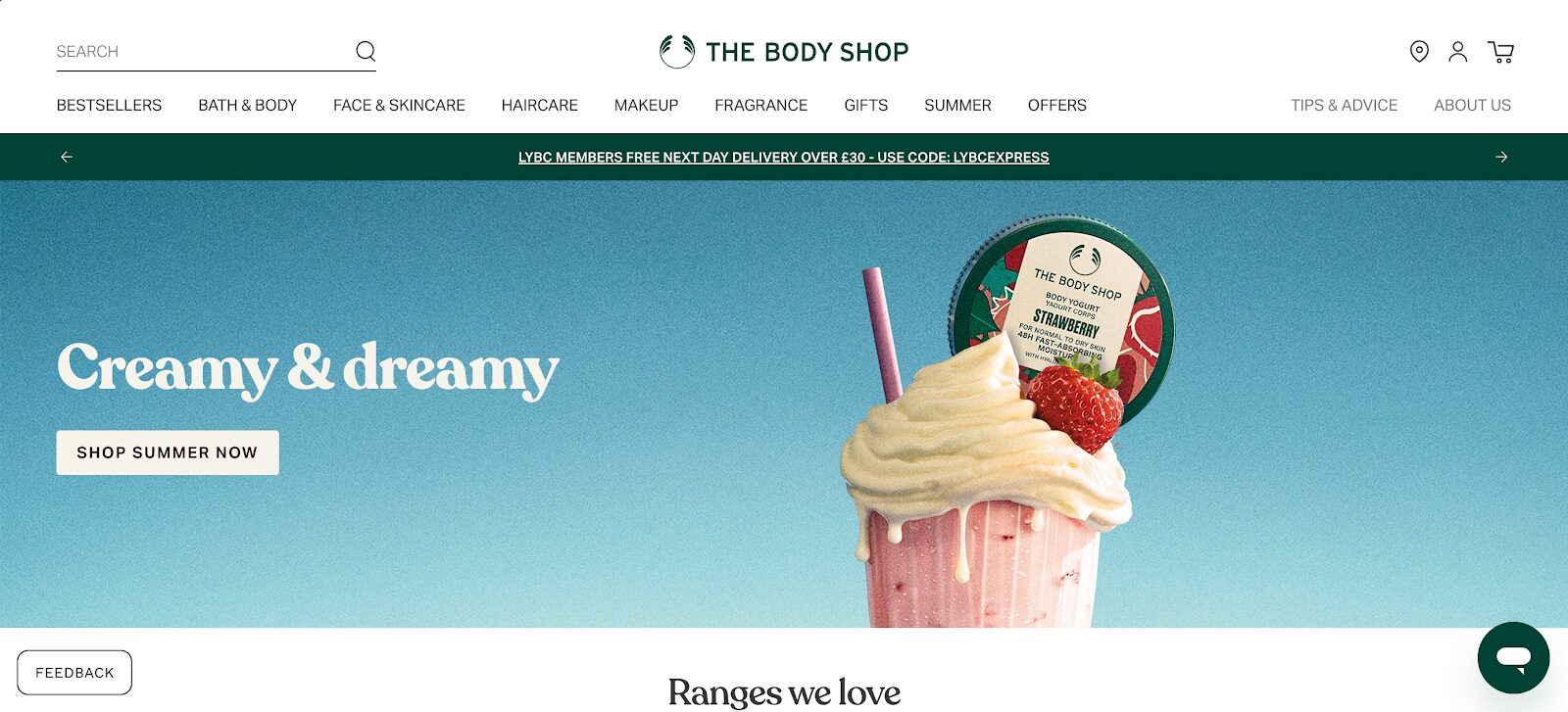
The Body Shop’s website design reflects the brand’s commitment to natural, ethical products. The homepage features beautiful seasonal product photography that aligns with their eco-conscious ethos.
They also offer bundle discounts, encouraging users to purchase more.

Plus, the embedded Instagram feed adds a social proof element, showcasing real customers and increasing trust.
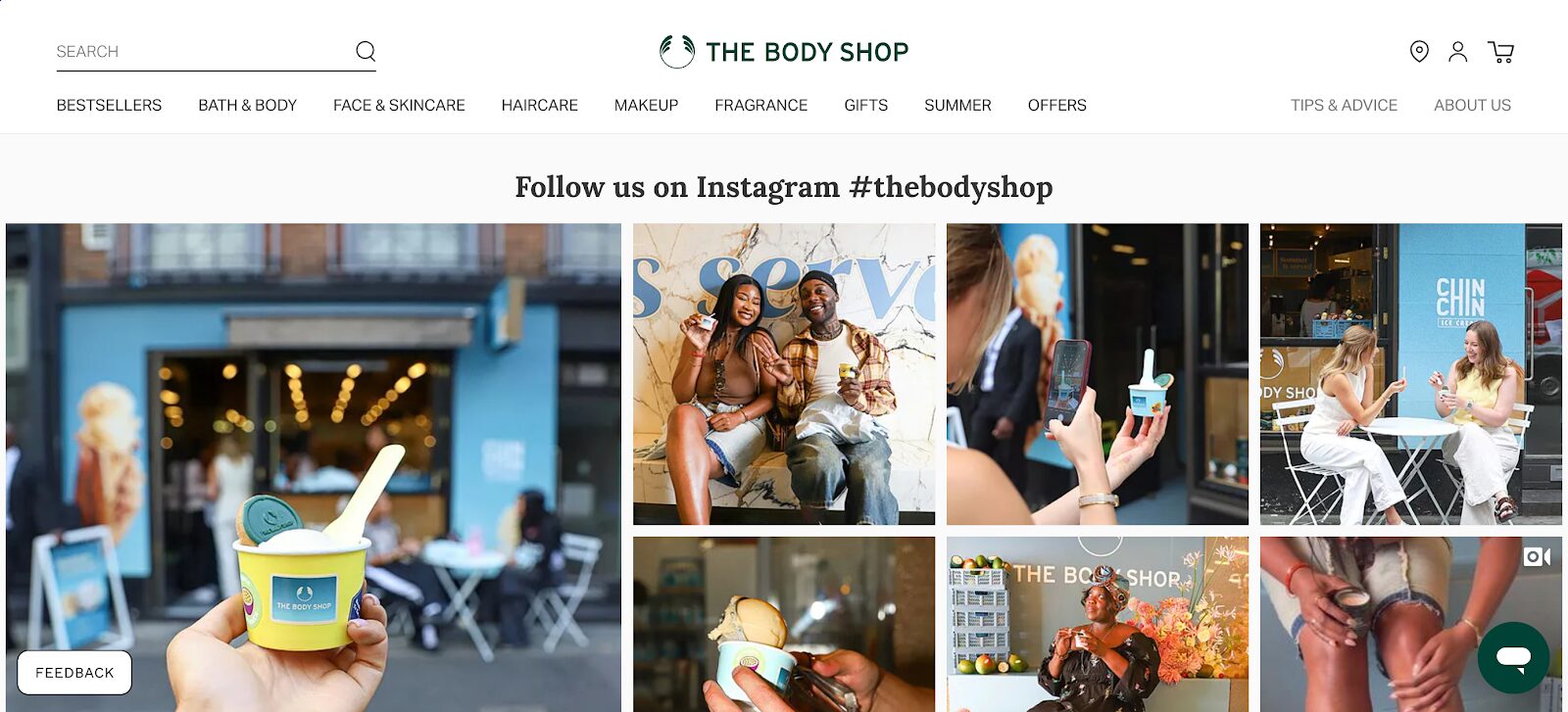
What we love:
- Bundle offerings that incentivize users to buy more
- Seasonal product photography that creates a cohesive brand image
- Embedded Instagram feed for added social proof and engagement
11. Rare Beauty

Rare Beauty, Selena Gomez’s makeup brand, stands out for its simple, sleek design. The website features a clear free shipping bar at the top, offering a discount once certain thresholds are met.
As you scroll, the product categories are easy to navigate, and the page layout helps you shop without feeling overwhelmed.

On each product page, you can shop the whole collection:
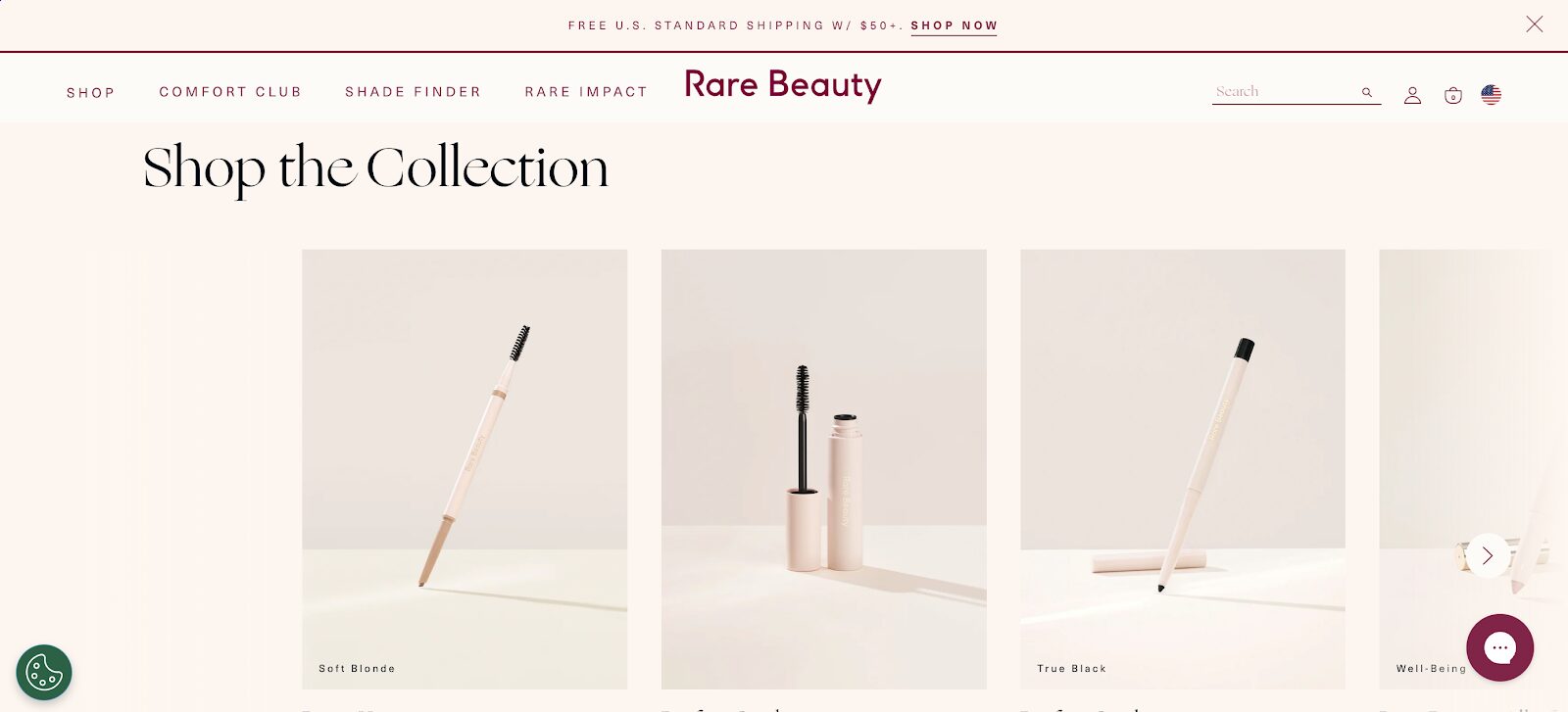
They also integrate user-generated content, allowing potential customers to see the products in action with before-and-after pictures.
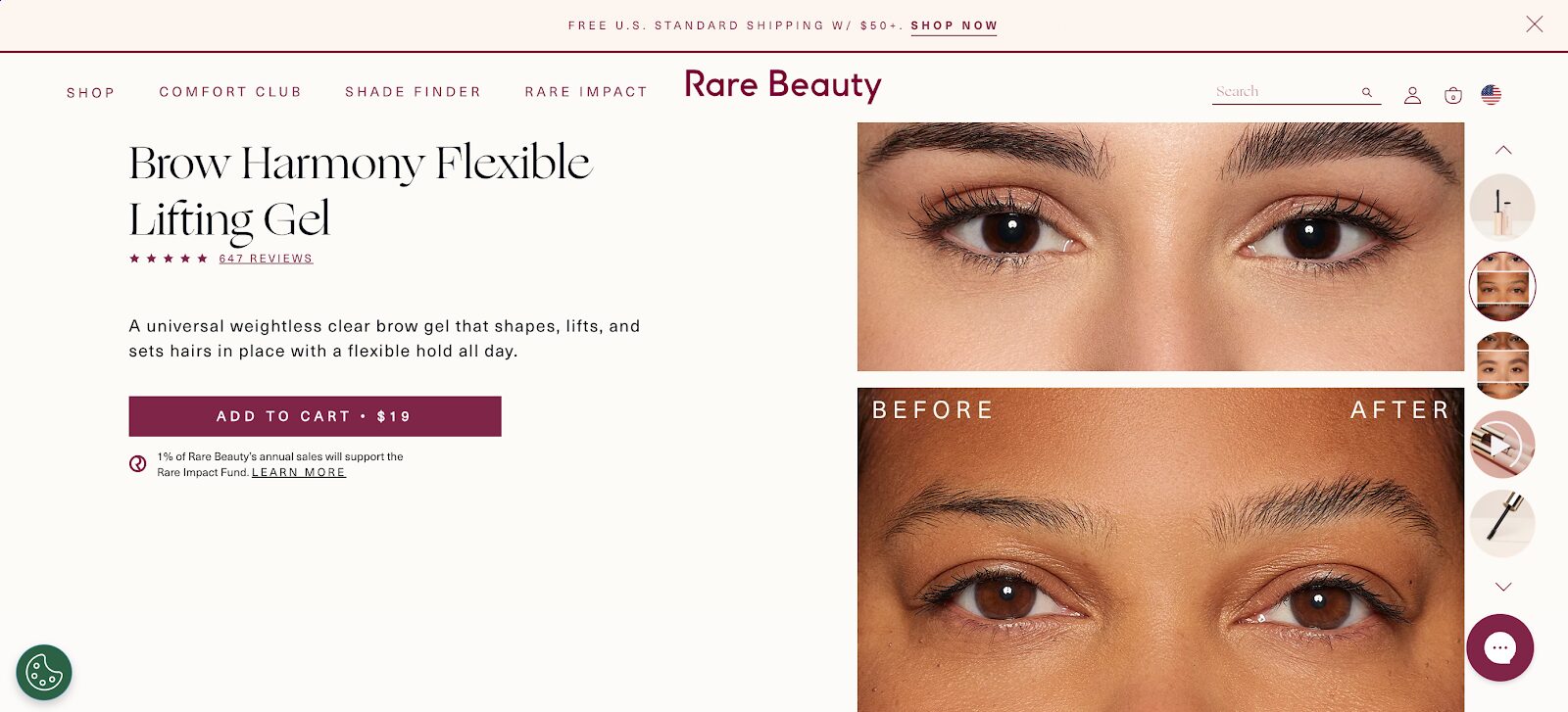
What we love:
- Clear, enticing free shipping bar that promotes sales
- User-generated content showcasing real results on product pages
- Easy-to-navigate product pages, creating a smooth shopping experience
12. Casper
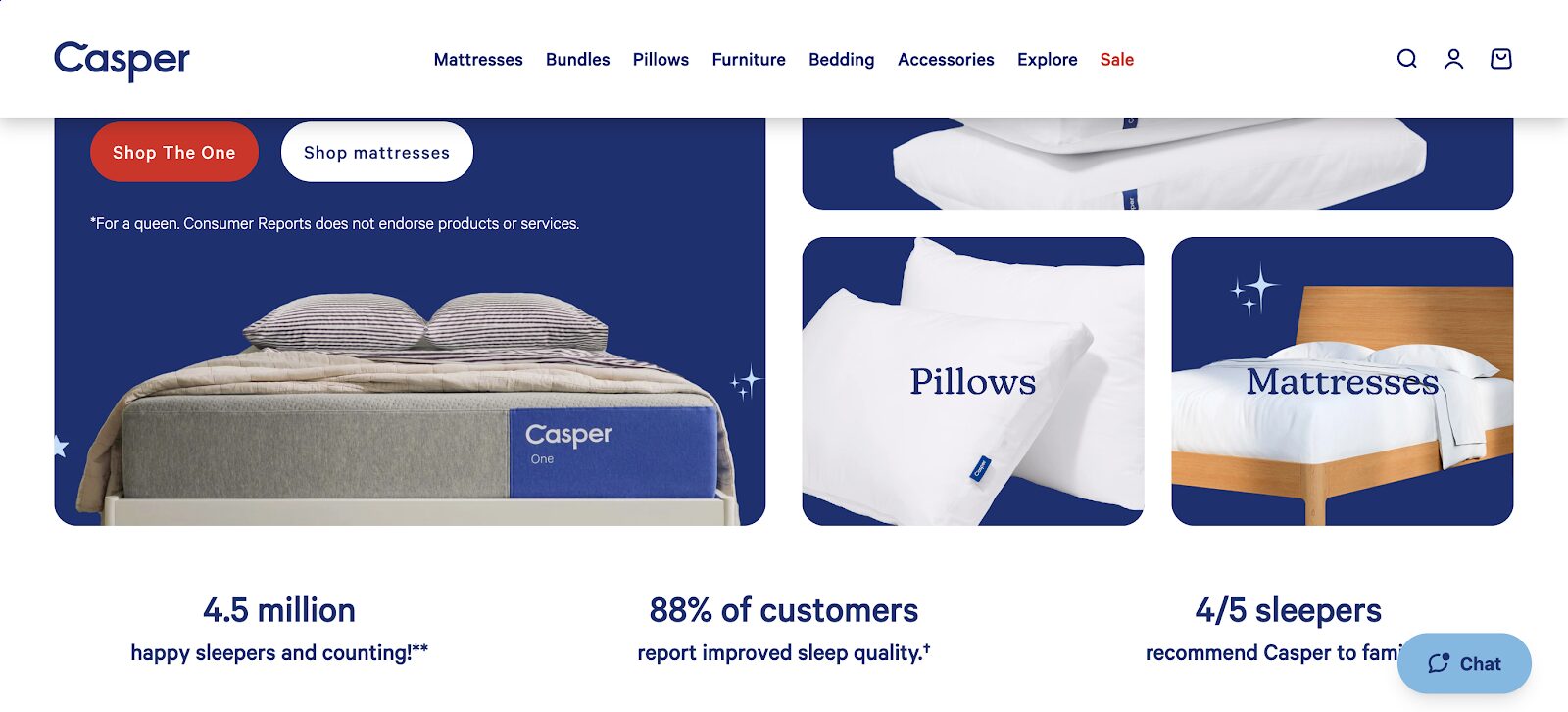
Casper’s mattress website focuses on trust-building elements, like social proof and payment flexibility. The site also clearly displays flexible payment options, making it more accessible to a wider audience.
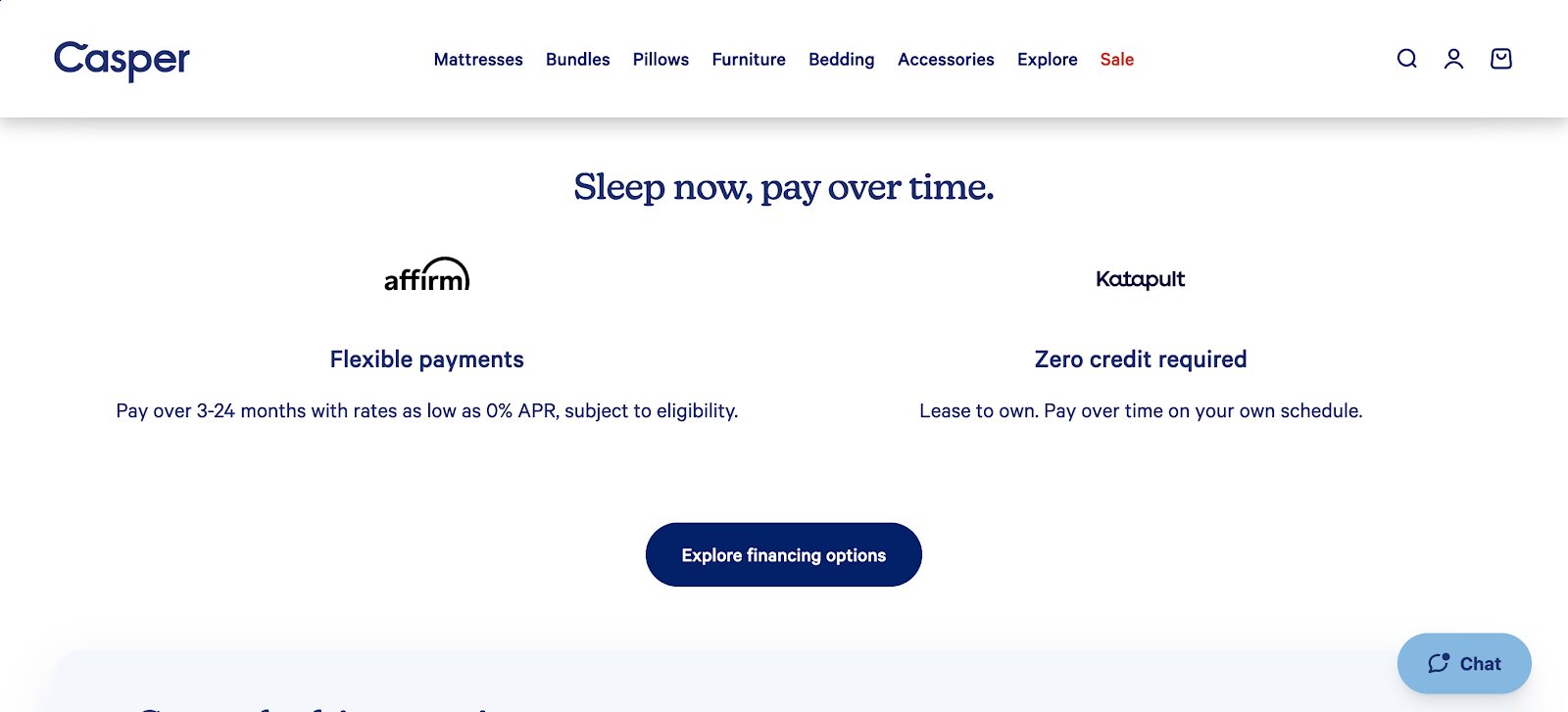
They showcase impressive customer reviews and highlight their happy sleepers, which helps potential buyers feel more confident in their decision.
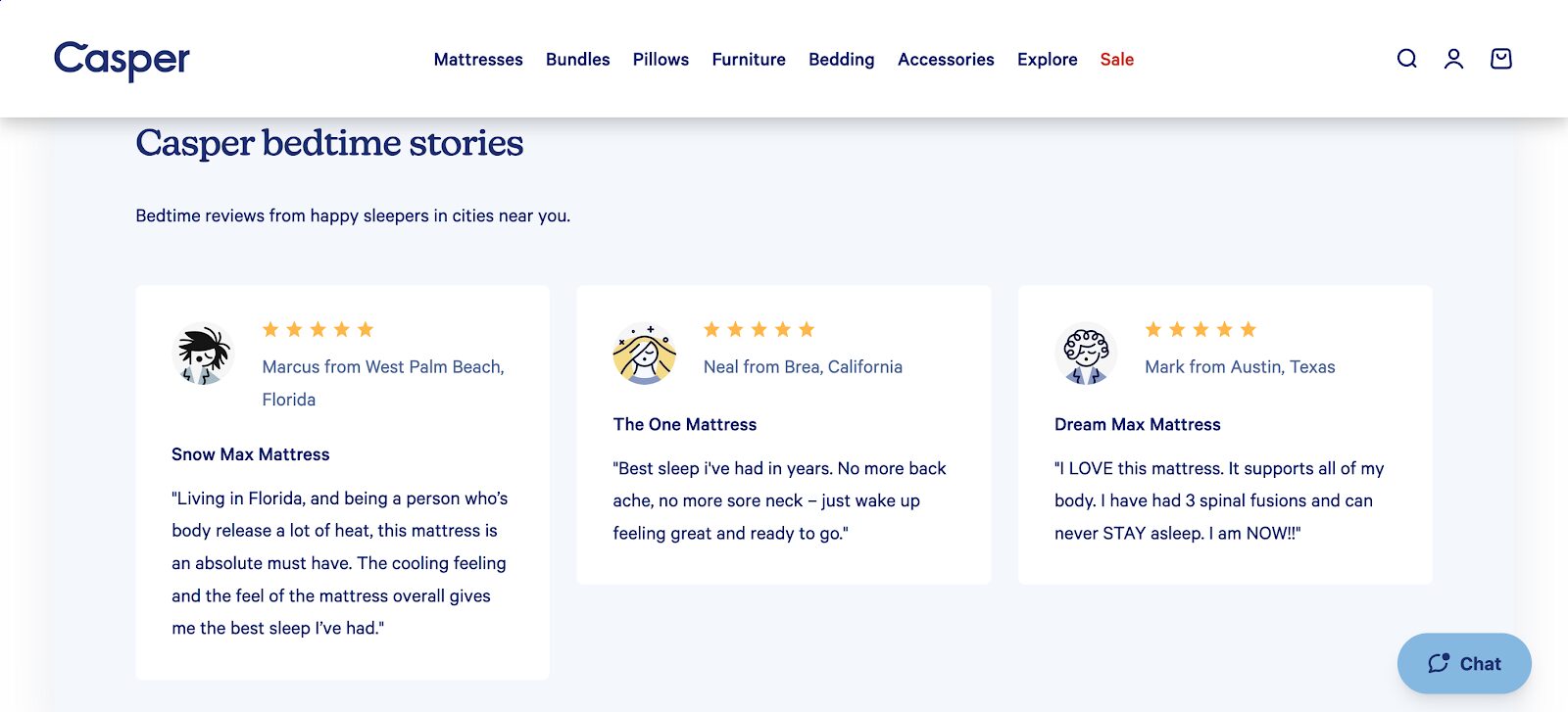
Their mattress quiz is another feature that helps customers select the best product for their needs.
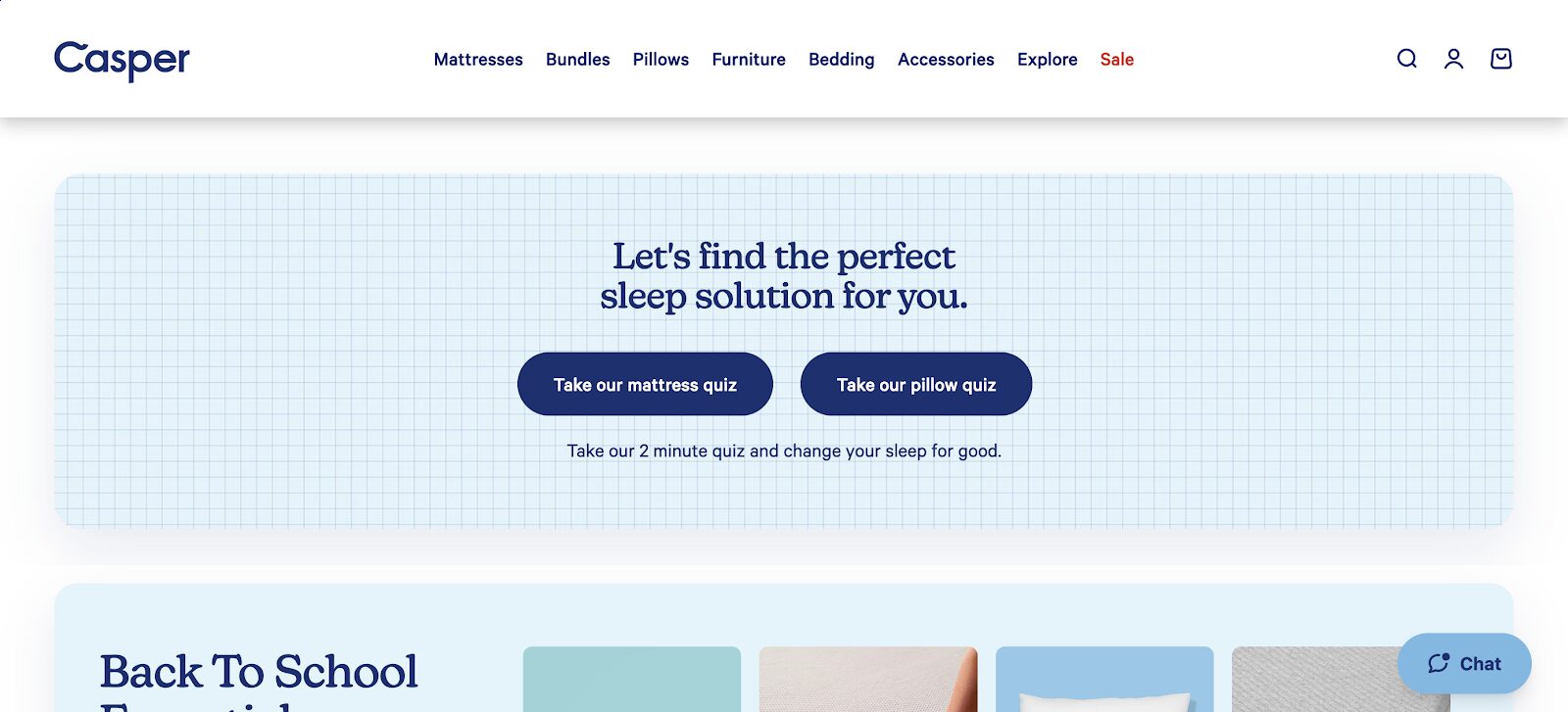
What we love:
- Customer reviews are prominently displayed to build trust
- Payment options are highlighted for greater transparency
- A helpful mattress quiz guides buyers in selecting the right product
Pro tip: Quiz popups are a great way to learn more about your target audience.
13. Sol de Janiero
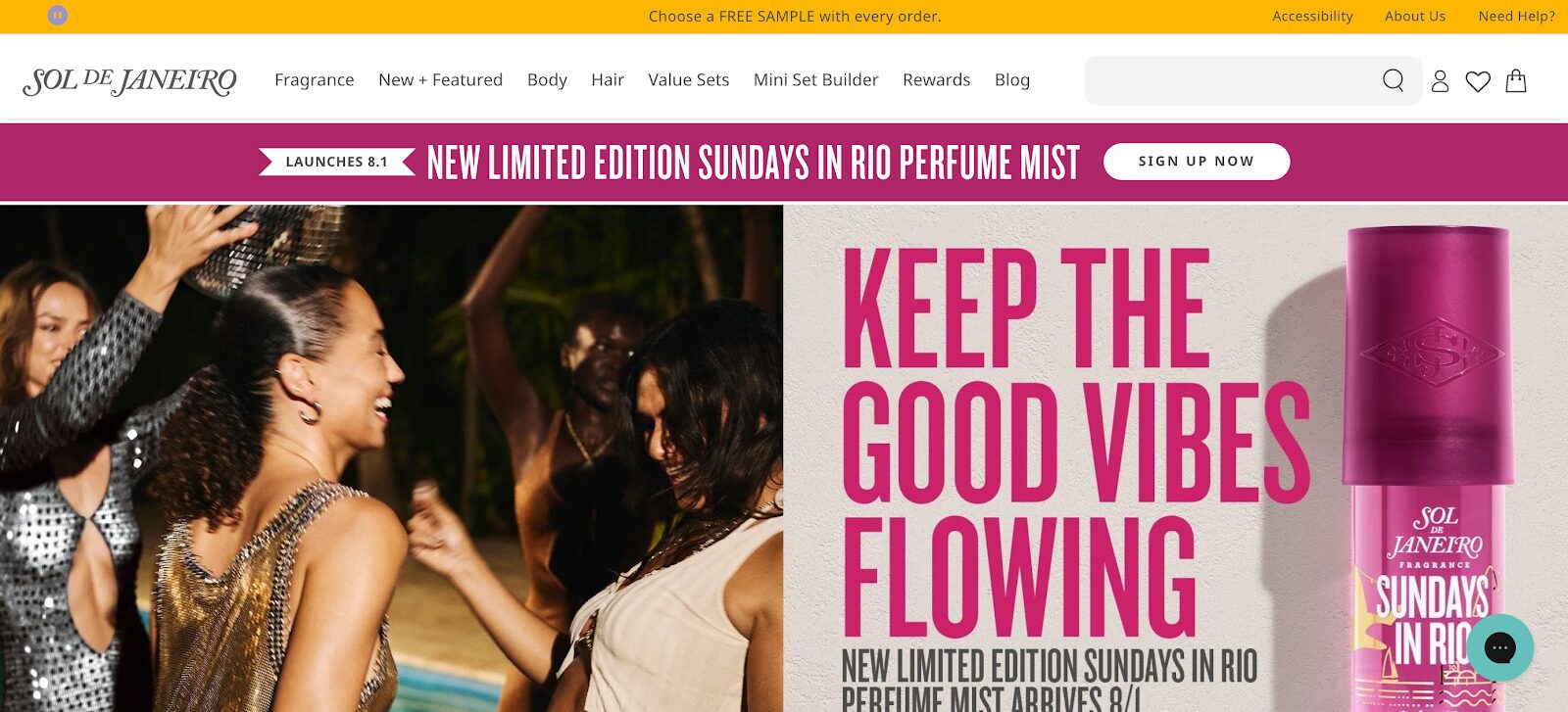
Sol de Janeiro’s website design is both inviting and energetic, just like their products. On the homepage, they promote limited-time drops, creating a sense of urgency.
They also display new arrivals and bestsellers clearly, so visitors know where to start shopping…
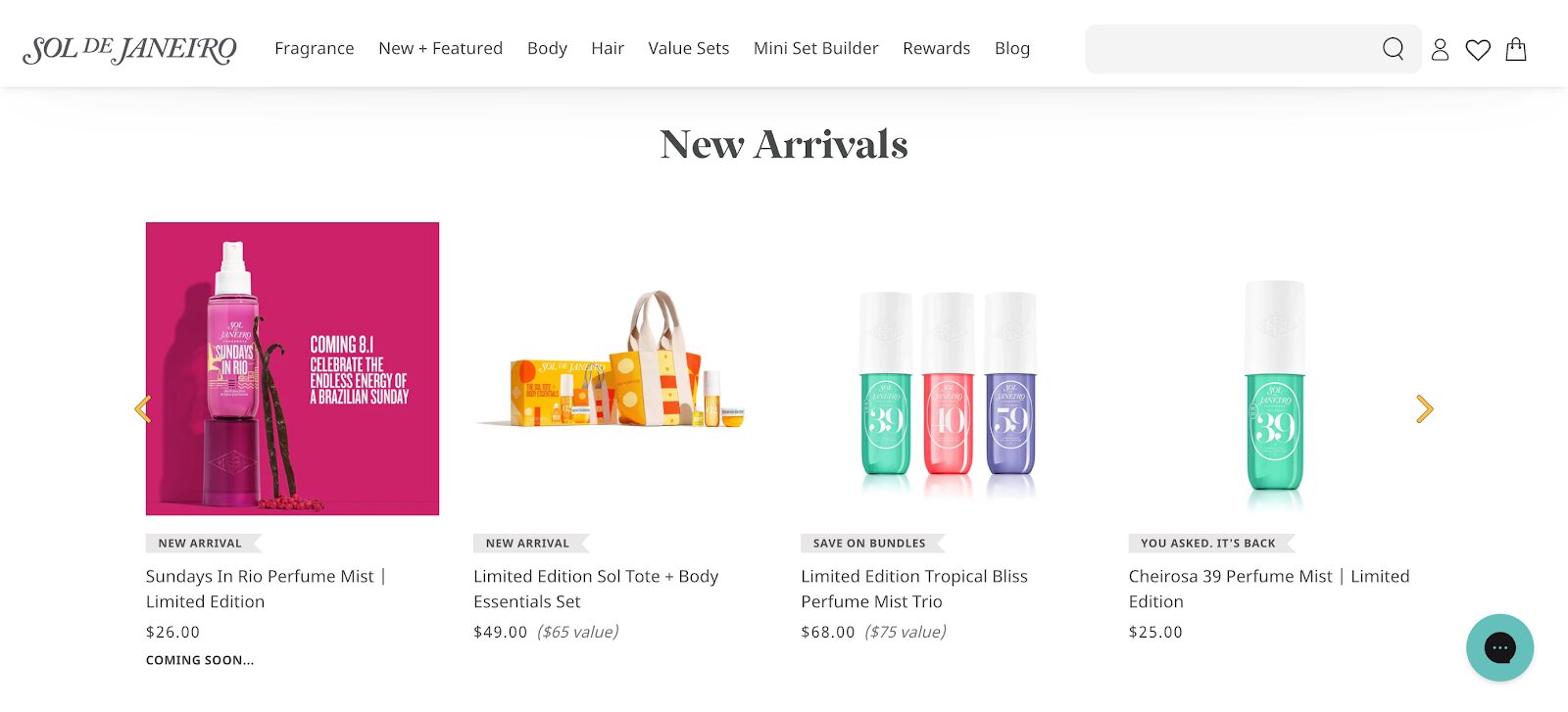
…and all the available perks:
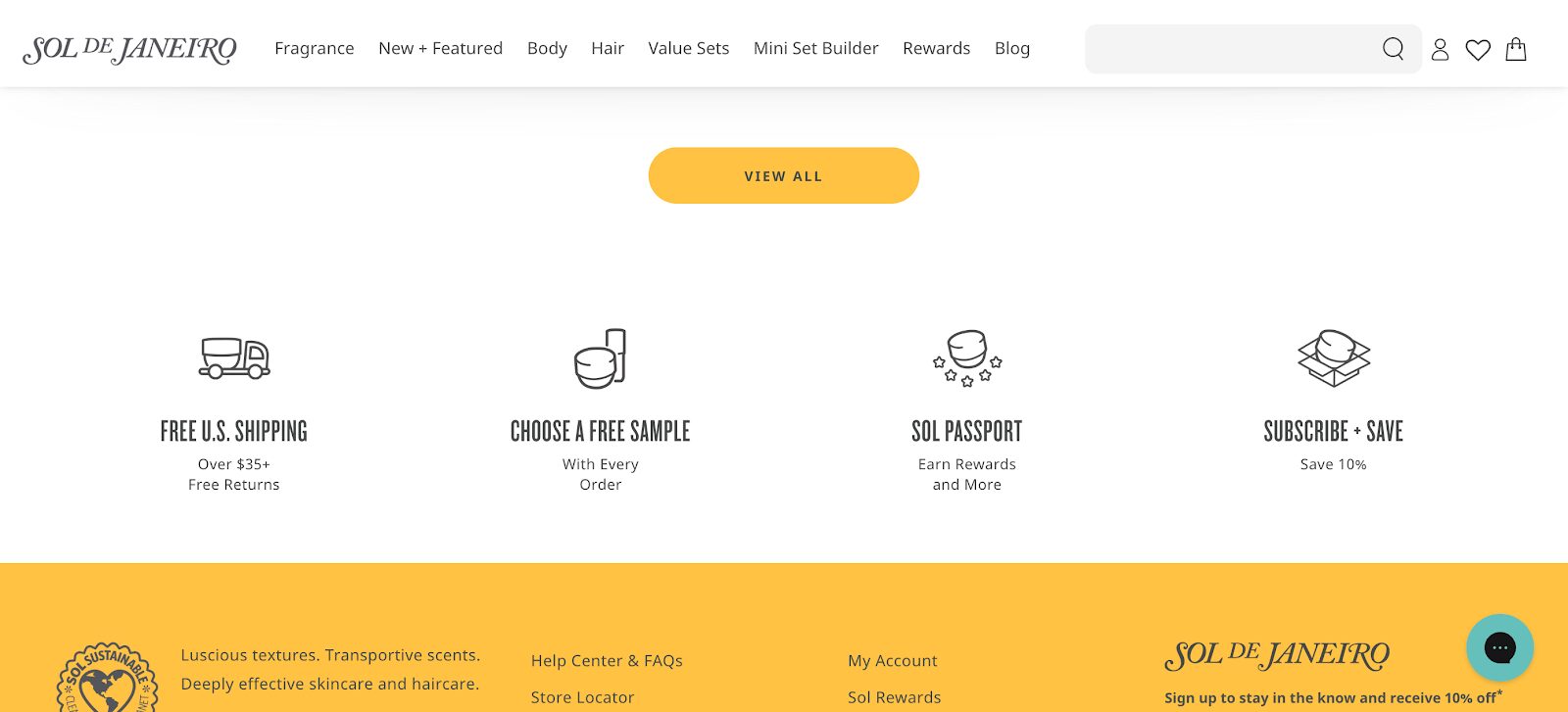
The simple design helps customers easily navigate through product categories without getting distracted.
What we love:
- Limited-time product drops create a sense of urgency
- New arrivals are promoted in a straightforward, eye-catching way
- Clean, simple design focuses on top-selling products
14. Liquid Death
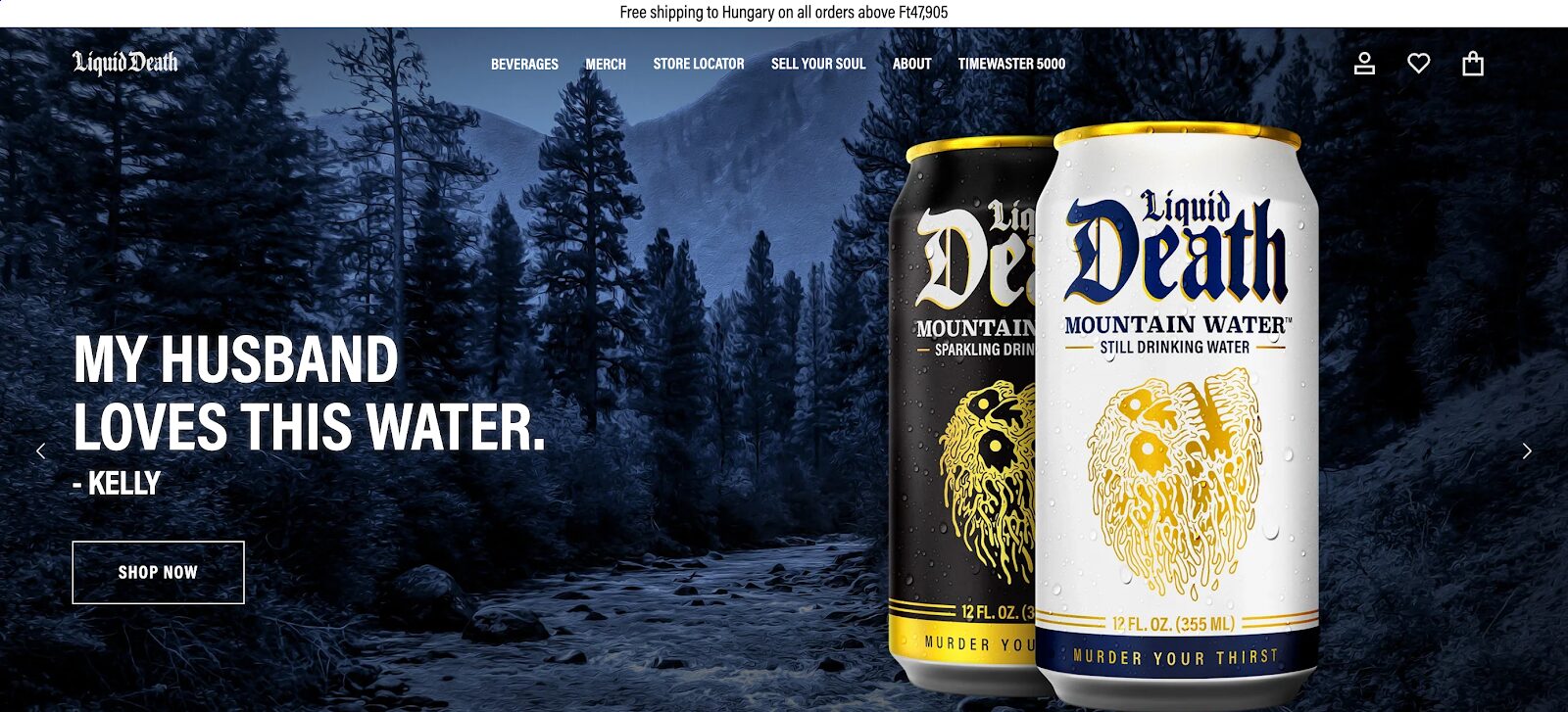
Liquid Death’s website is bold and straightforward, with a carousel-style home page that immediately grabs attention.
The fun copy, like “my husband loves this water,” creates a unique, edgy tone that resonates with the brand’s rebellious image.
As you scroll down, products are presented clearly under an on-brand headline: “Murder Your Thirst.”
This brand effectively showcases how creativity and edge can enhance the user experience and streamline the shopping journey.
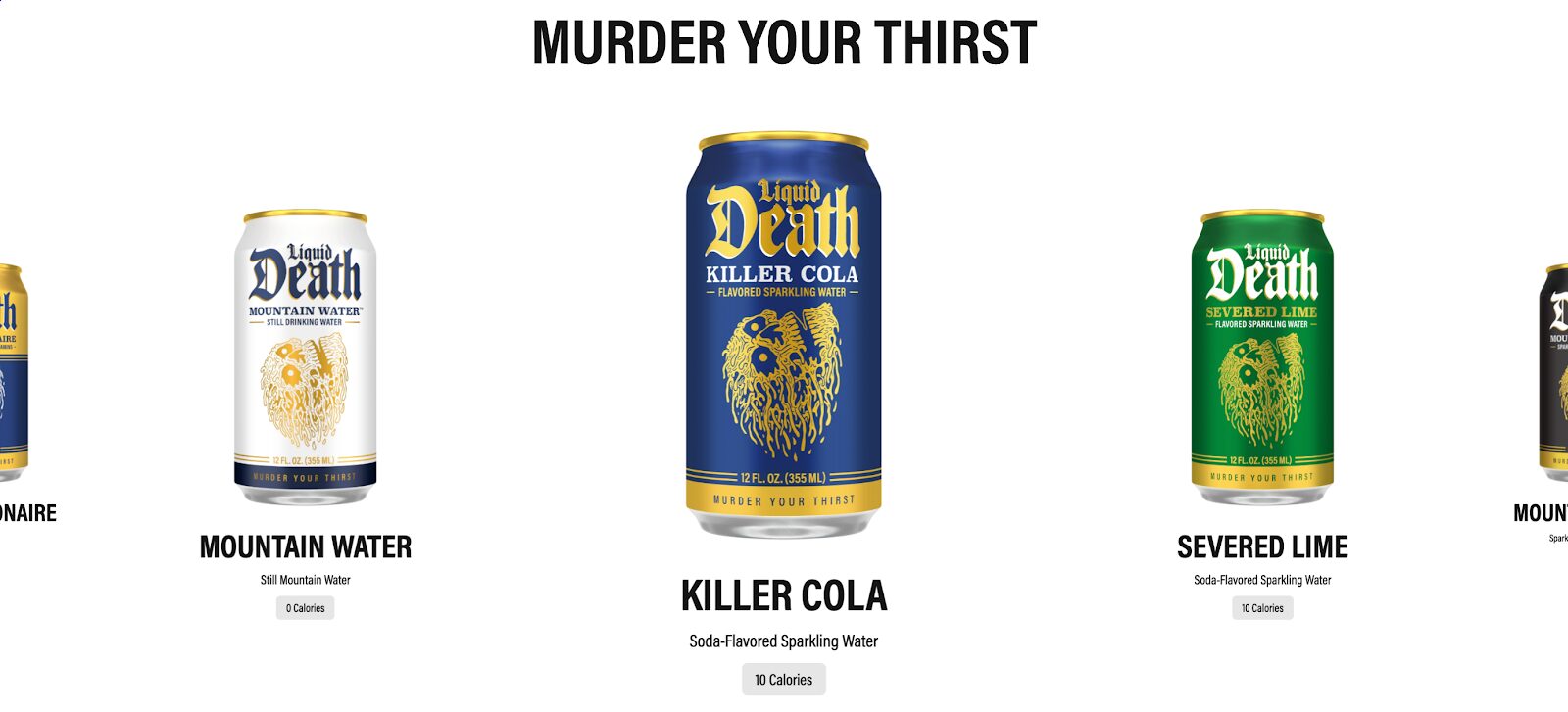
Their footer offers easy access to their newsletter sign-up and social media links.
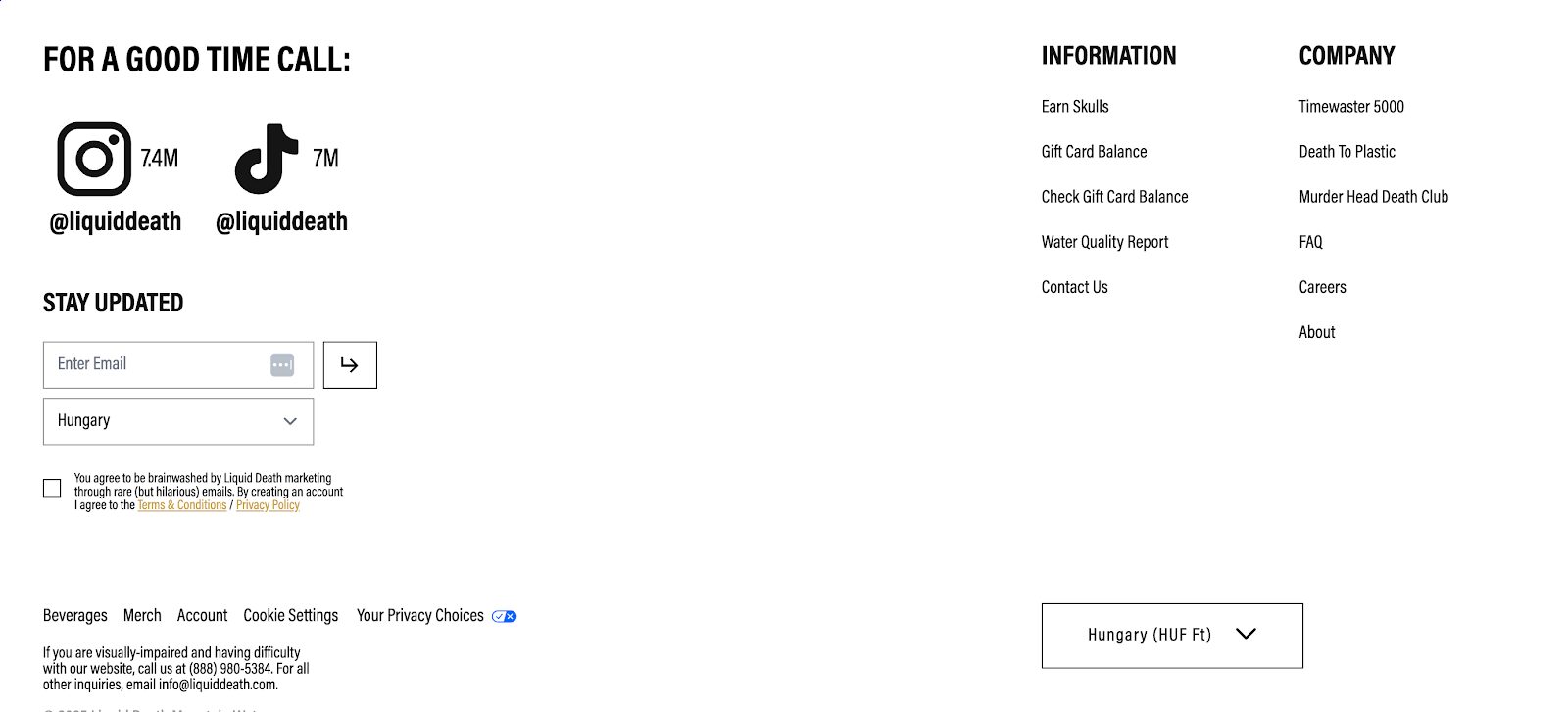
What we love:
- Fun, impactful copy that fits the brand’s personality
- Simple yet effective design that doesn’t overwhelm the visitor
- Clear call-to-action buttons and footer for quick navigation
15. Mejuri

Mejuri’s fine jewelry ecommerce website is as elegant as its products. The homepage allows users to shop by category, and just below, there’s a “trending” section that showcases the top 15 trending products.
The product pages are designed to create urgency, featuring a “back in stock” section and a “limited quantity” message, prompting customers to act quickly.
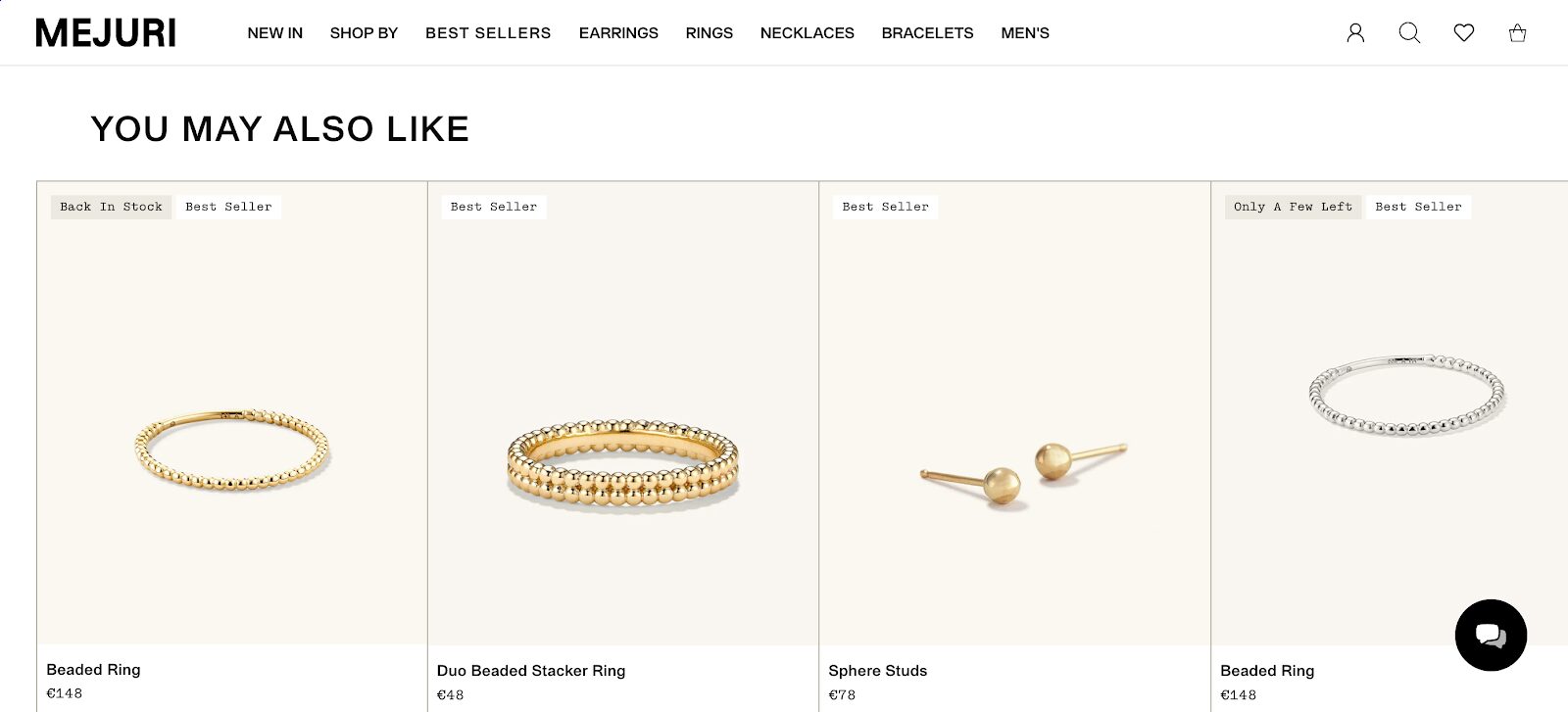
What we love:
- Easy-to-navigate homepage with well-defined categories
- Urgency messages like “only a few left” to drive immediate action
- A “You May Also Like” section that encourages customers to keep shopping
16. Fenty Beauty
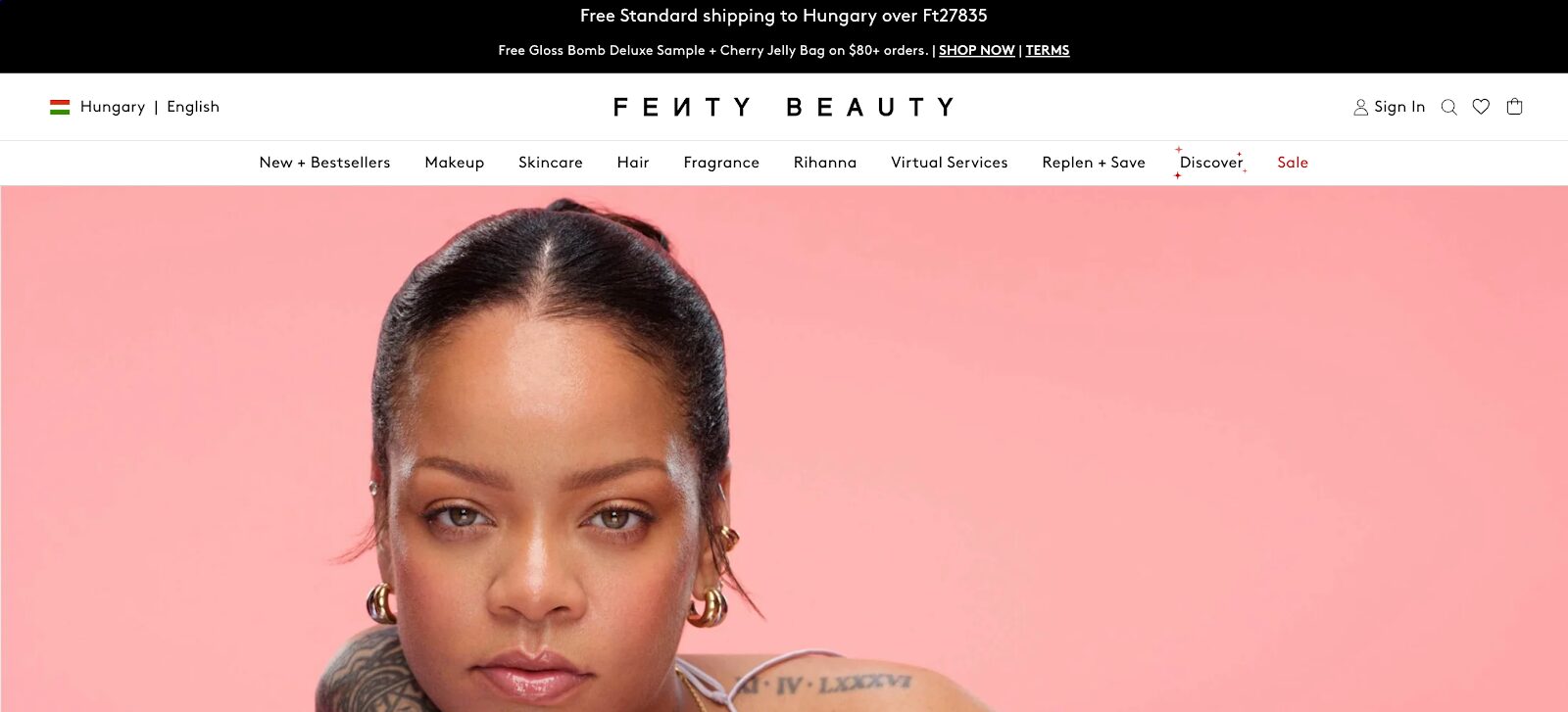
Rihanna’s Fenty Beauty website design is sleek and intuitive, beginning right at the top with a free shipping bar that gives visitors details on the threshold for free shipping.
The homepage features trending products and the latest collections.
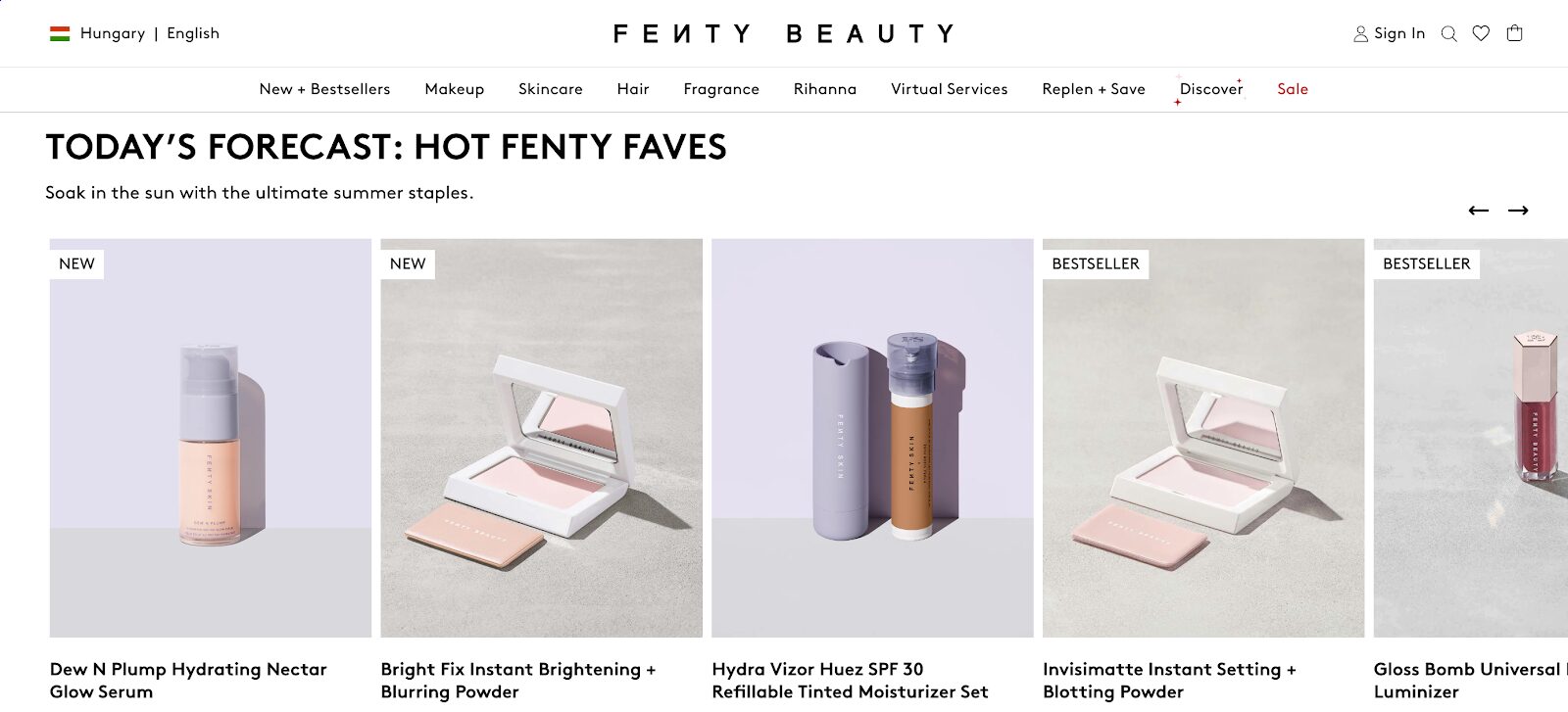
They feature user-generated content on product pages, giving potential buyers a real-world view of how the products work.
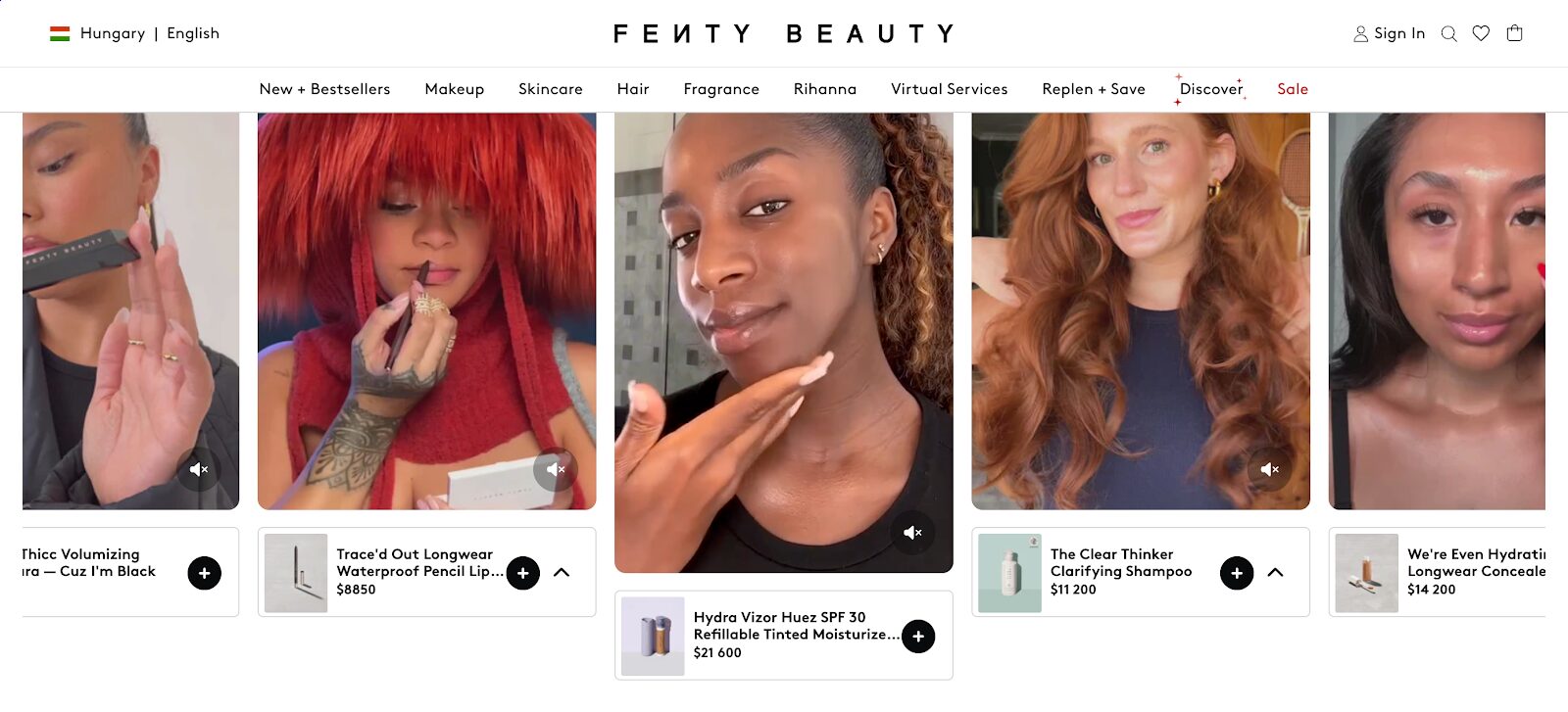
What we love:
- Free shipping bar with clear, actionable information
- User-generated content featured on product pages
- Effective use of before-and-after images for product demonstration
17. Boll & Branch
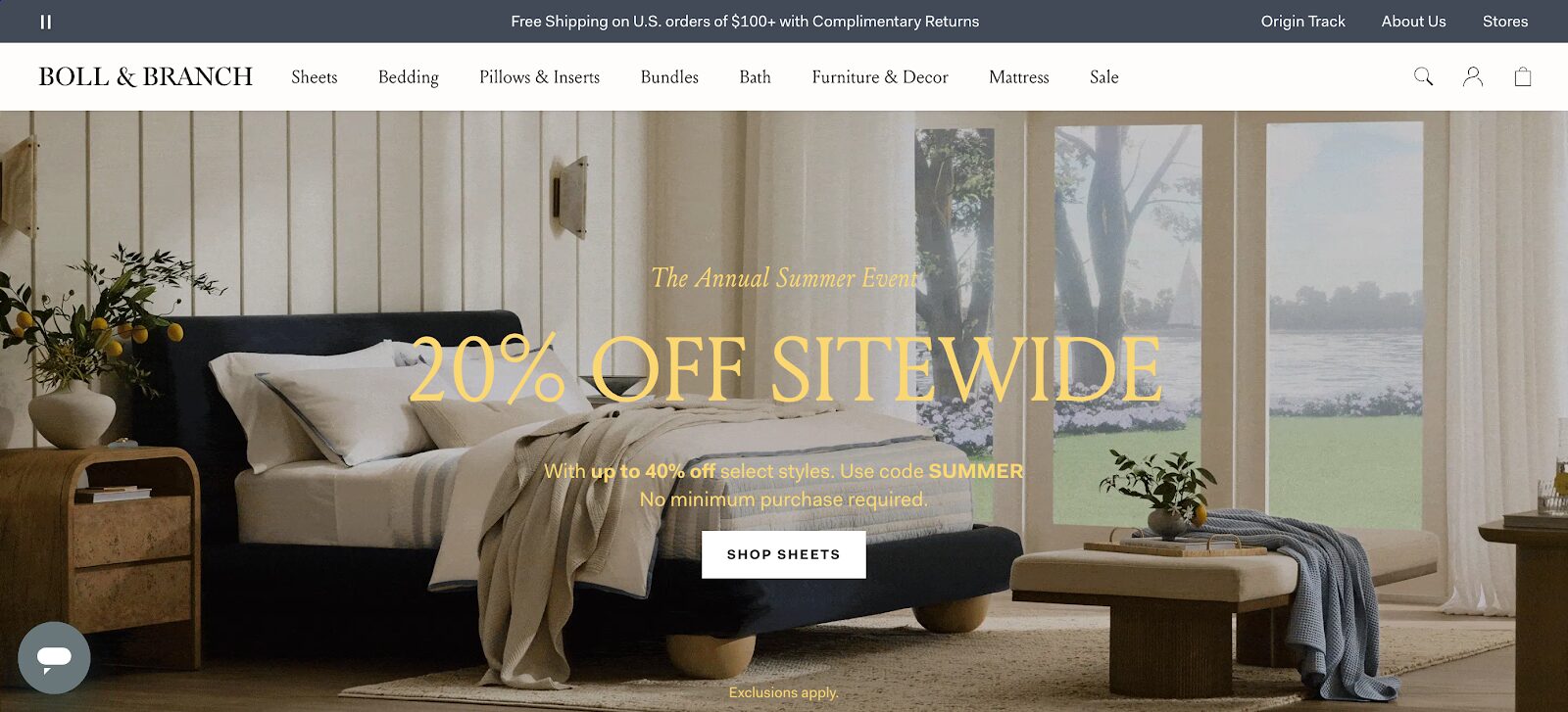
Boll & Branch, a premium bedding brand, begins with a fullscreen popup that matches the brand’s high-end aesthetic.
It’s easy to dismiss, and once closed, users are introduced to beautiful product photography and clear pricing.
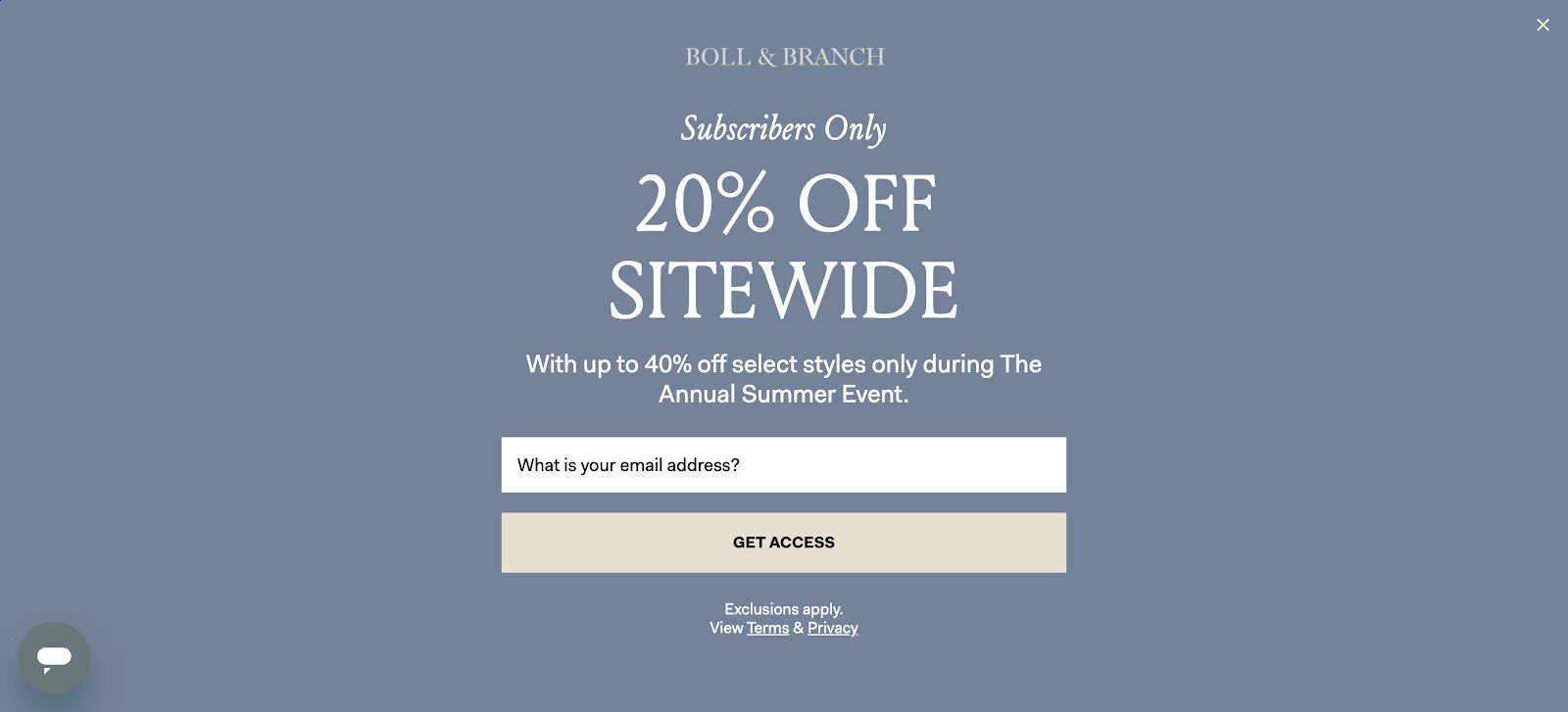
They also present their customer reviews in a unique, sophisticated way.
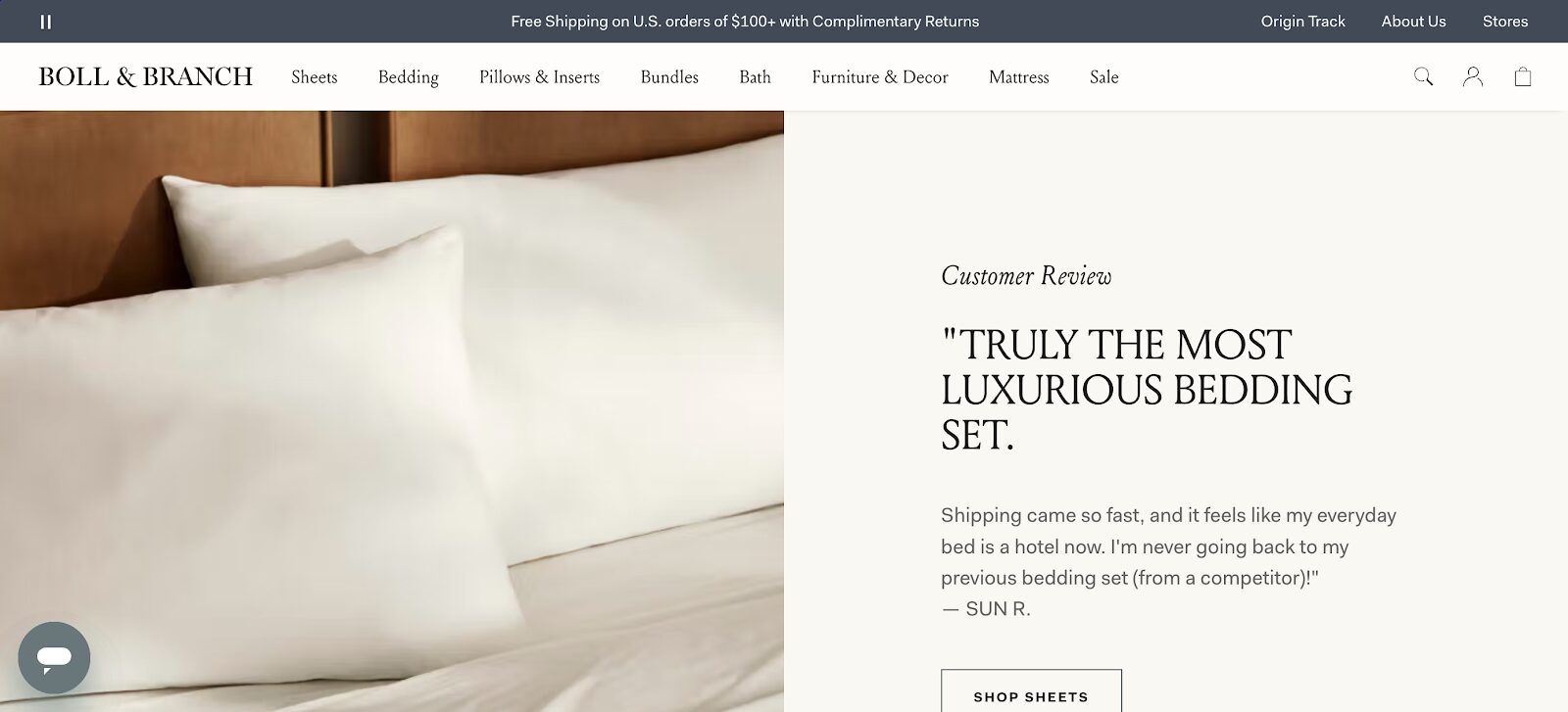
They provide color-based shopping with high-quality photos, which further simplifies the user journey.
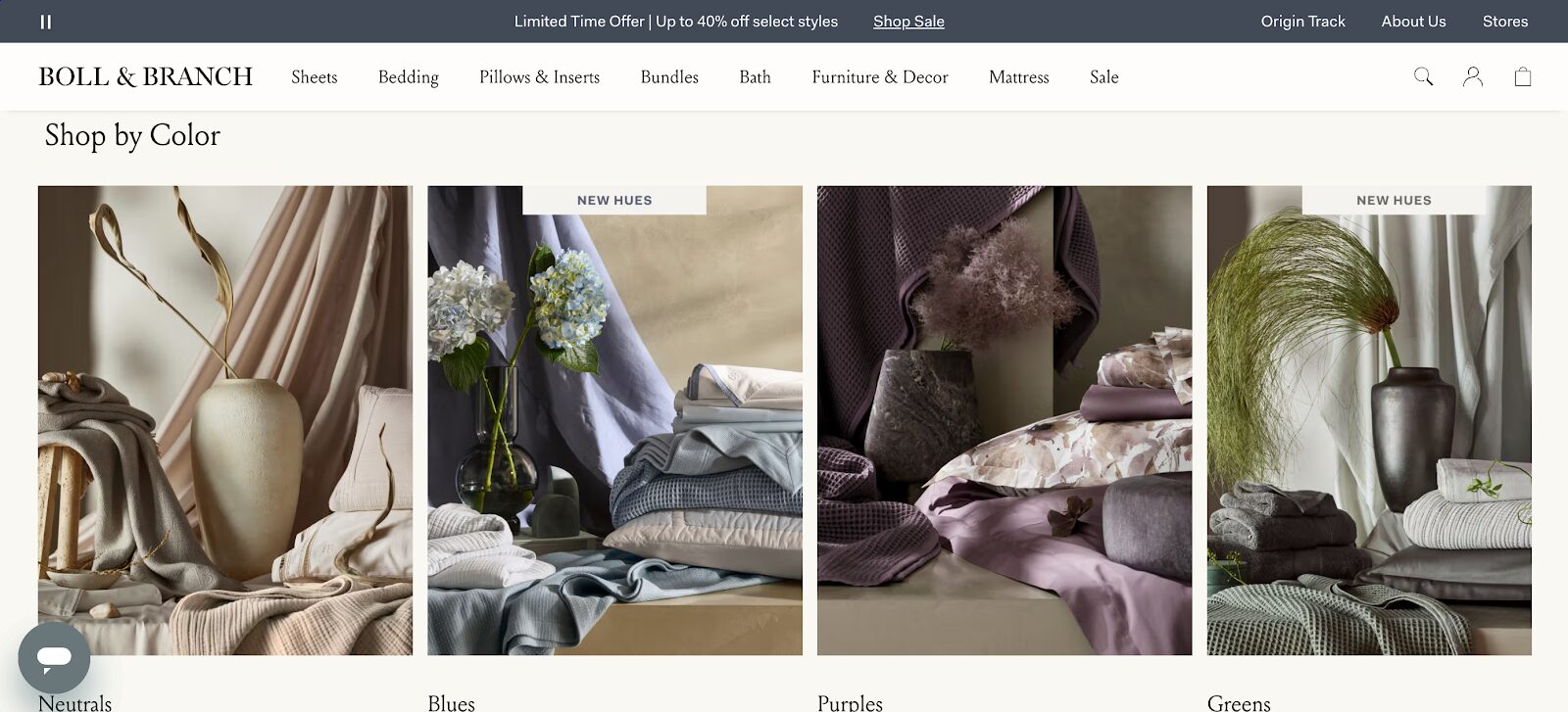
What we love:
- Fullscreen popup that enhances brand aesthetics while offering a seamless exit option
- Beautiful product photos that allow users to see the quality of the items
- Color-based shopping for easy filtering and an intuitive shopping experience
Pro tip: Full-screen popups are an excellent way for online businesses to engage with customers. Just make sure to prominently display an “X” for easy opt-out, so you don’t risk annoying your visitors.
18. Rhode Skin
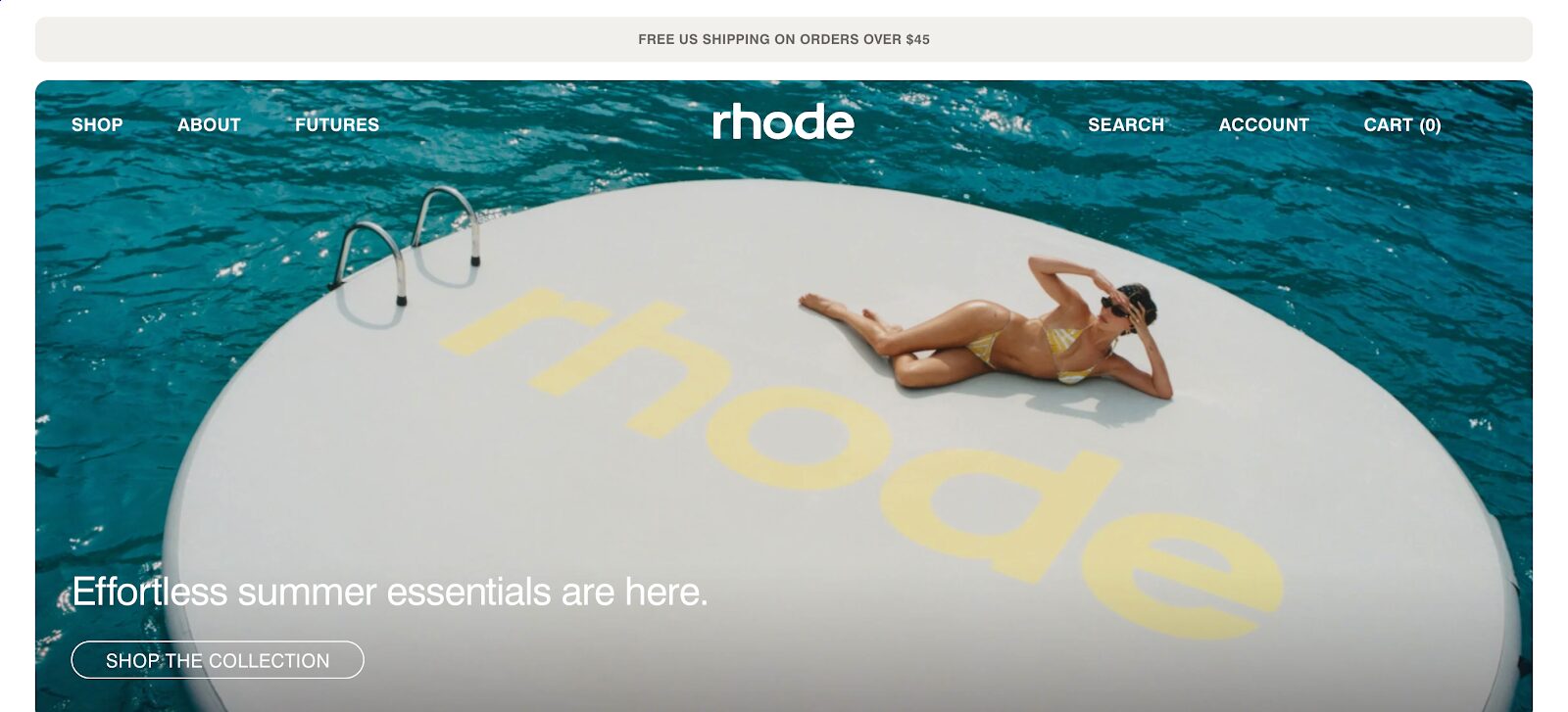
Rhode Skin, Hailey Bieber’s skincare brand, uses a neutral color palette with pops of brighter hues to promote their products.
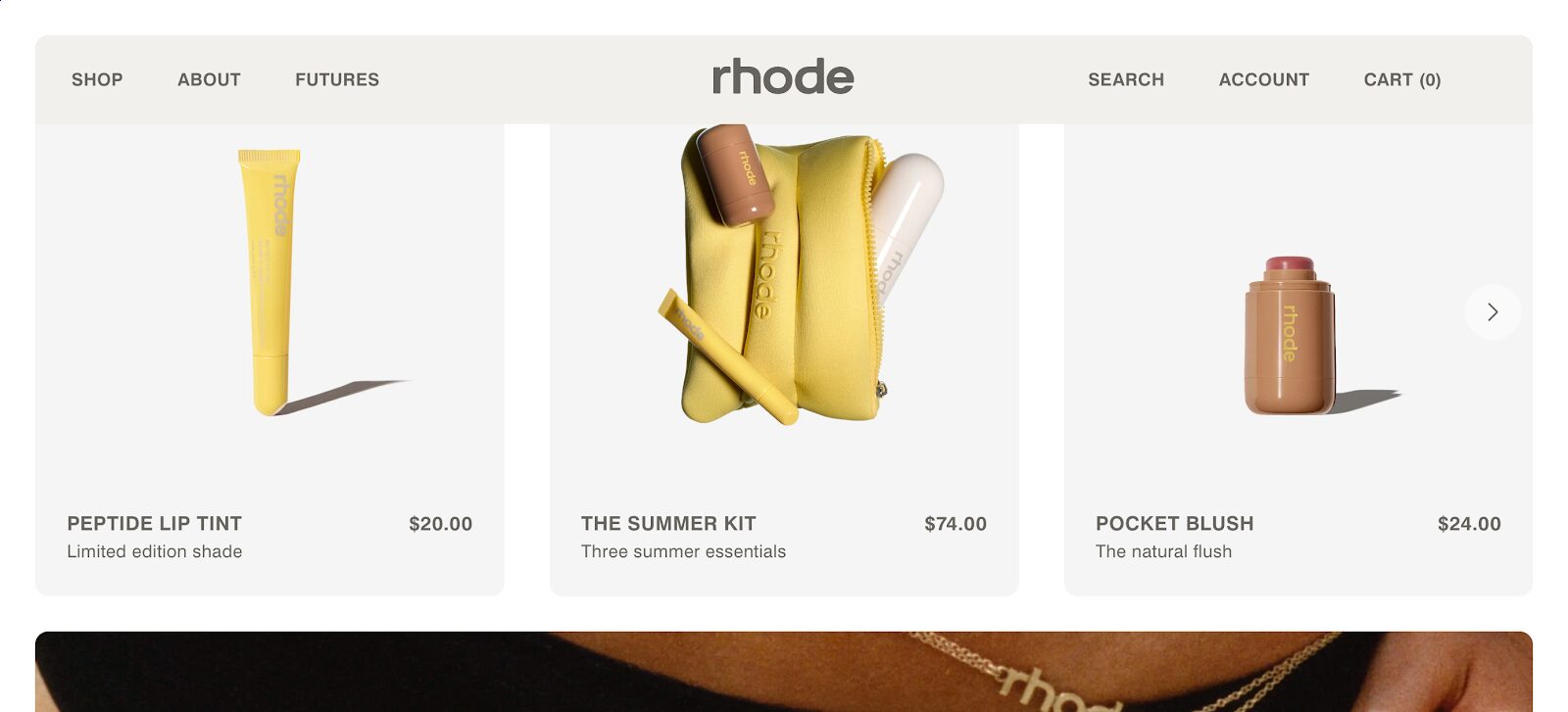
Their homepage features a mix of static and video content that showcases their products in action.

They also highlight product benefits and the application process, making it easier for customers to understand how to use the products effectively.
What we love:
- Bright, eye-catching design that aligns with the brand’s personality
- Video content that shows products in action
- Clear, detailed product pages that explain how to use the products
19. Ryze Mushroom Coffee
Ryze Mushroom Coffee’s website design is centered around trust and transparency. They feature large CTAs prominently, paired with 5-star reviews and a money-back guarantee.
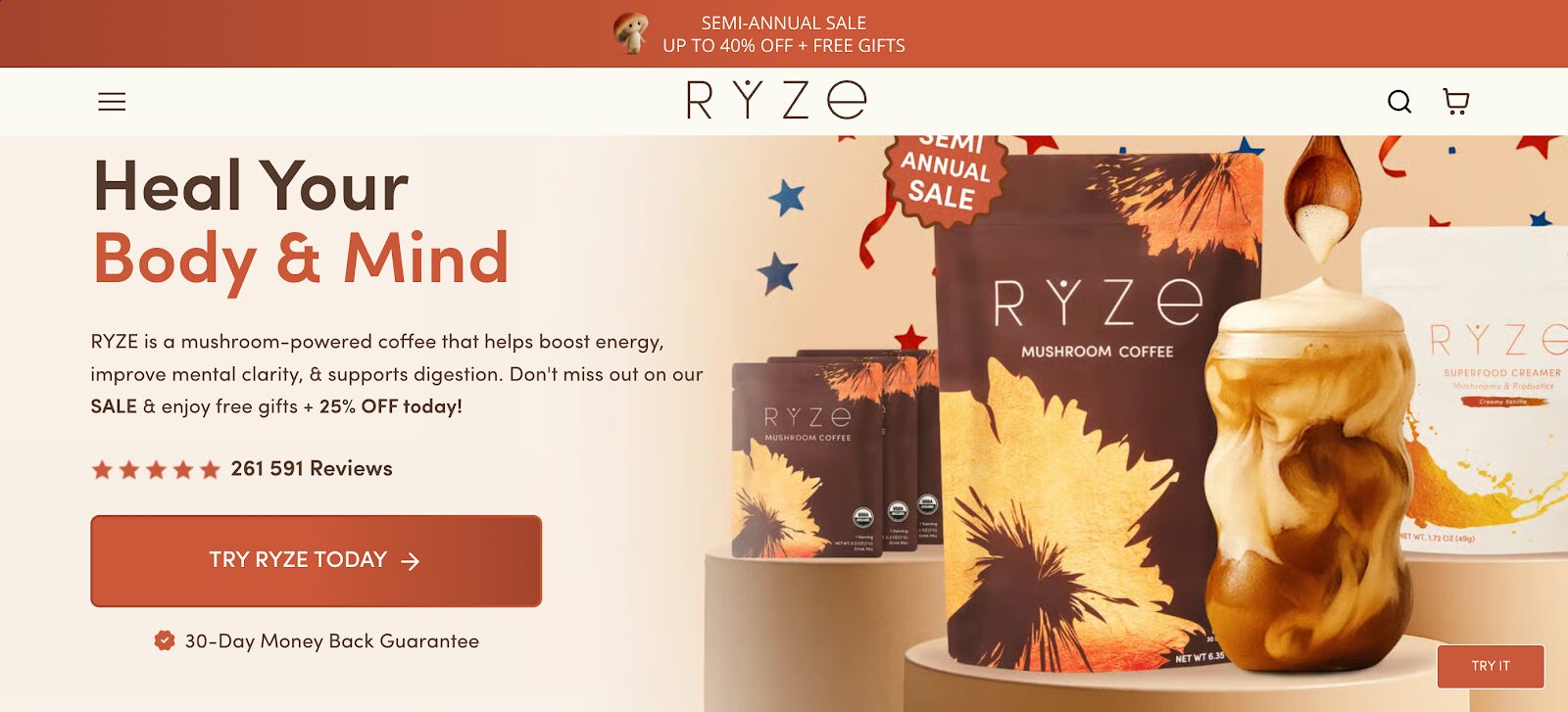
The homepage is filled with lifestyle images detailing the benefits of their product. Their product descriptions are detailed and enticing, adding more value to each item.

What we love:
- Large, clear CTAs to increase conversions
- 5-star reviews and a money-back guarantee to reassure customers
- Detailed product information with lifestyle imagery
20. Summer Fridays
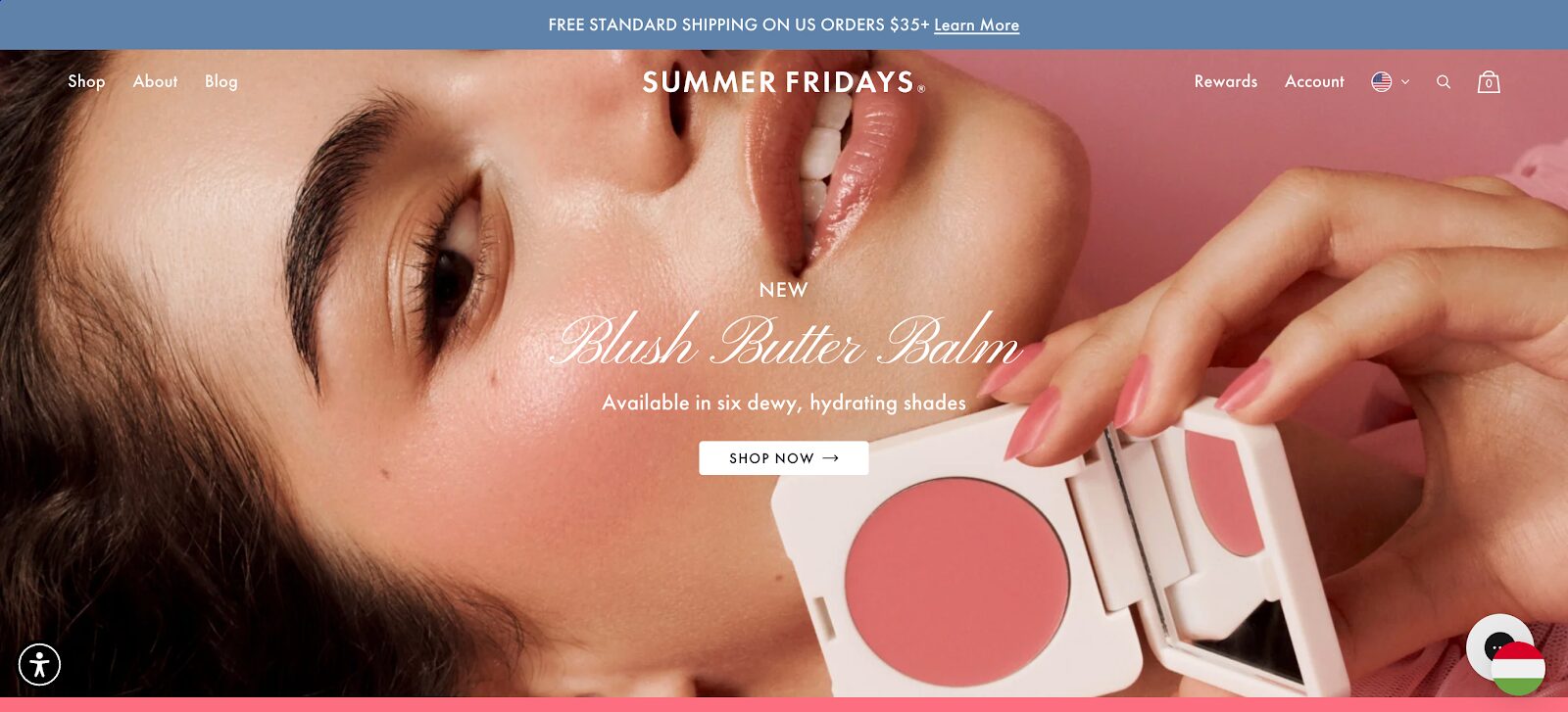
Skincare and makeup brand Summer Fridays uses a bright, cheerful color palette that aligns with its vibrant brand personality.
The homepage has an “add to bag” section for easy shopping.

Their product pages include video tutorials on how to apply their products, which makes the shopping experience more engaging and informative for customers.

What we love:
- An “add to bag” section on the homepage streamlines the shopping process
- Video tutorials on product pages help users understand the product better
- Bright, inviting color palette that reflects the brand’s upbeat personality
21. Oh, Polly
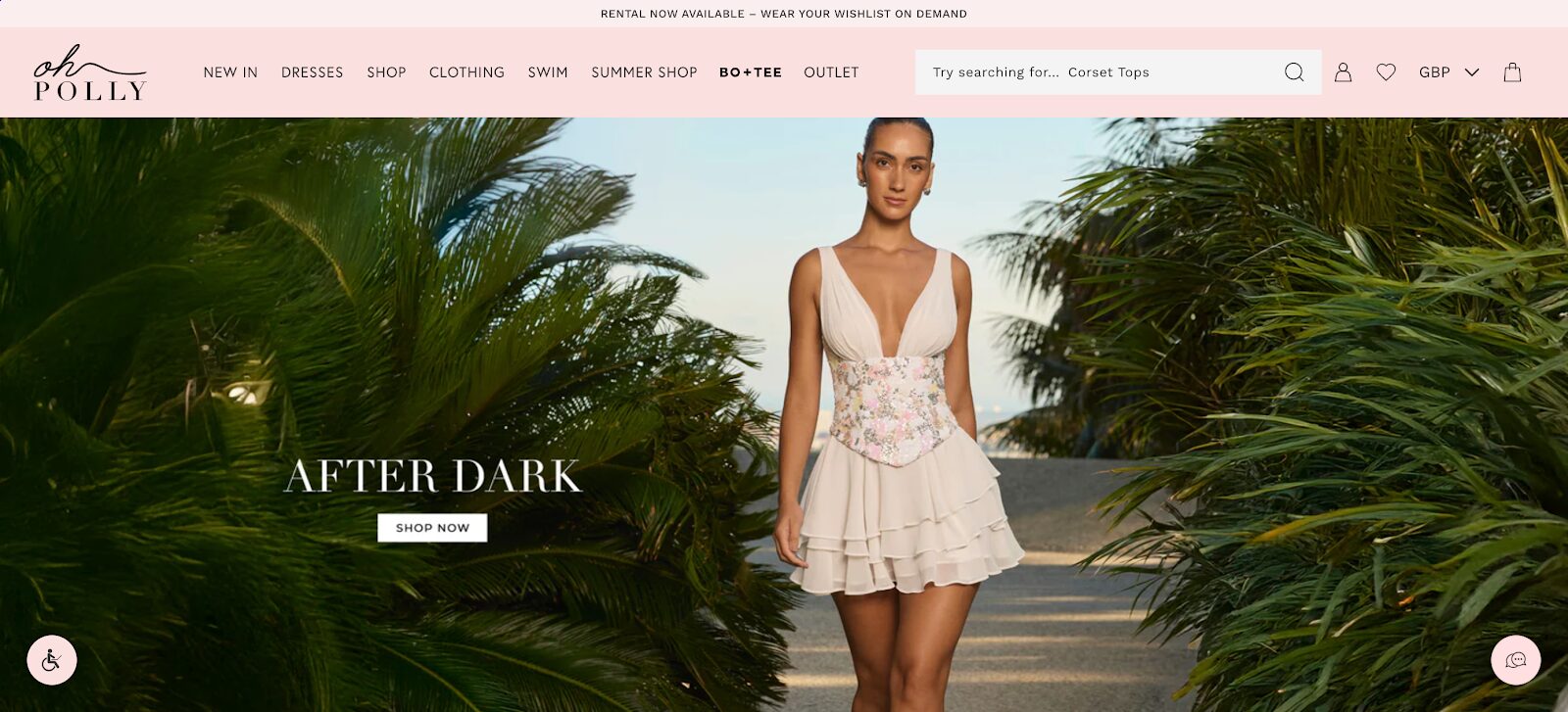
Oh Polly, an online fashion store, stands out with its clean, intuitive design. The website allows users to shop by occasion, which makes finding the right outfit easier.
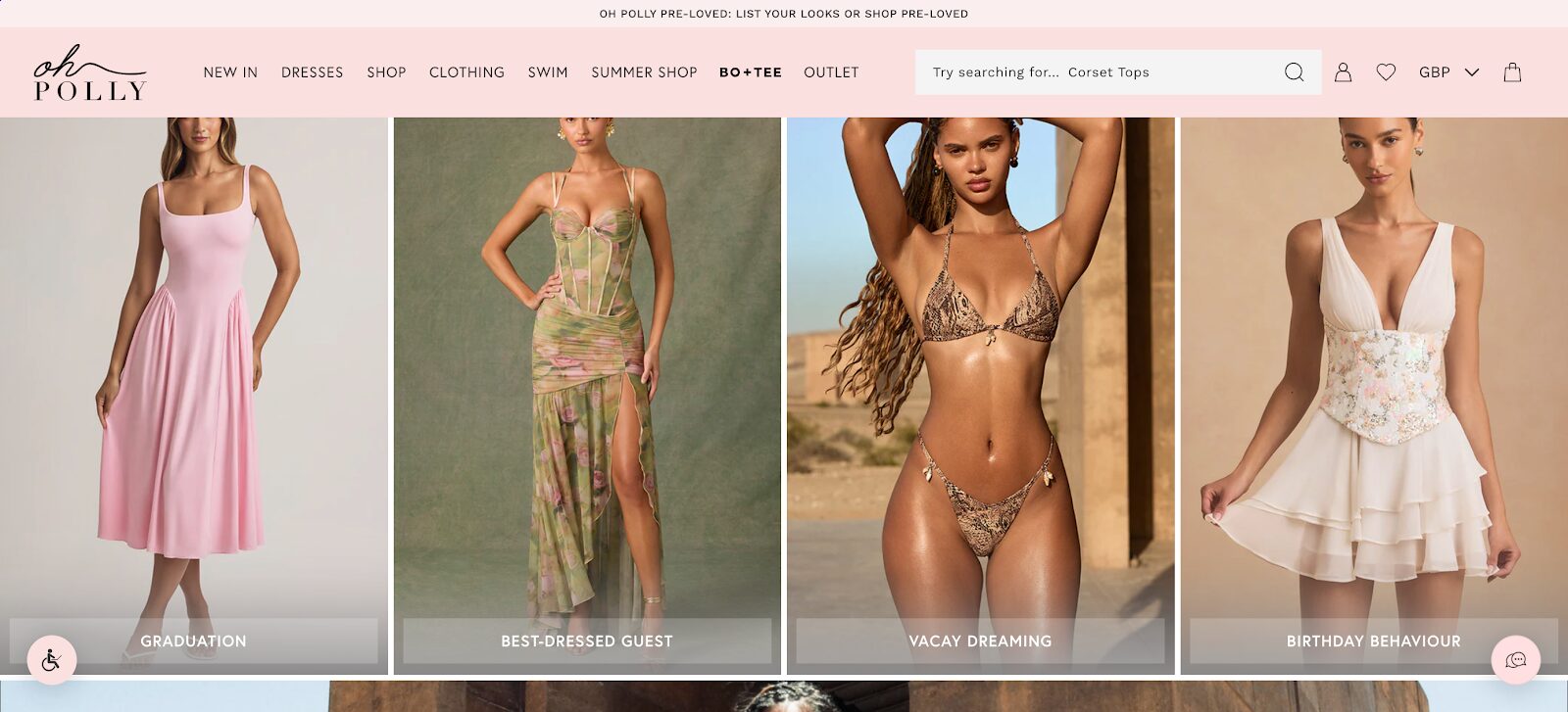
Their search bar is incredibly responsive, providing suggestions as you type.
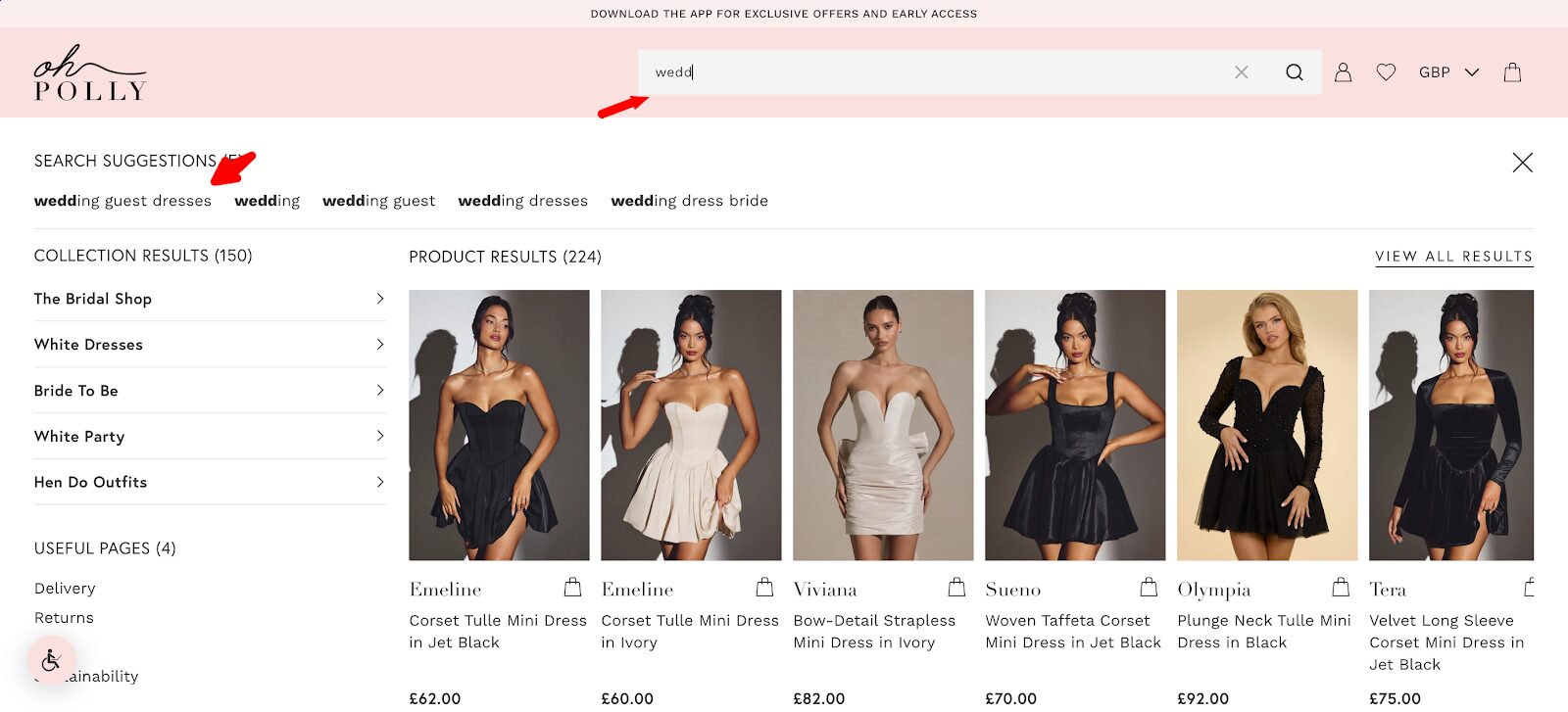
On product pages, they also recommend complementary items to help shoppers complete their look.
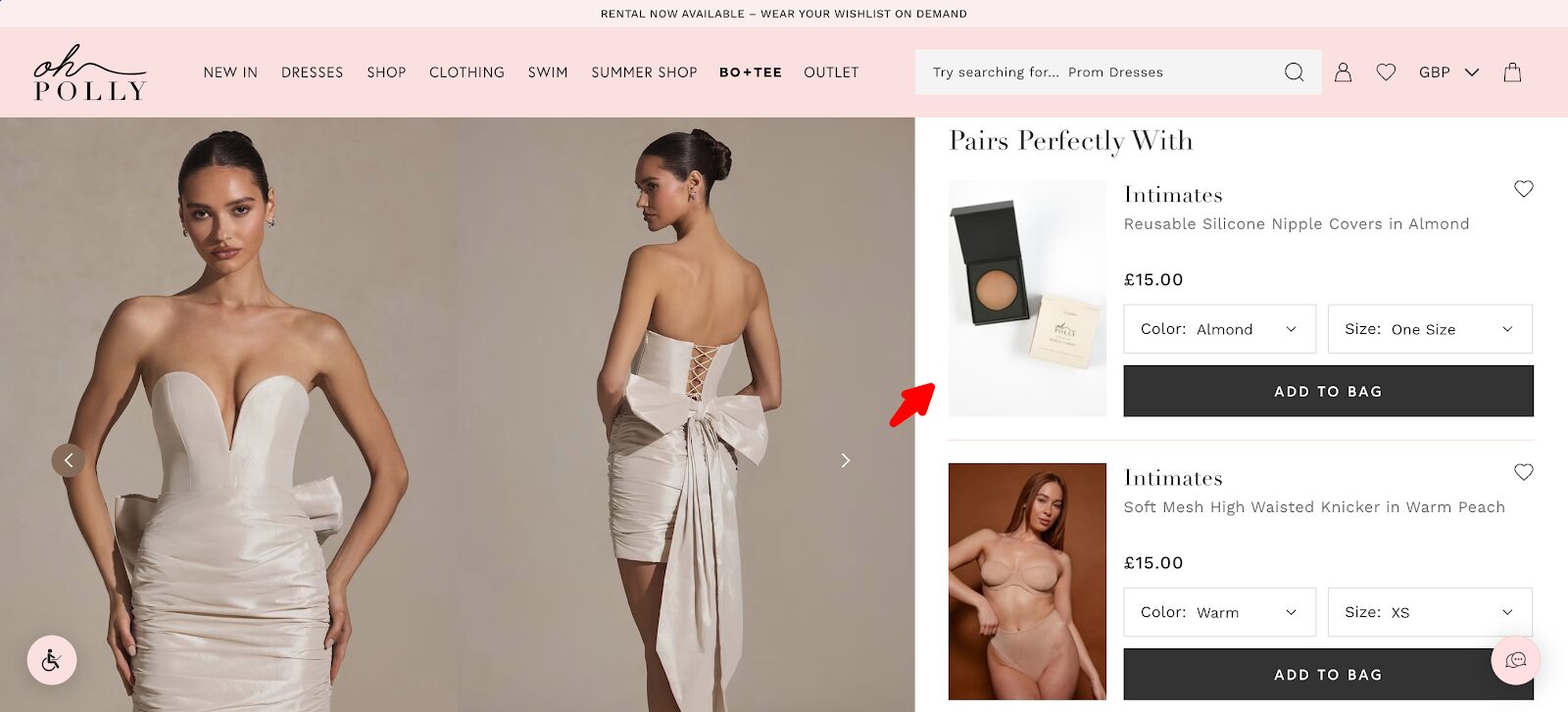
What we love:
- Shopping by occasion to reduce decision fatigue and simplify the buying process
- A smart, responsive search bar that helps users find what they’re looking for quickly
- Complementary products featured on the product page, providing upsell & cross-sell opportunities
22. Sixpenny
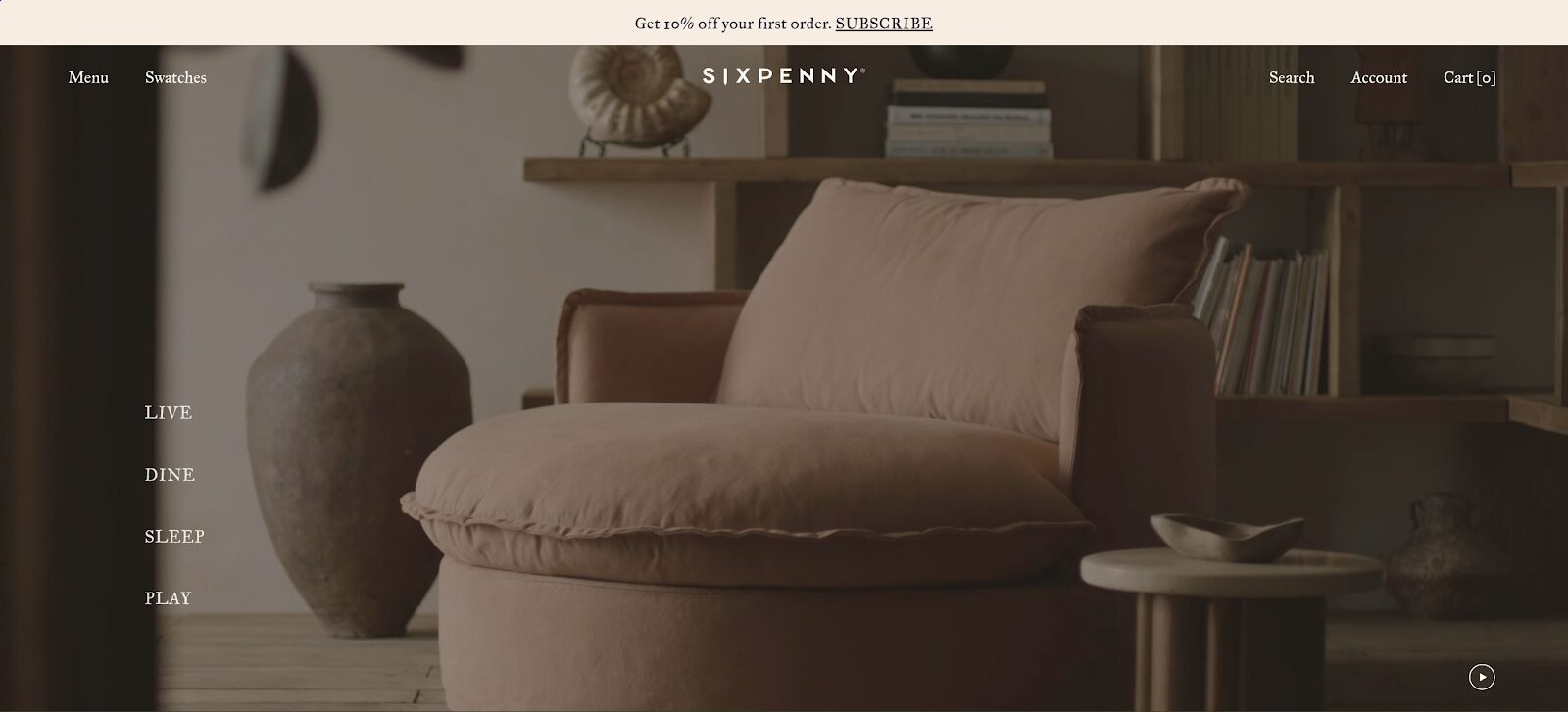
Minimalist brand Sixpenny offers a calming, serene experience on their website. Their homepage features an aesthetic video, which draws visitors in without overwhelming them.
The clean, simple layout is complemented by a navigation bar on the left, which keeps the overall design organized and easy to follow.
They also have a beautiful sign-up welcome popup, which is displayed when visitors arrive on the page.
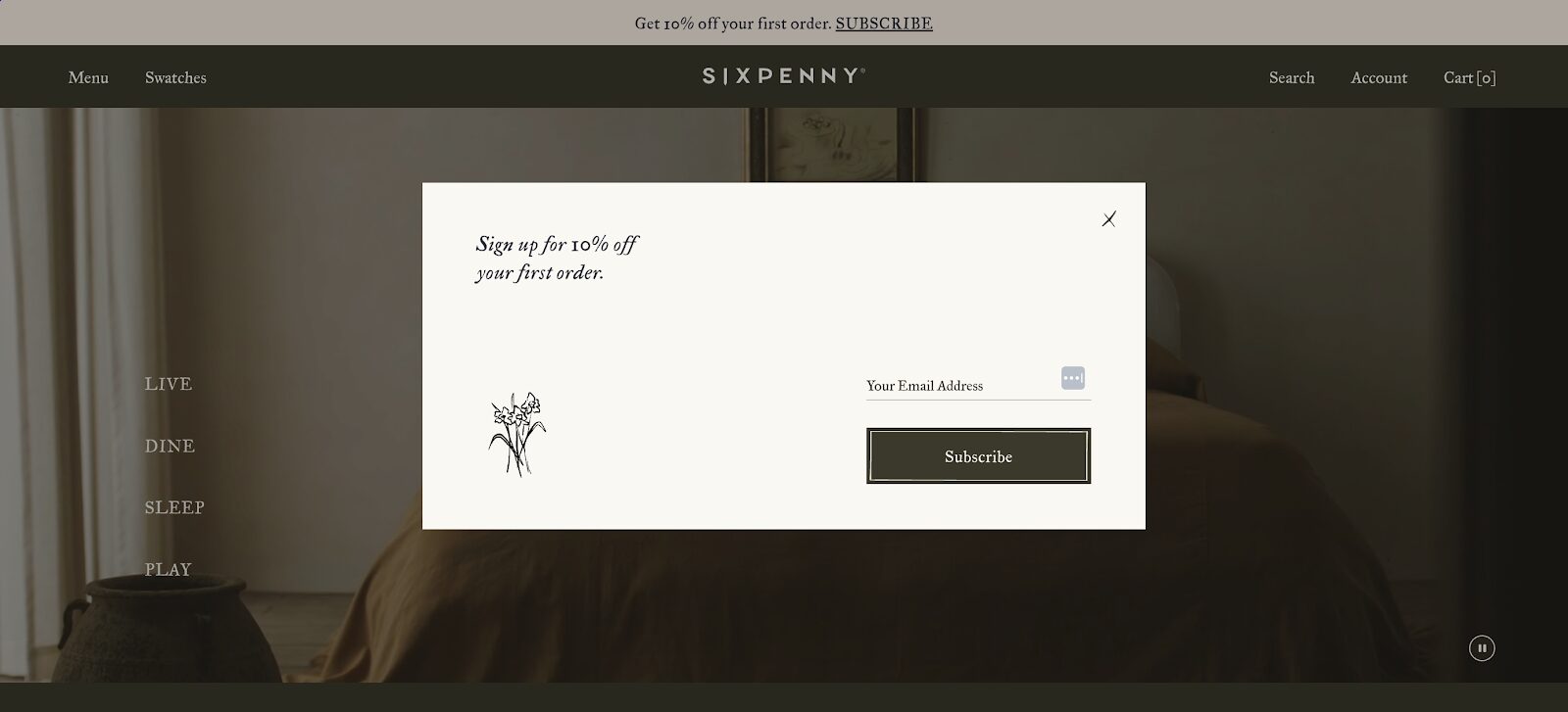
What we love:
- An aesthetic video that captures the essence of the brand
- A minimalistic design that helps visitors focus on the product
- A simple, intuitive navigation bar on the left side
23. MVMT
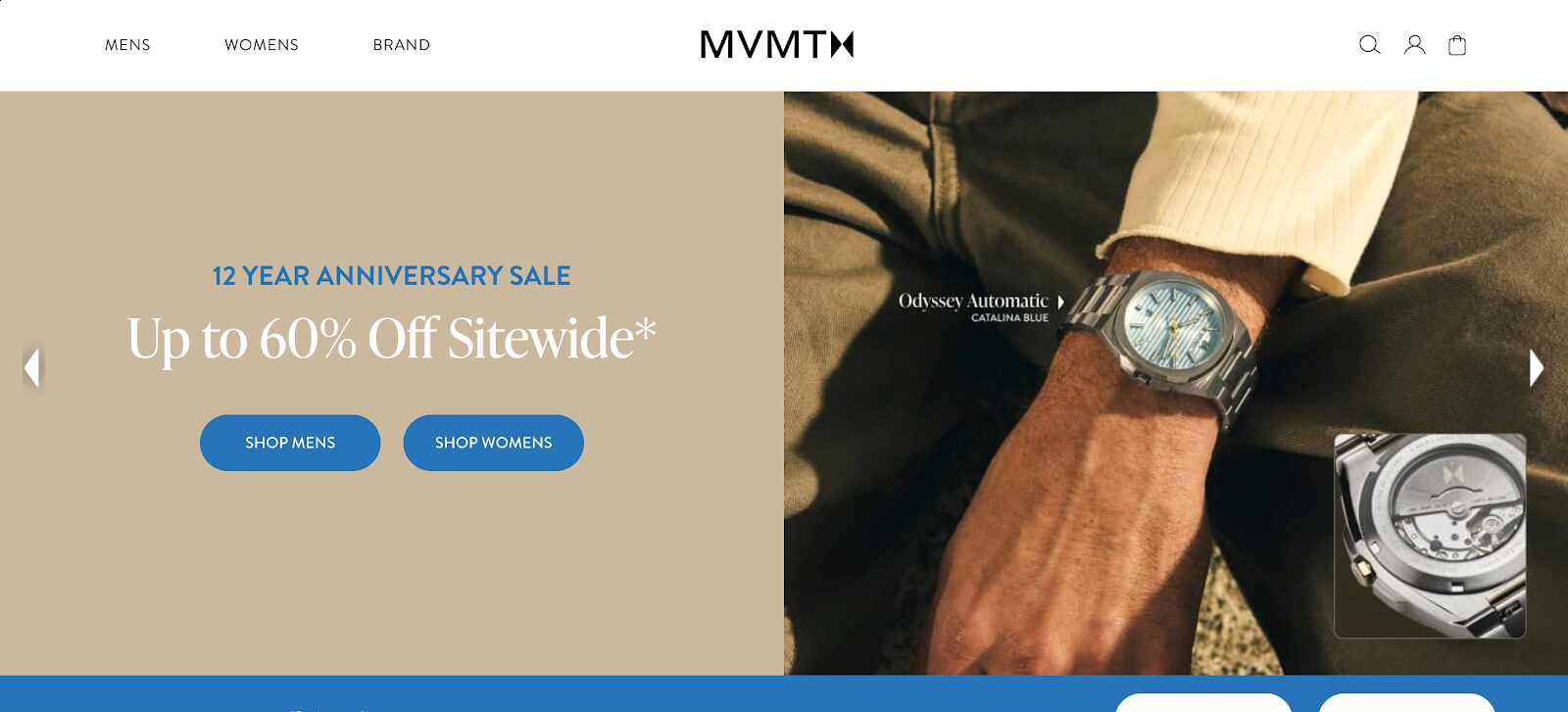
MVMT’s sophisticated website focuses on luxury watches with a minimalistic yet modern design. The ecommerce store showcases press mentions on the homepage, lending credibility to their products.
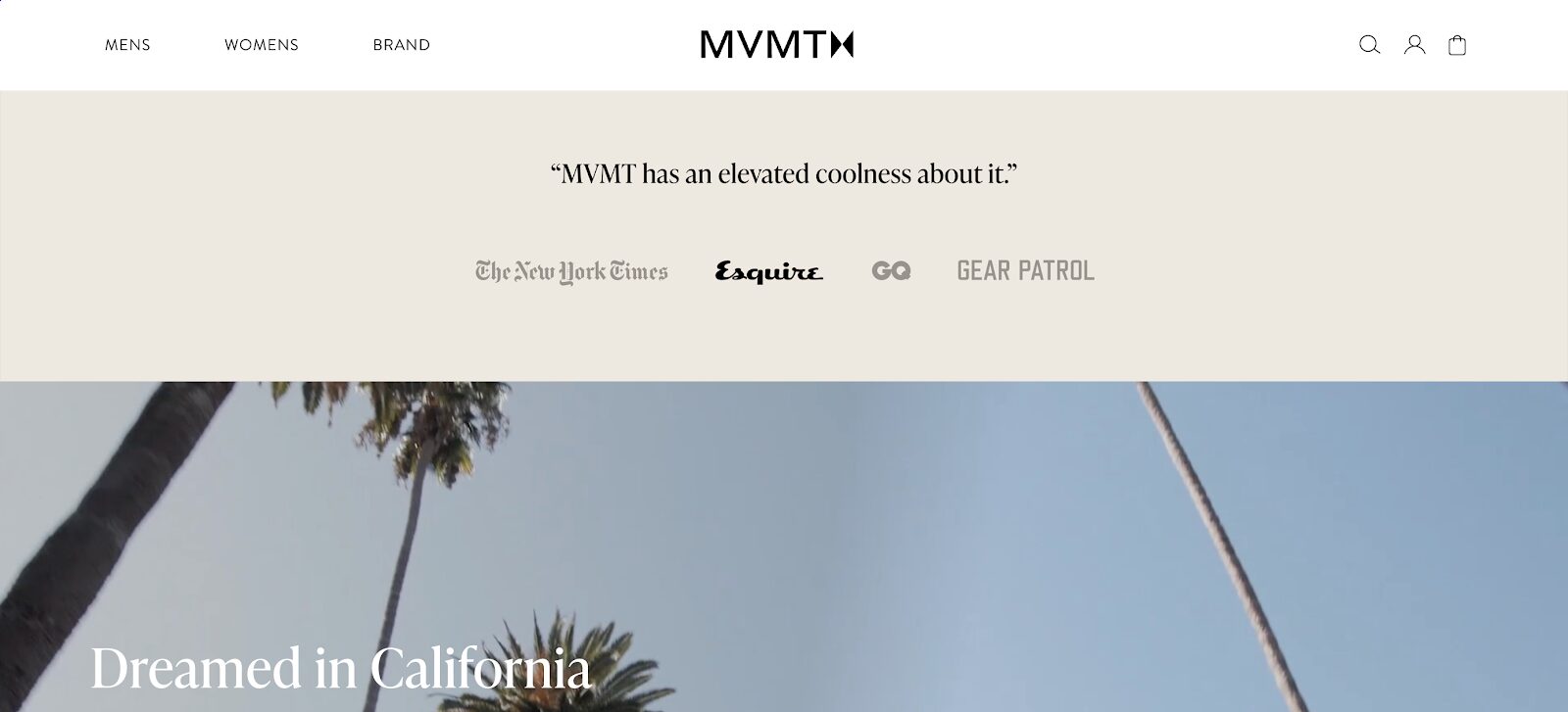
In addition, they clearly communicate free shipping, easy returns, and warranty promises near the footer, reassuring customers before they make a purchase.
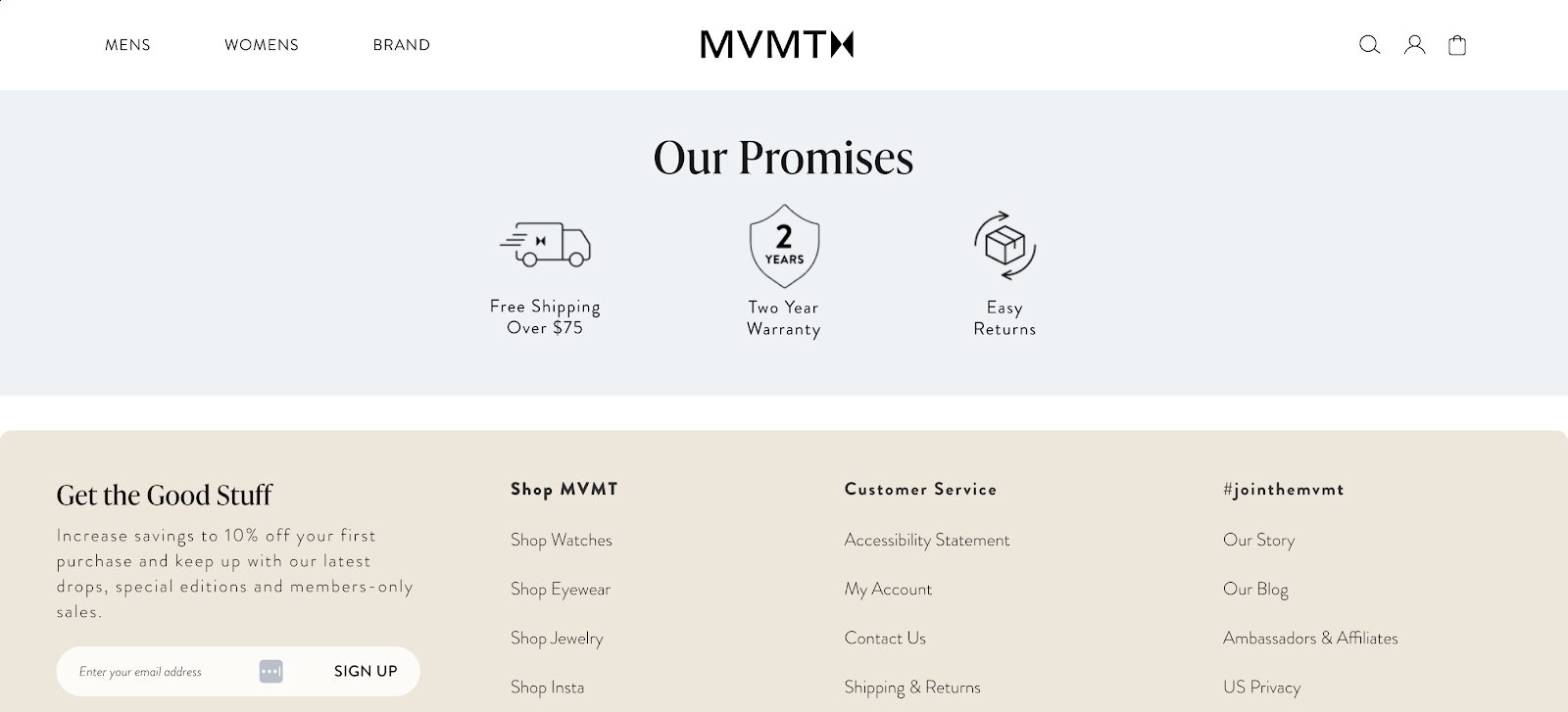
What we love:
- Sophisticated, minimalist design
- Press mentions for added credibility
- Clear communication of return policies and free shipping near the footer
24. Kylie Cosmetics
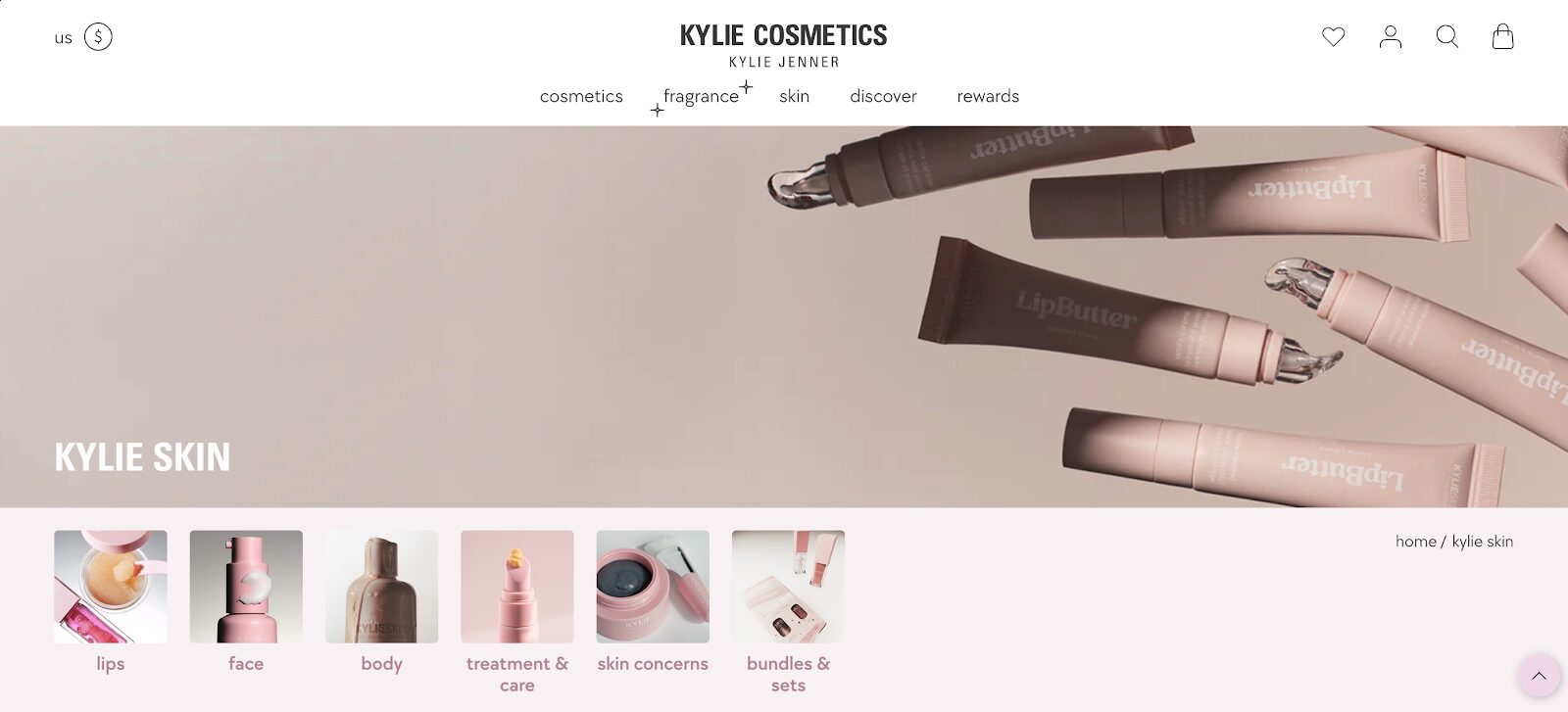
Kylie Jenner’s makeup line, Kylie Cosmetics, keeps it straightforward with a clean, simple website design.
Once you enter the site, you’re welcomed with a destination-based popup, which makes it easier to shop in your currency.
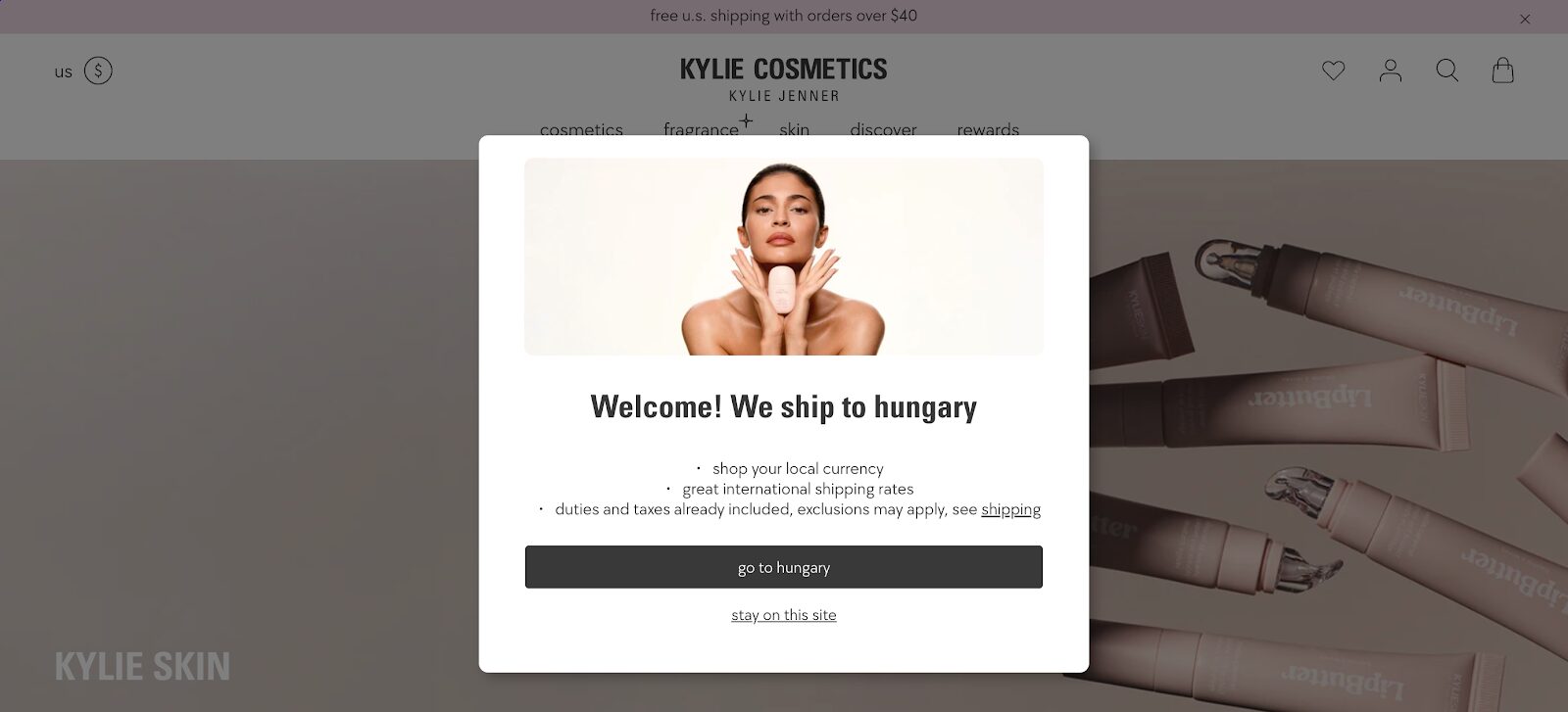
Visitors can easily browse product categories like cosmetics, fragrance, and skin care right from the homepage.
On their product page, they showcase “real results,” which is a smart move and reassures customers before a purchase.
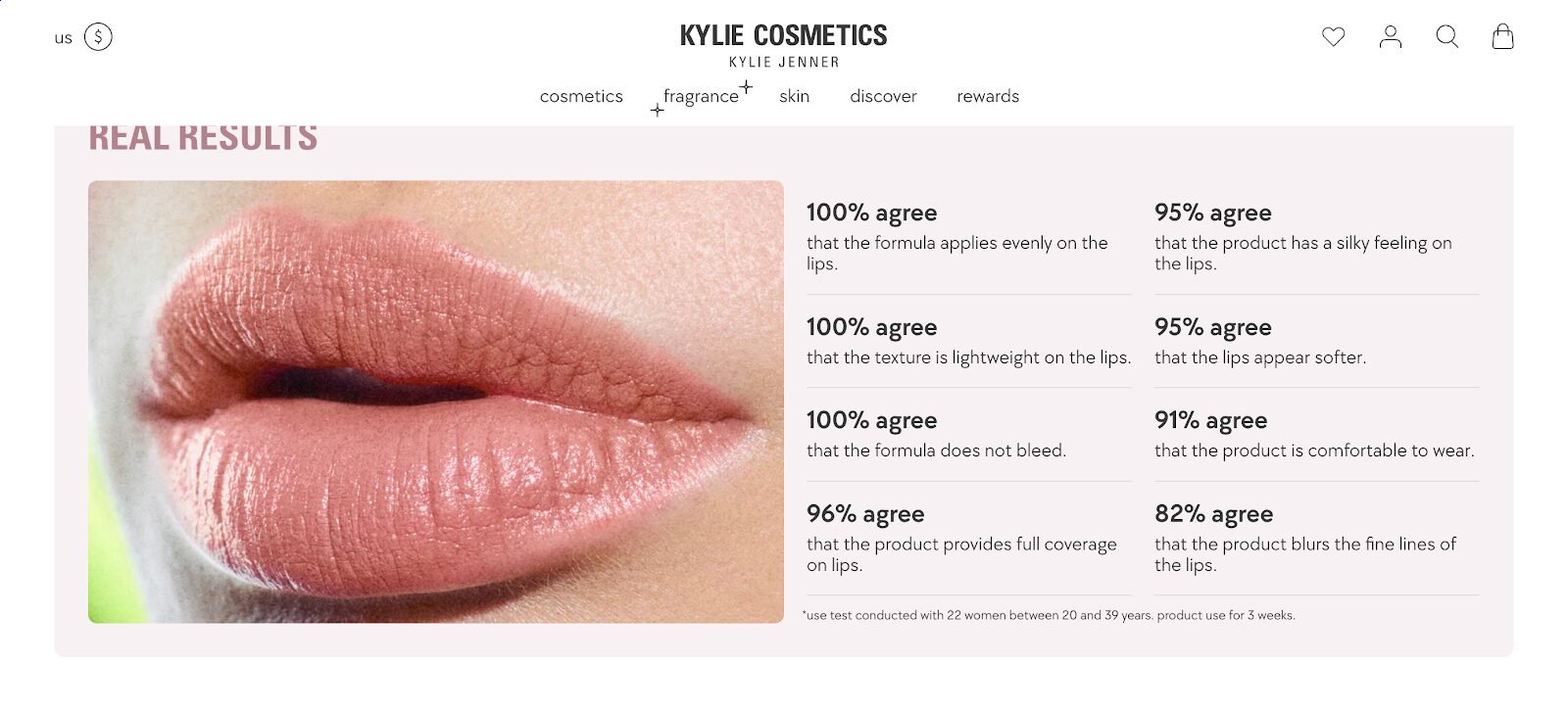
What we love:
- Location-based popups that make it easy for visitors to shop in their currency
- Simple, well-organized category pages for a seamless shopping experience
- Clear messaging with customer reviews to reinforce trust in the products
25. Pura Vida Bracelets
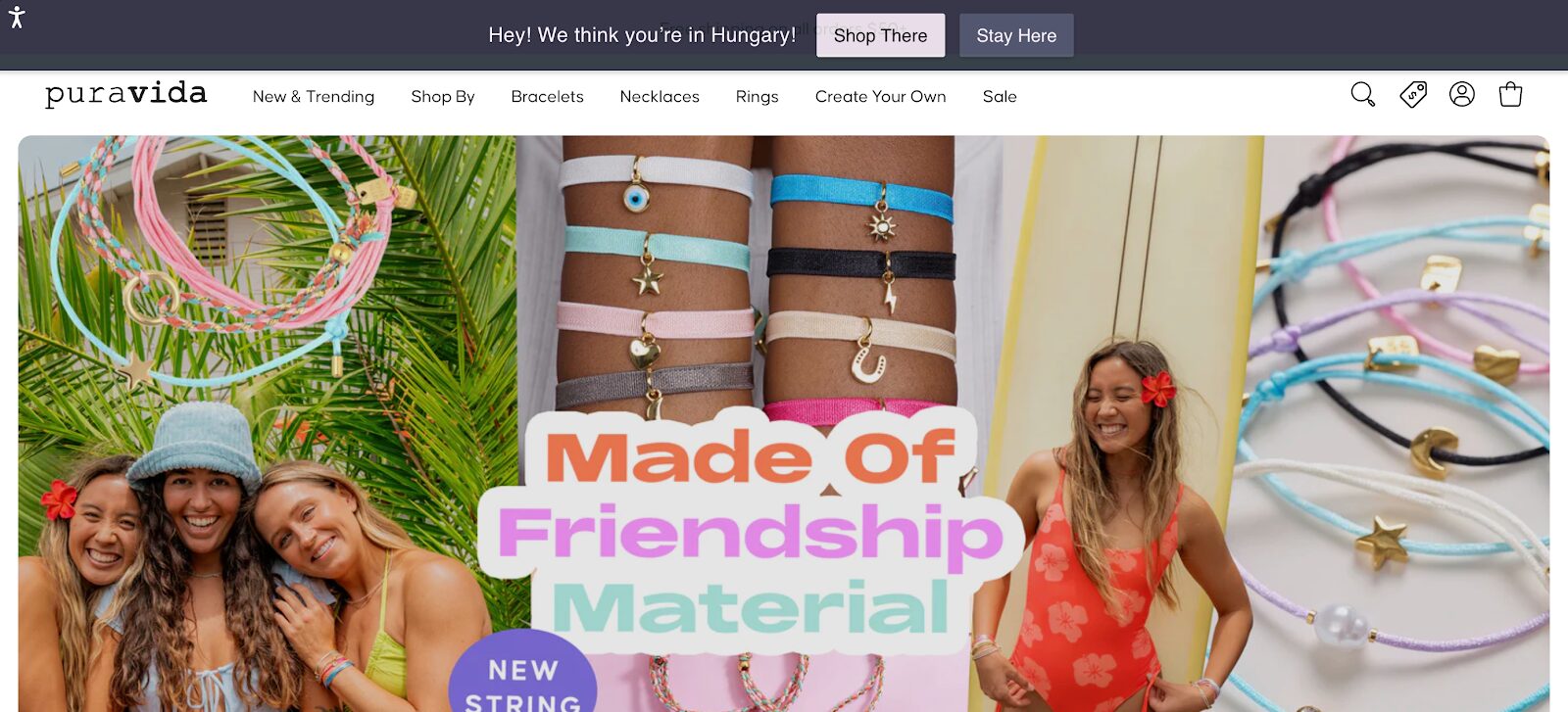
Pura Vida sells beautiful boho-style jewelry, and their website matches their laid-back, fun vibe.
A location-based shipping bar helps visitors from different countries shop in their local currency.
The homepage features trending styles and bestsellers.
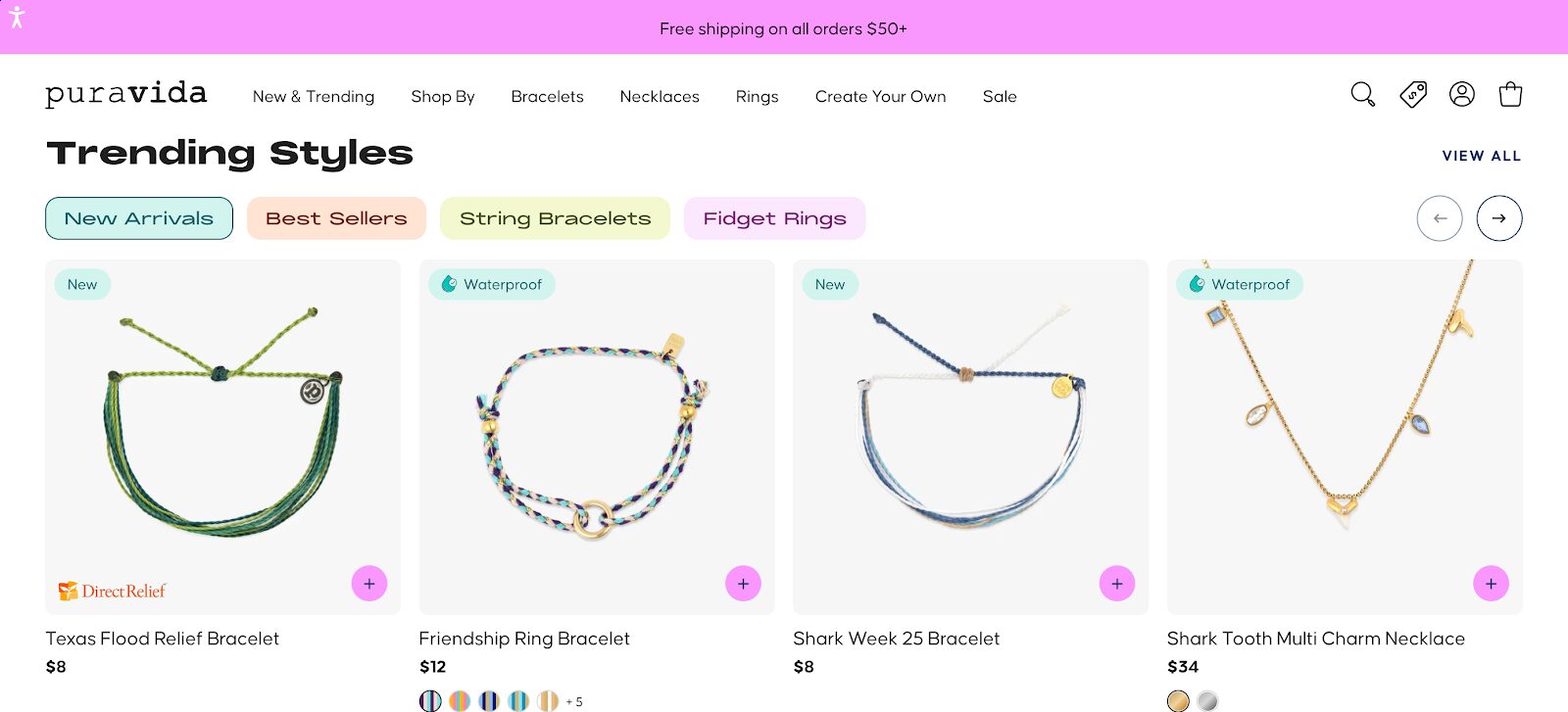
The “Why Shop With Us” section offers customers a deeper understanding of the brand’s values.

What we love:
- Location-based shipping bar that adapts to users’ regions
- A “Why Shop With Us” section that communicates the brand’s ethos
- Trendy, boho-style product images that create a strong visual identity
26. Holderness & Bourne
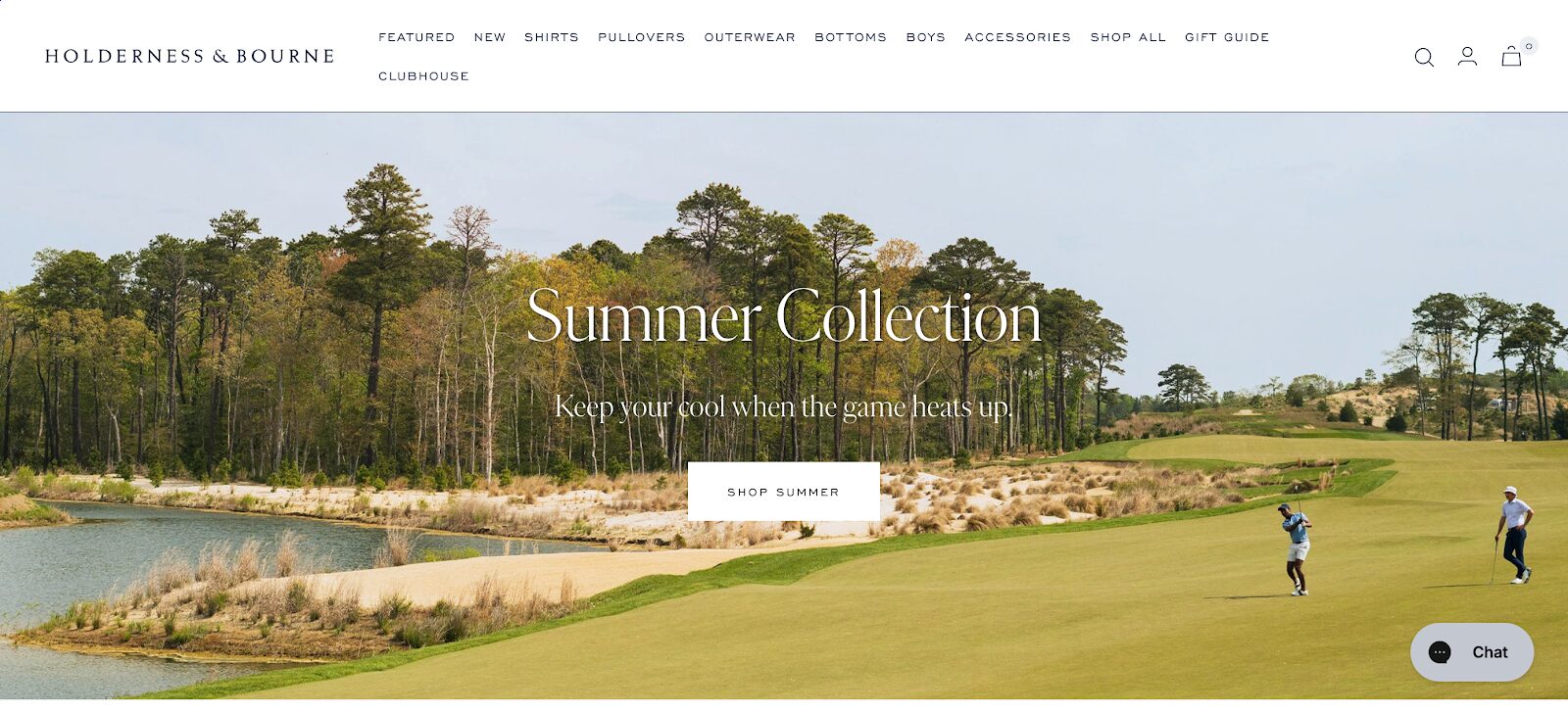
Holderness & Bourne offers premium, stylish golf apparel.
They cleverly incorporate Instagram-like features into their website, promoting products through lifestyle photos and tagging items directly on them.
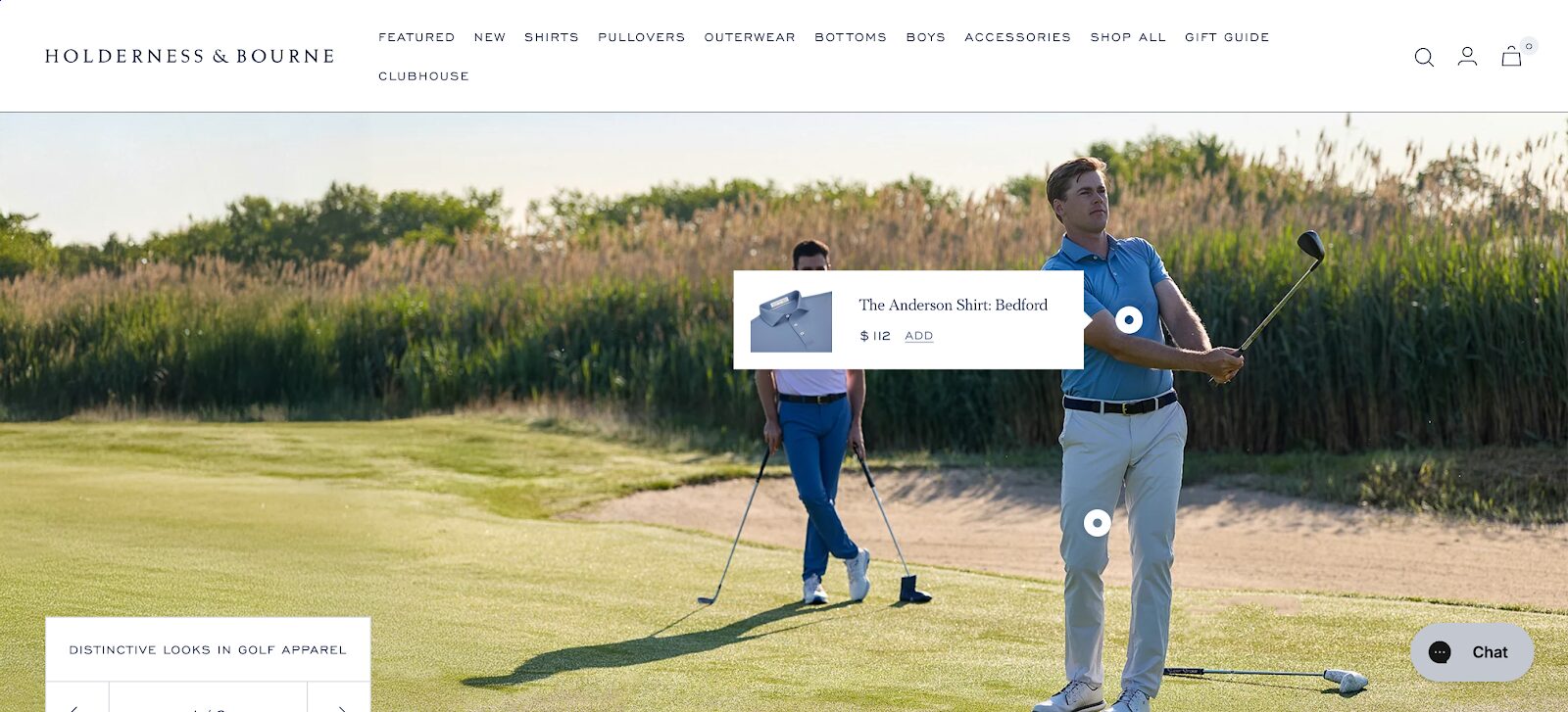
At the bottom of the page, you’ll find a “Recommended for You” section, further personalizing the user experience and helping visitors discover more relevant products.
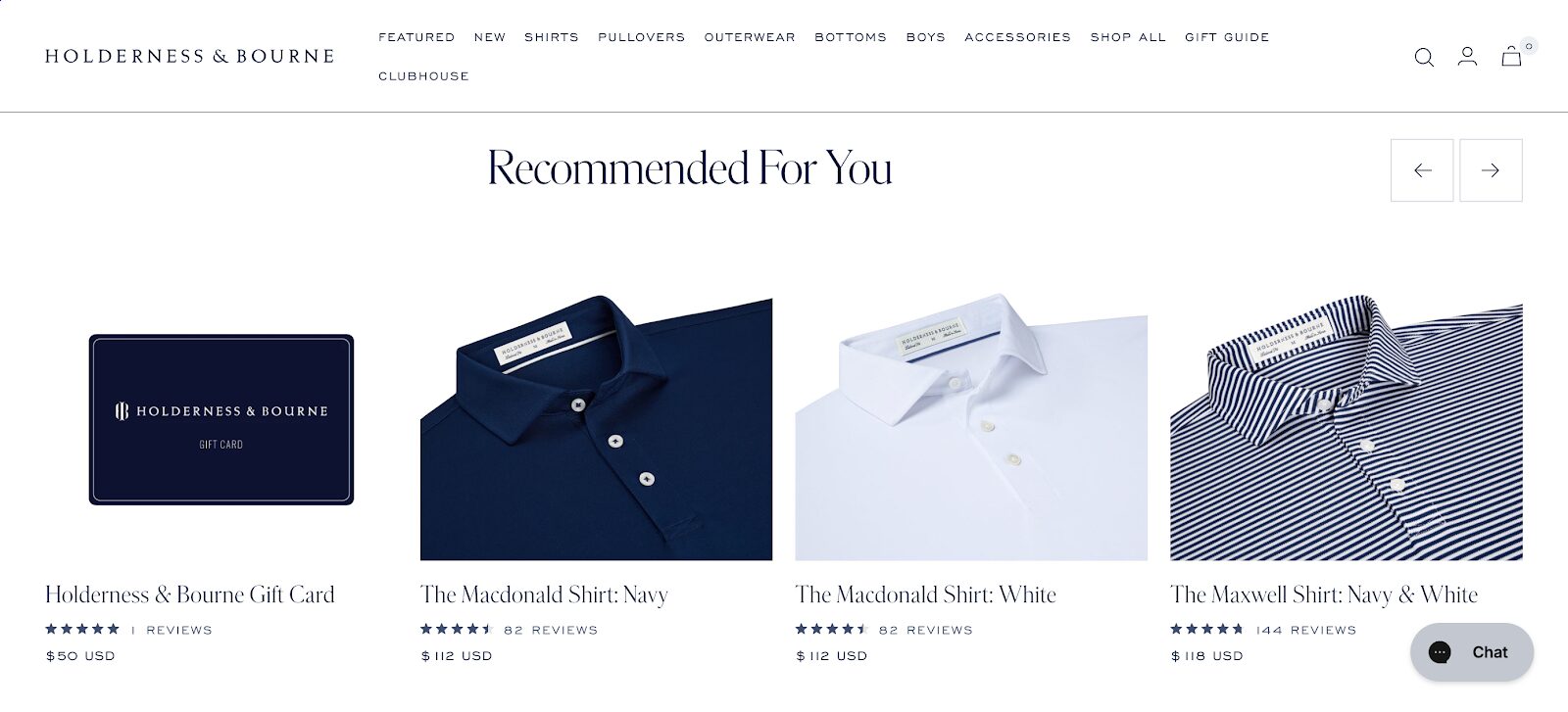
What we love:
- The stylish, high-quality photography
- Product tags on photos that make shopping seamless
- The “Recommended for You” section that personalizes the shopping experience
27. Laird Superfood
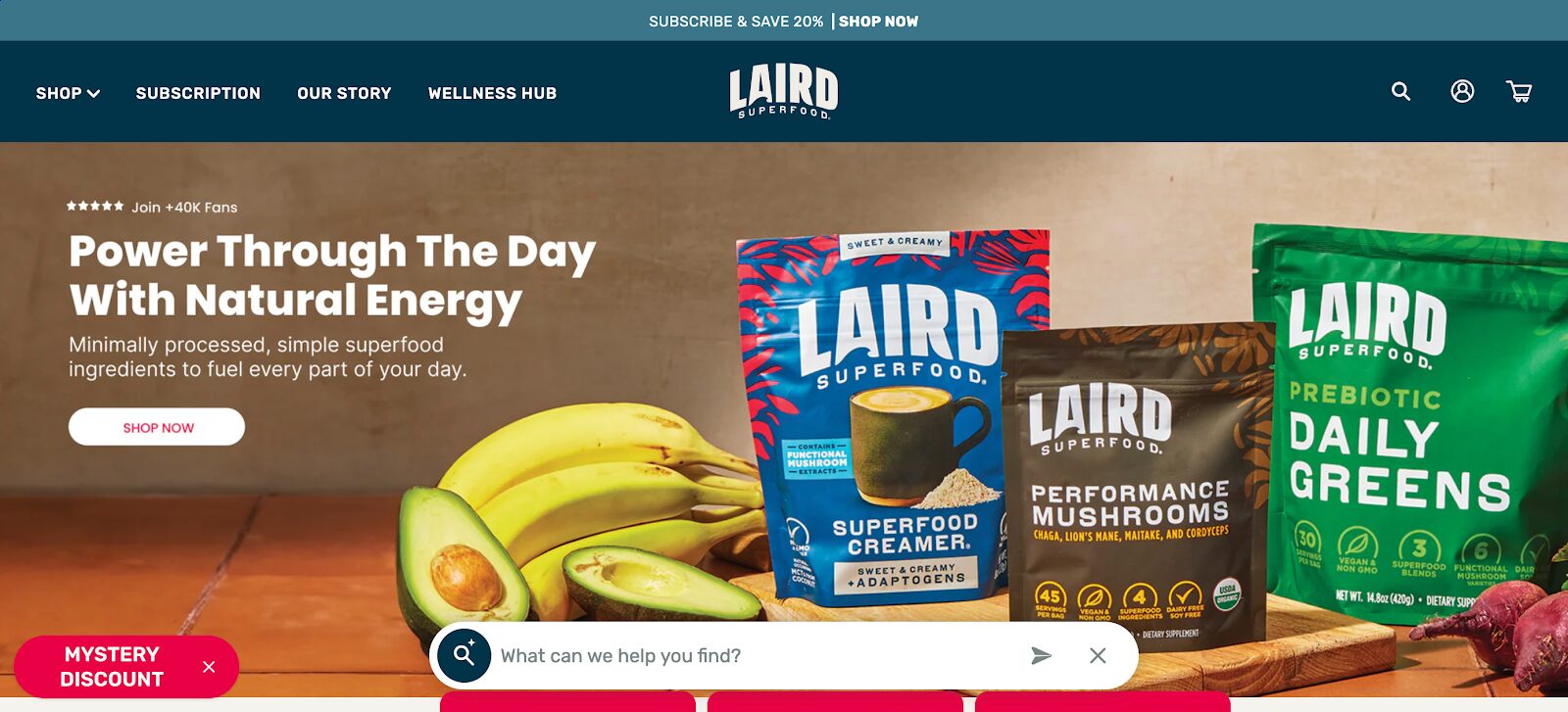
Laird Superfood offers a variety of superfood ingredients, and their website design strikes the perfect balance between fun and functionality.
Upon entering the site, visitors are greeted by a mystery discount popup that asks what interests them, allowing Laird Superfood to segment their audience and offer personalized recommendations.
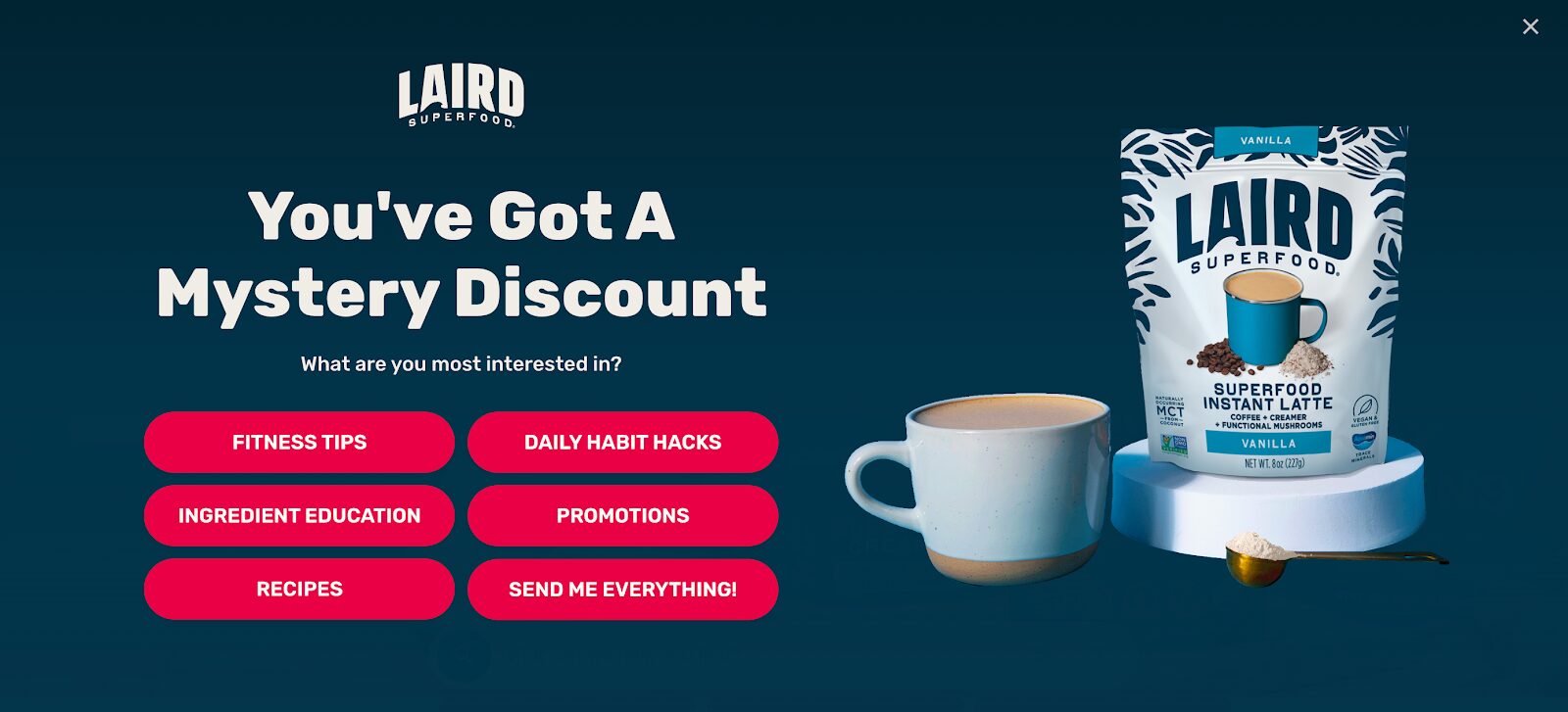
Even after closing the popup, a teaser remains, keeping the discount in front of customers.
Additionally, their “What can we help you find?” AI-powered bar provides an easy way for visitors to find exactly what they need, making the experience even more personalized and efficient.

What we love:
- Mystery discount popup that creates excitement
- AI-powered shopping assistance that personalizes the user experience
- Customer reviews featured at the bottom of the page, building trust
If you want to add a touch of mystery to your popups, try out these templates:
28. Meow Meow Tweet
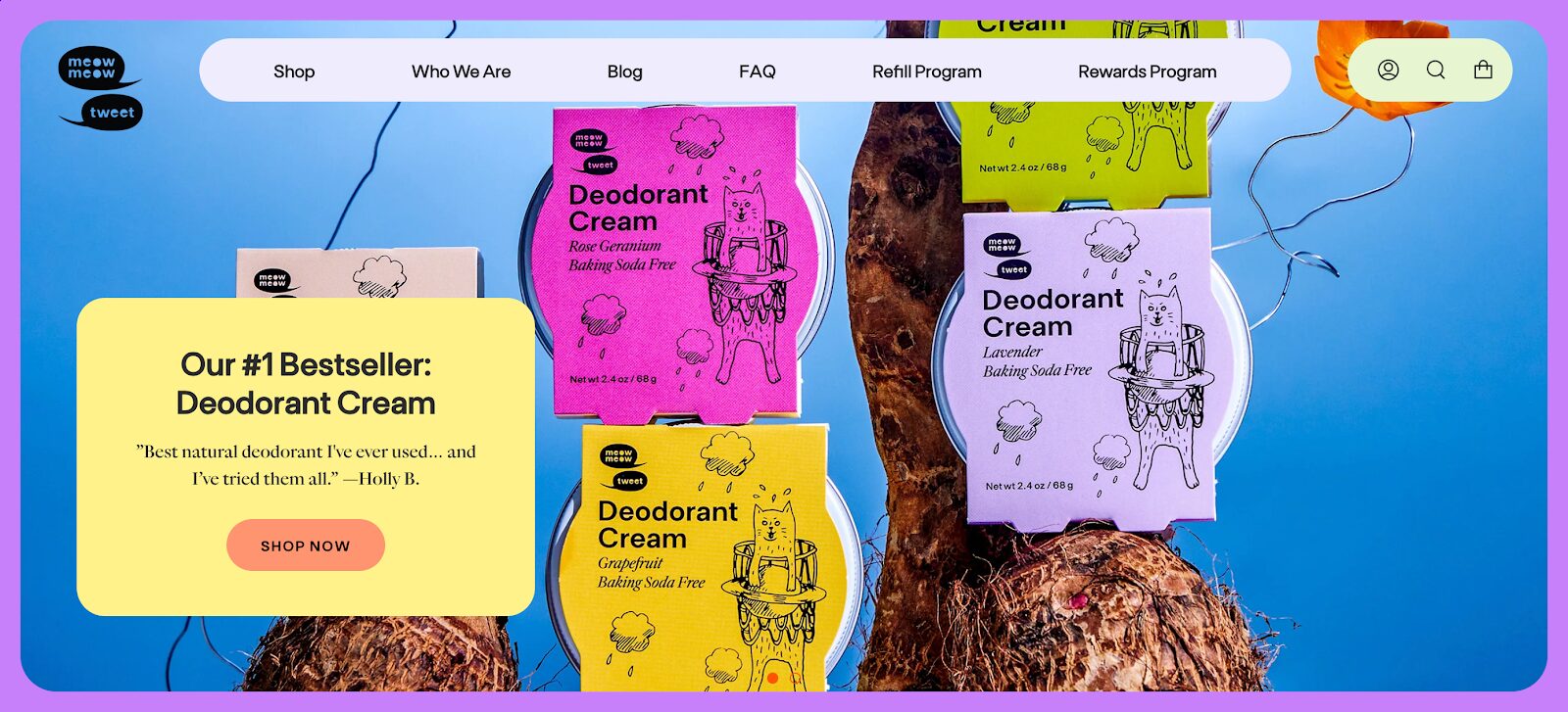
Meow Meow Tweet brings a playful touch to both their brand and their website.
The design includes a prominent call-to-action (CTA) right above the fold, with a strong headline, “Our #1 Bestseller,” a customer review, and a bold “Shop Now” button.
This instantly builds credibility and drives engagement.
This ecommerce site also provides an intuitive shopping experience, allowing visitors to shop by skin type, which simplifies the decision-making process.

The inclusion of ethical badges further strengthens the brand’s commitment to sustainability.
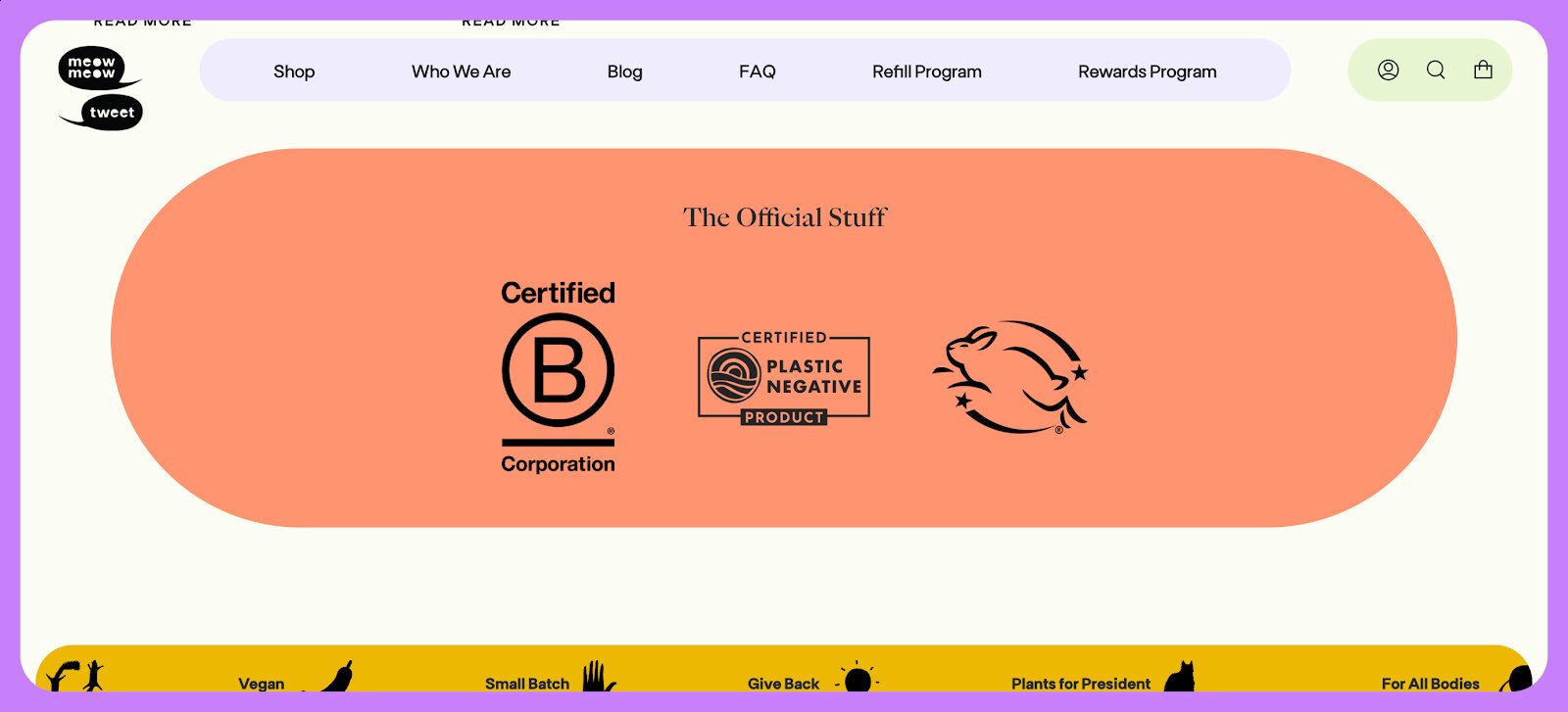
What we love:
- Fun, playful design that matches the brand’s vibe
- Shopping by skin type for a more tailored experience
- Ethical badges that emphasize the brand’s commitment to sustainability
29. Blume

Blume, a skincare brand popular among younger generations, uses a full screen conversational popup that welcomes visitors and engages them right away, gathering valuable information about their needs.
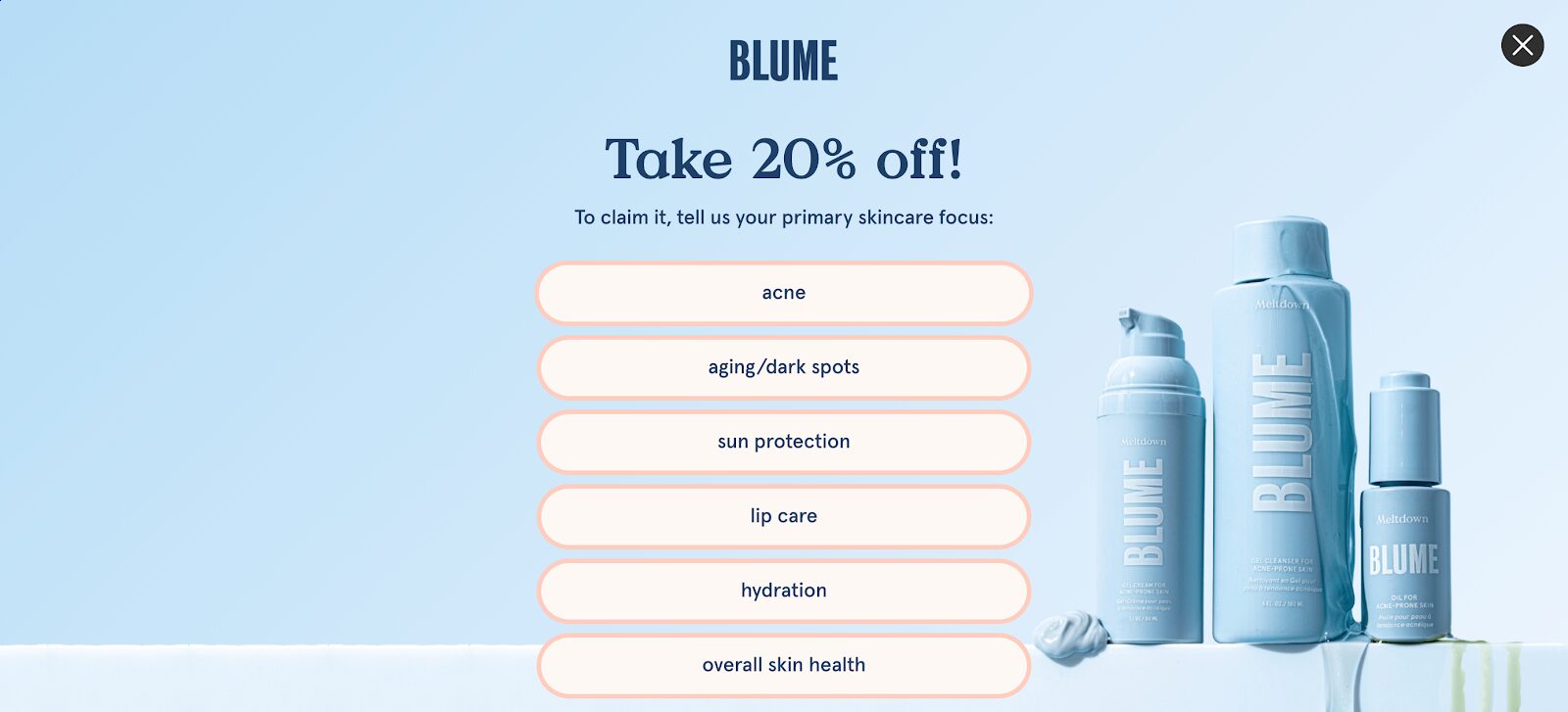
On the product pages, Blume also shares consumer study results, providing insights into the effectiveness of their products.
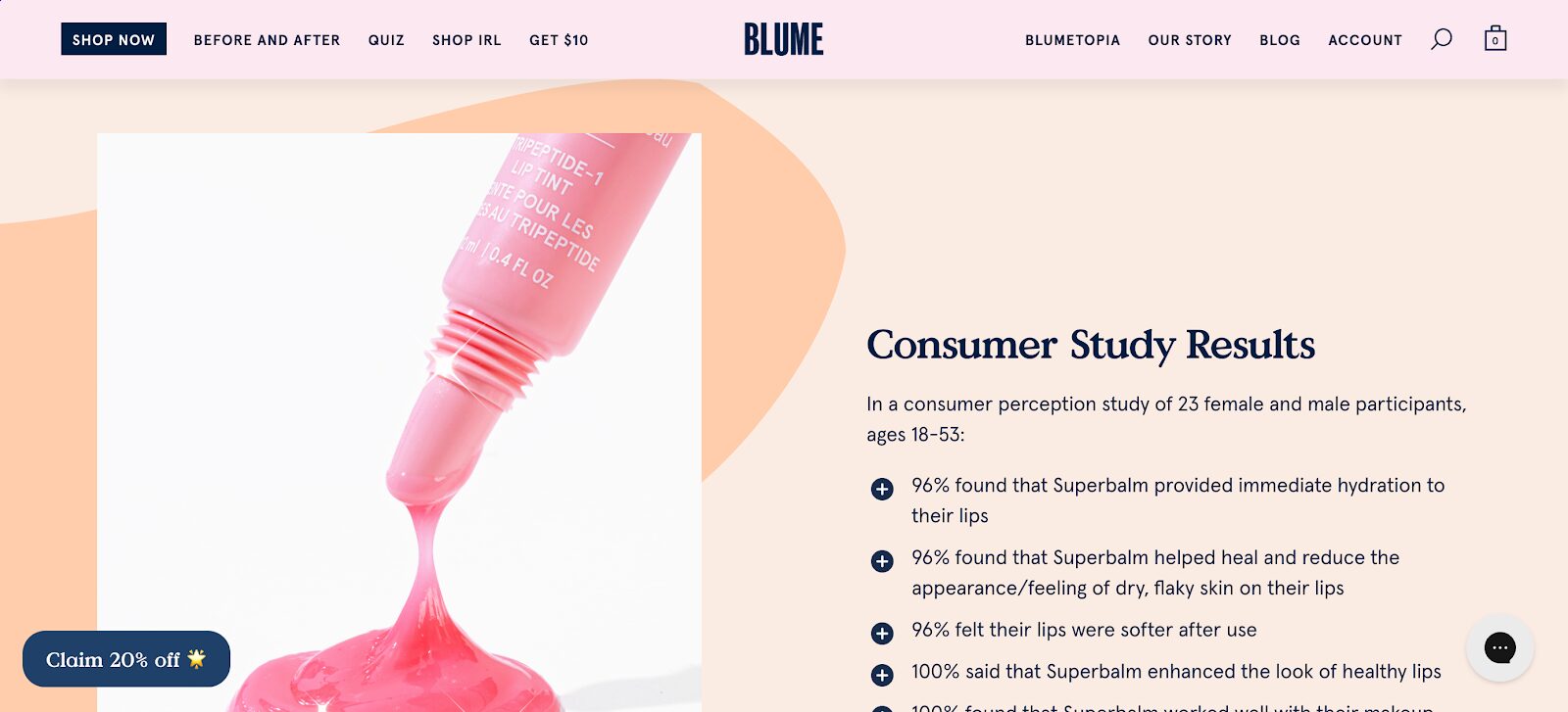
The site highlights press mentions and positive reviews to boost credibility.
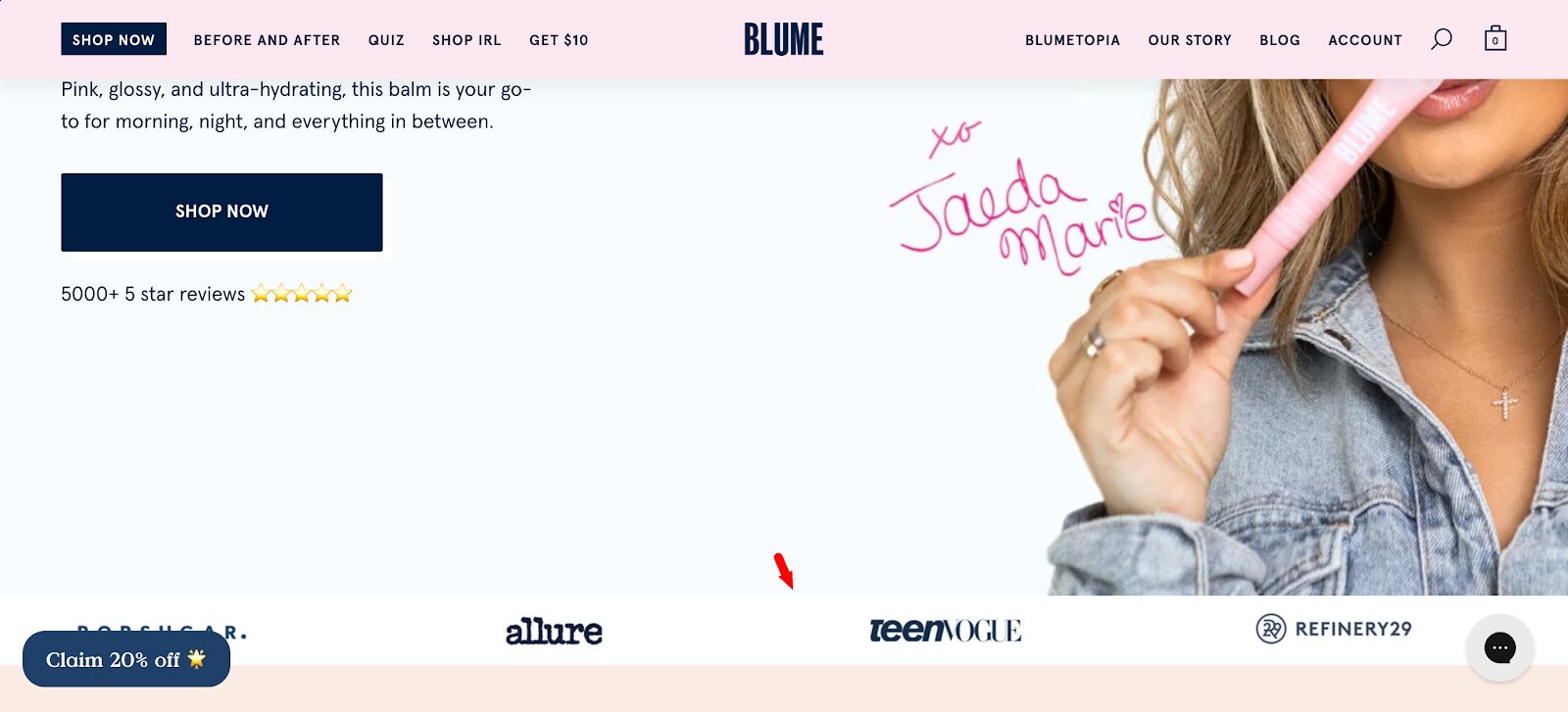
What we love:
- Conversational popup that creates a personal connection
- Highlighting press mentions and consumer reviews to build trust
- Simple yet playful product pages that engage users
30. Snow Peak USA
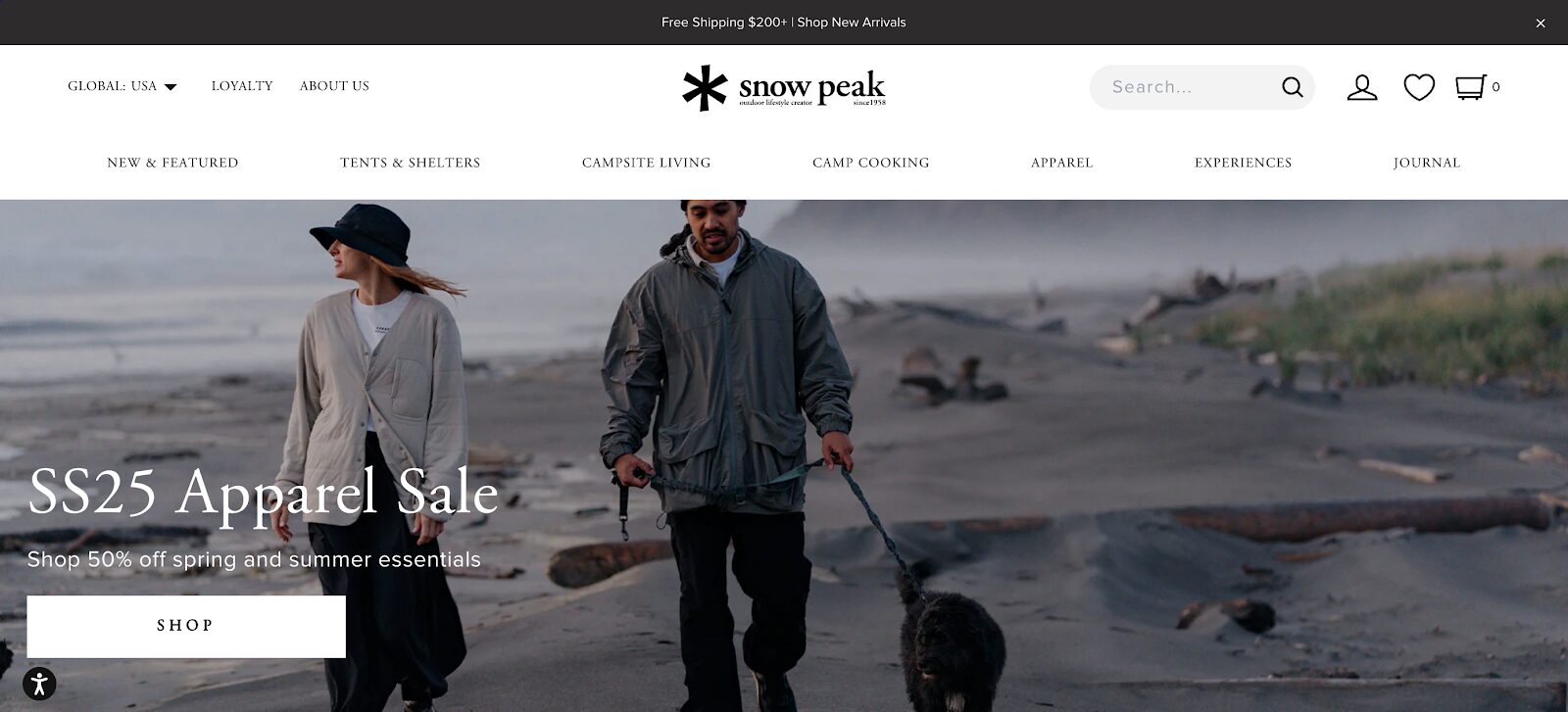
Snow Peak USA is a premium brand focused on outdoor camping and lifestyle gear. Their website reflects their high-quality products with engaging, lifestyle-driven imagery.
The site emphasizes key information such as free shipping, loyalty programs, and return policies right where users need them, making shopping hassle-free.
Snow Peak also incorporates their Instagram feed on the website, enhancing the lifestyle vibe and showcasing products in real-life settings.
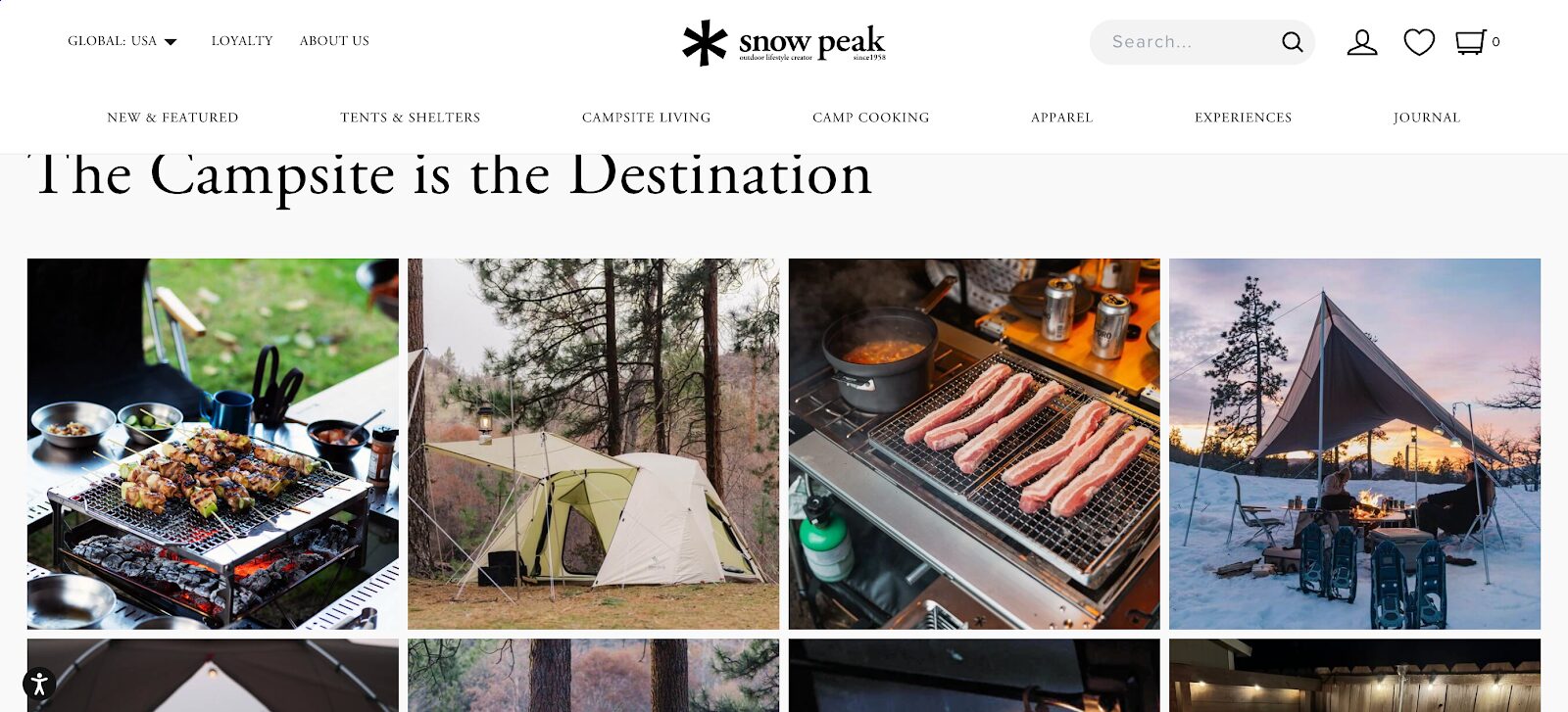
What we love:
- Lifestyle imagery that fits the brand’s adventurous spirit
- Embedded Instagram feed that enhances the product experience
- Blog articles embedded within product pages, creating easy access to valuable content
31. Pipcorn Snacks

Pipcorn, a brand selling healthier popcorn alternatives, brings its playful personality to its website design.
The homepage showcases their fan-favorite snacks, making it easy for visitors to browse and purchase popular products.
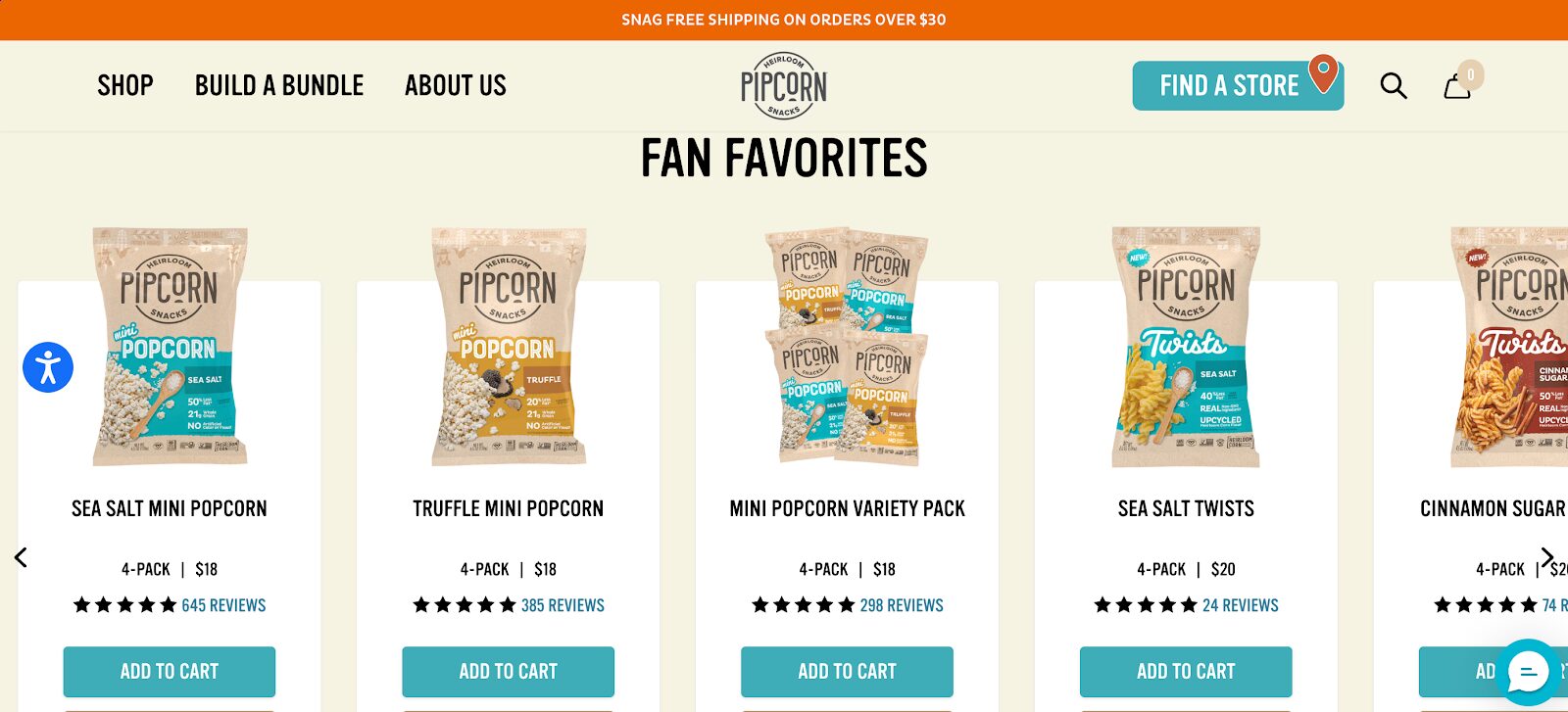
Each product page features smart copy that emphasizes the benefits and unique qualities of the snacks, encouraging more purchases.

Pipcorn also enables filtering by snack type, helping customers quickly find what they’re looking for without any unnecessary scrolling.
What we love:
- Filtering by snack type for easy browsing
- Fan-favorite products are featured prominently to drive sales
- Smart copy on product pages that highlights key benefits
32. Tony’s Chocolonely
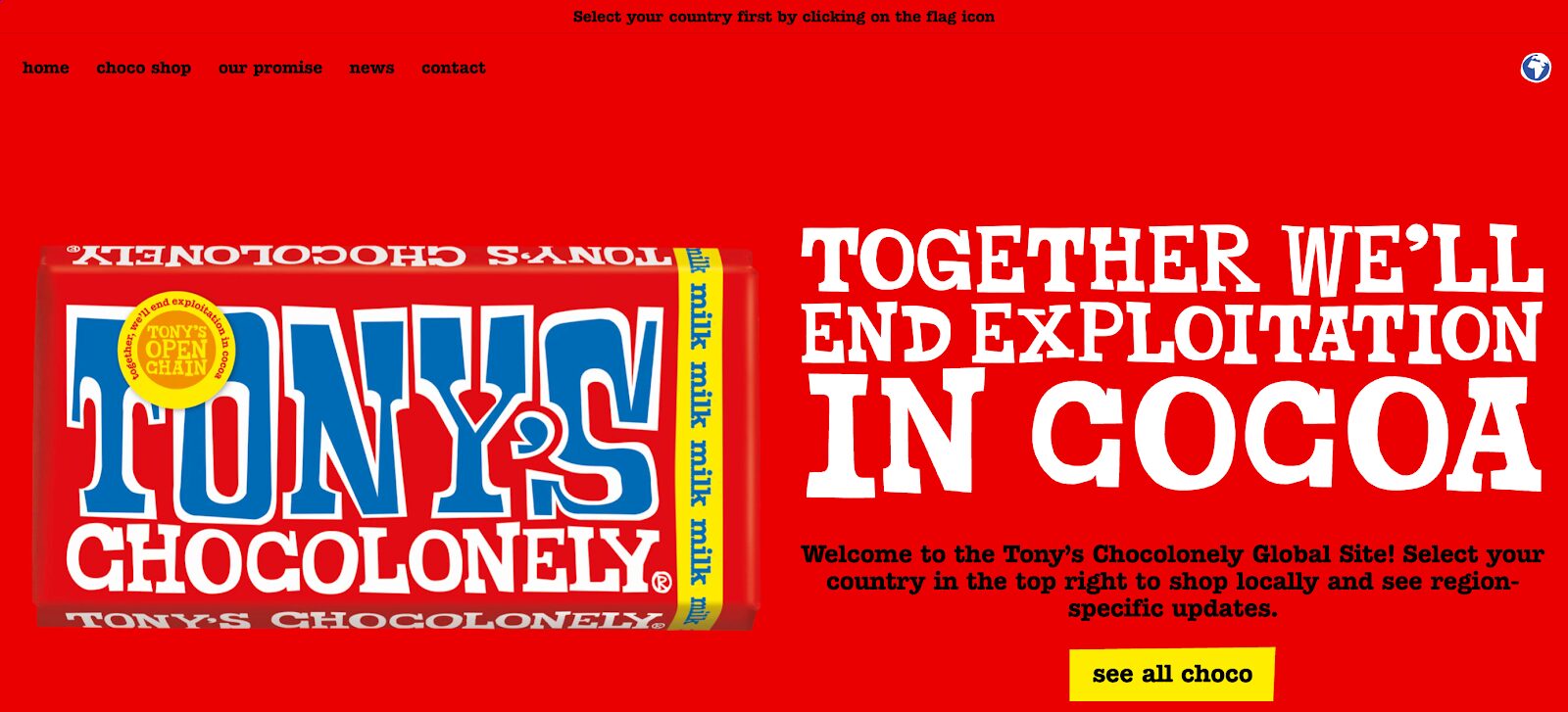
Tony’s Chocolonely’s website features a vibrant, colorful design that aligns with its fun, ethical brand.
The site also redirects international customers to their specific regional sites, improving the shopping experience for global visitors.

The category page is visually appealing.

Each product page highlights important benefits, such as fair trade practices and palm oil-free ingredients.
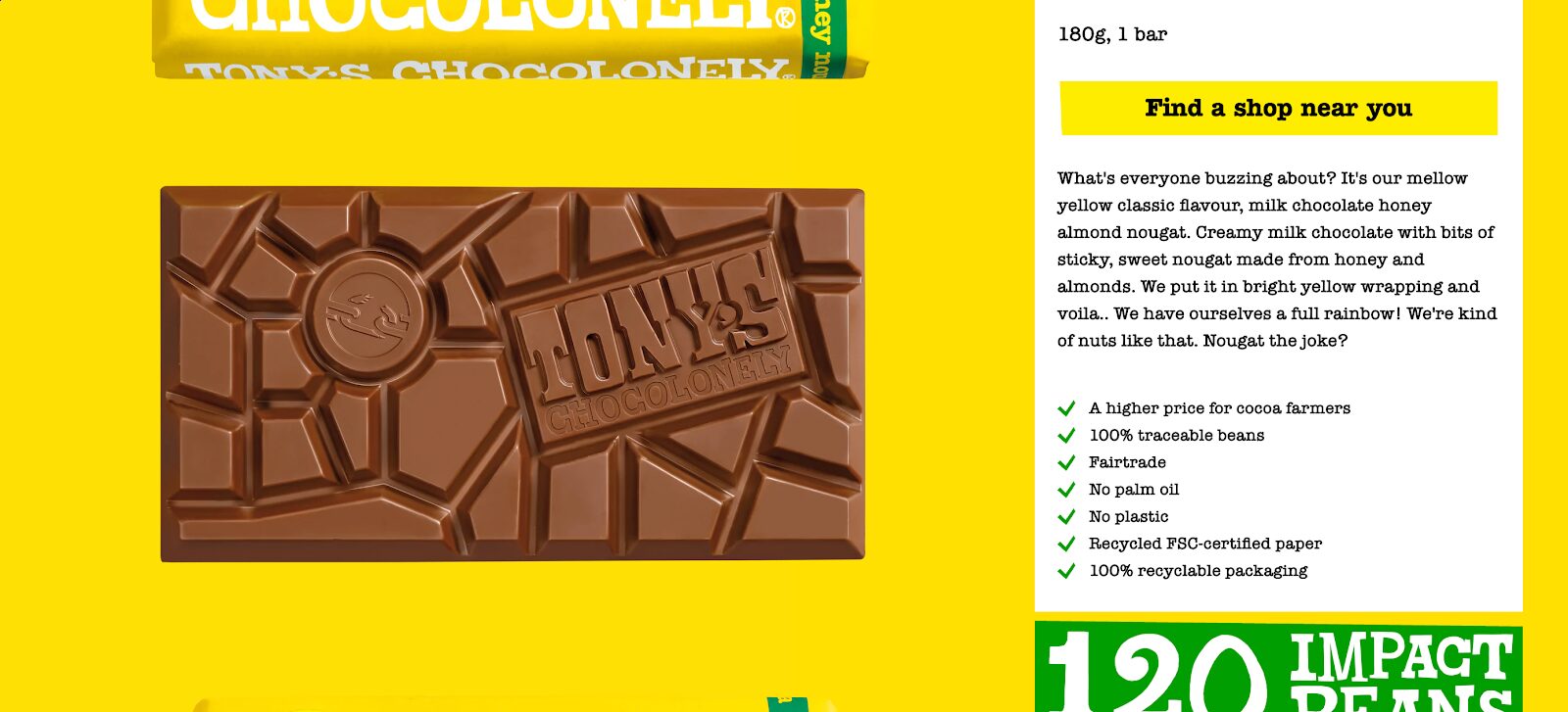
What we love:
- Colorful design that reflects the brand’s playful personality
- Location-based site redirection for a better user experience
- Focus on ethical practices, such as fair trade and no palm oil
33. Soi Paris
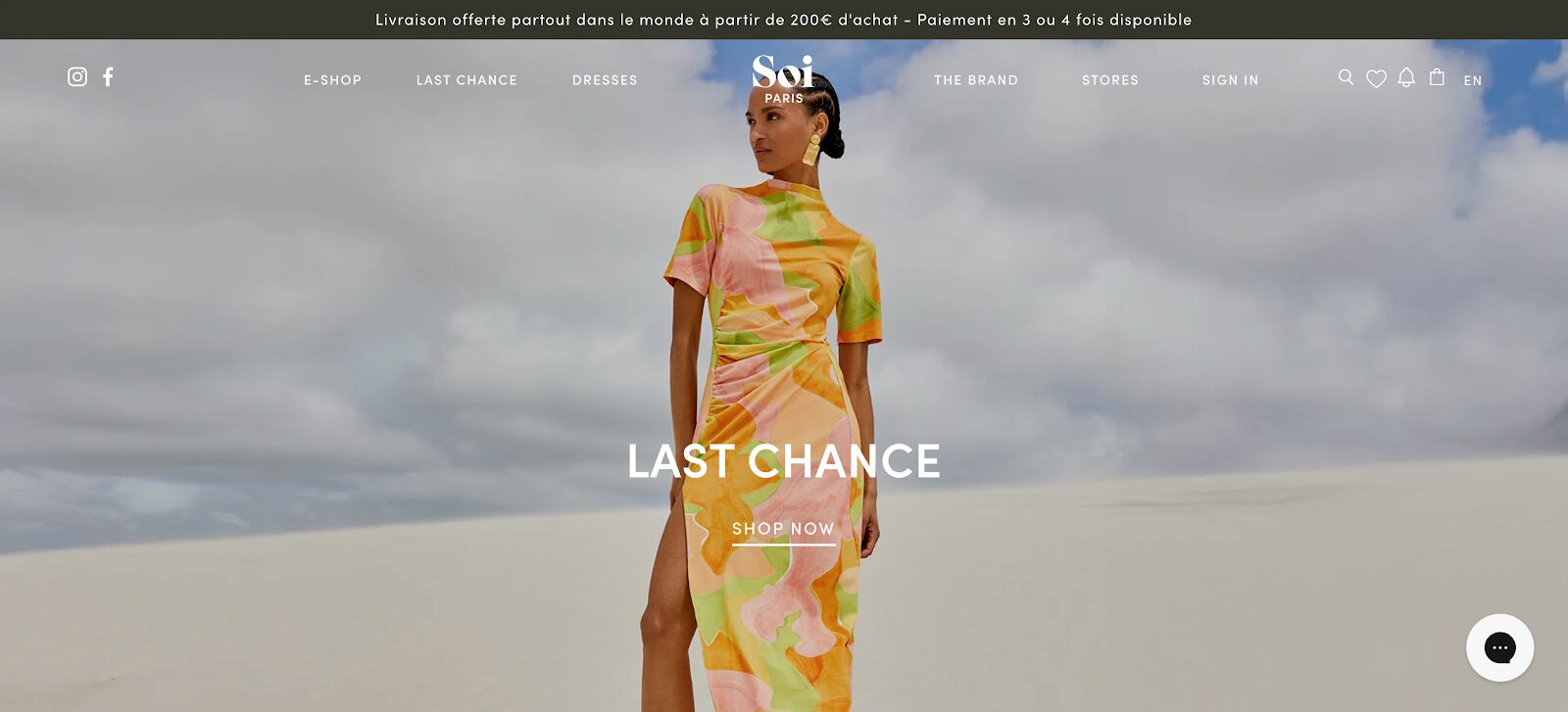
Soi Paris, a fashion ecommerce site, offers a sophisticated design that aligns with the high-end nature of their brand.
The homepage prominently features a “Last Chance” section, creating urgency for visitors to make a purchase before products are gone.
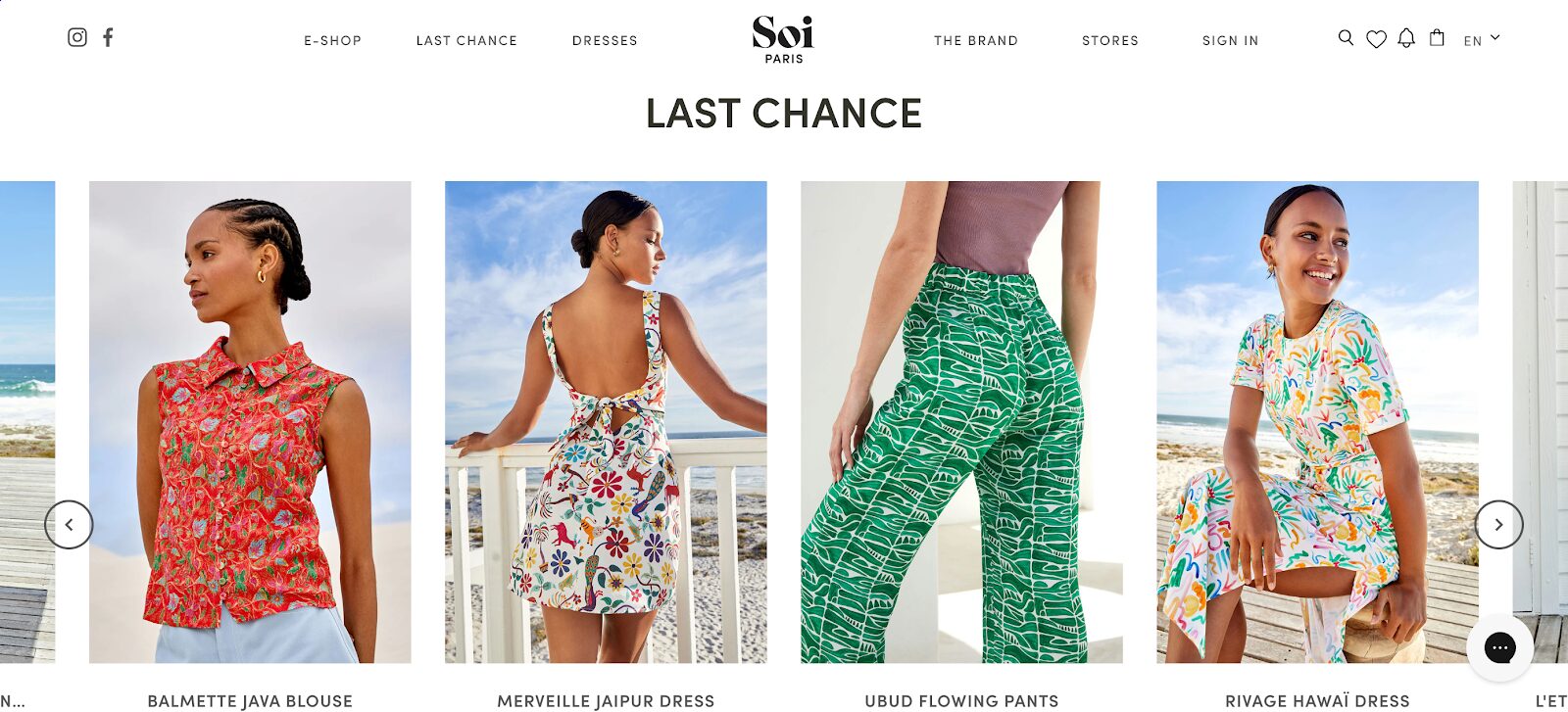
The ecommerce site also informs customers that Soi Paris is a certified B Corp, showcasing their ethical business practices.
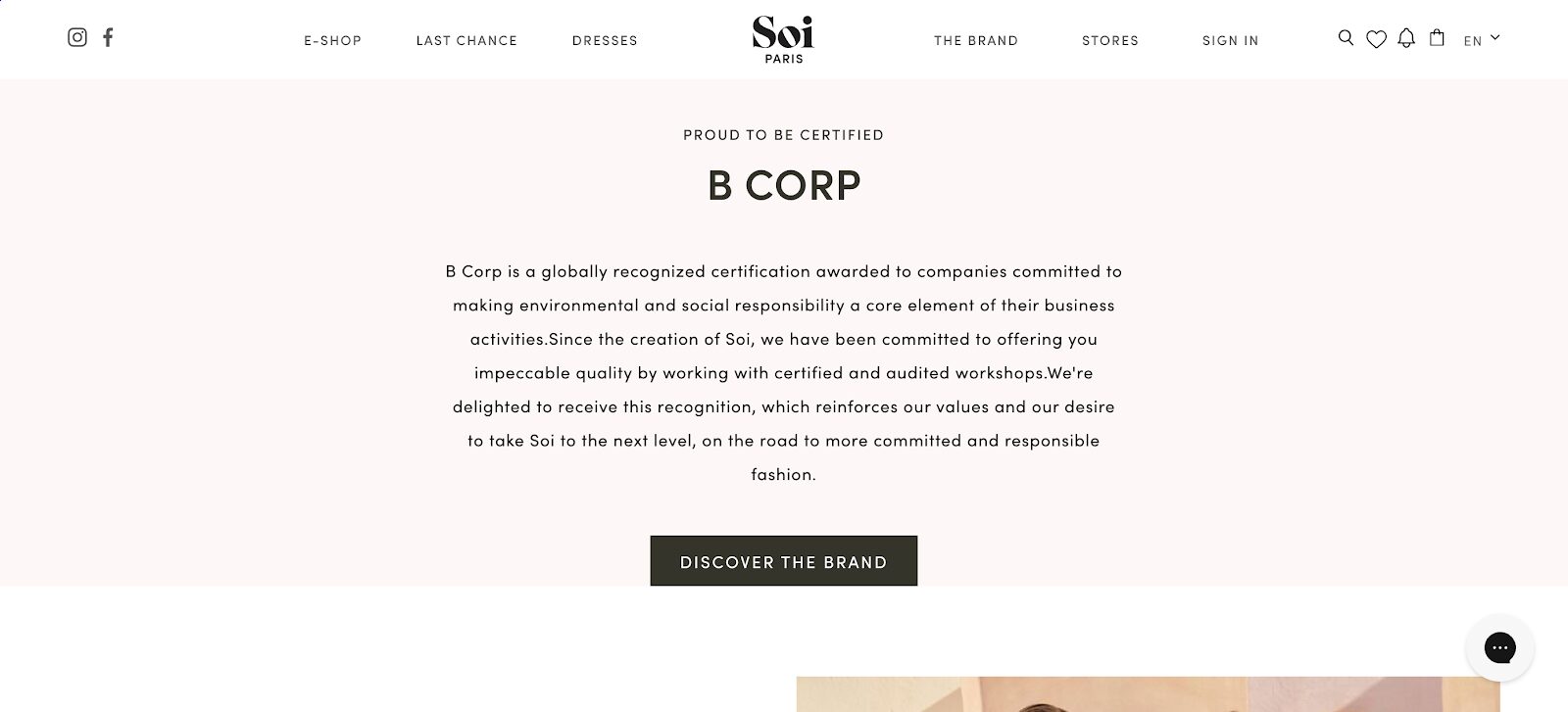
What we love:
- Clear communication of ethical values, such as being a certified B Corp
- Beautiful product images that enhance the shopping experience
- Detailed descriptions for each item, including shipping and transportation methods
34. Saalt

Female health brand Saalt offers a masterclass in clean, thoughtful website design.
Upon entering, visitors are greeted by various product videos, presented in a grid layout which allows for easy browsing.
The above-the-fold content is well-organized, maximizing the space to showcase their product line. Saalt also includes a conversational popup that offers a mystery discount.
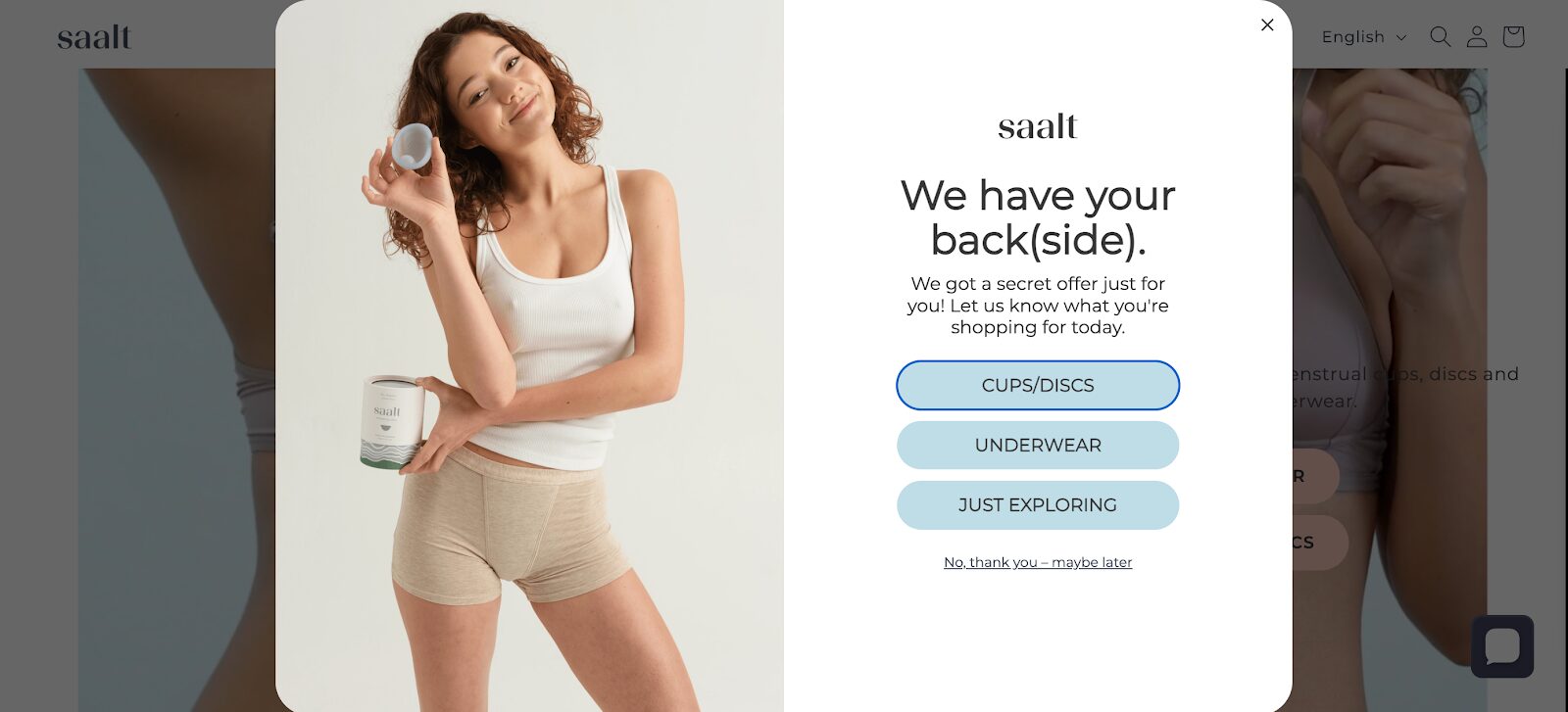
Real customer reviews are integrated throughout the site to build trust.
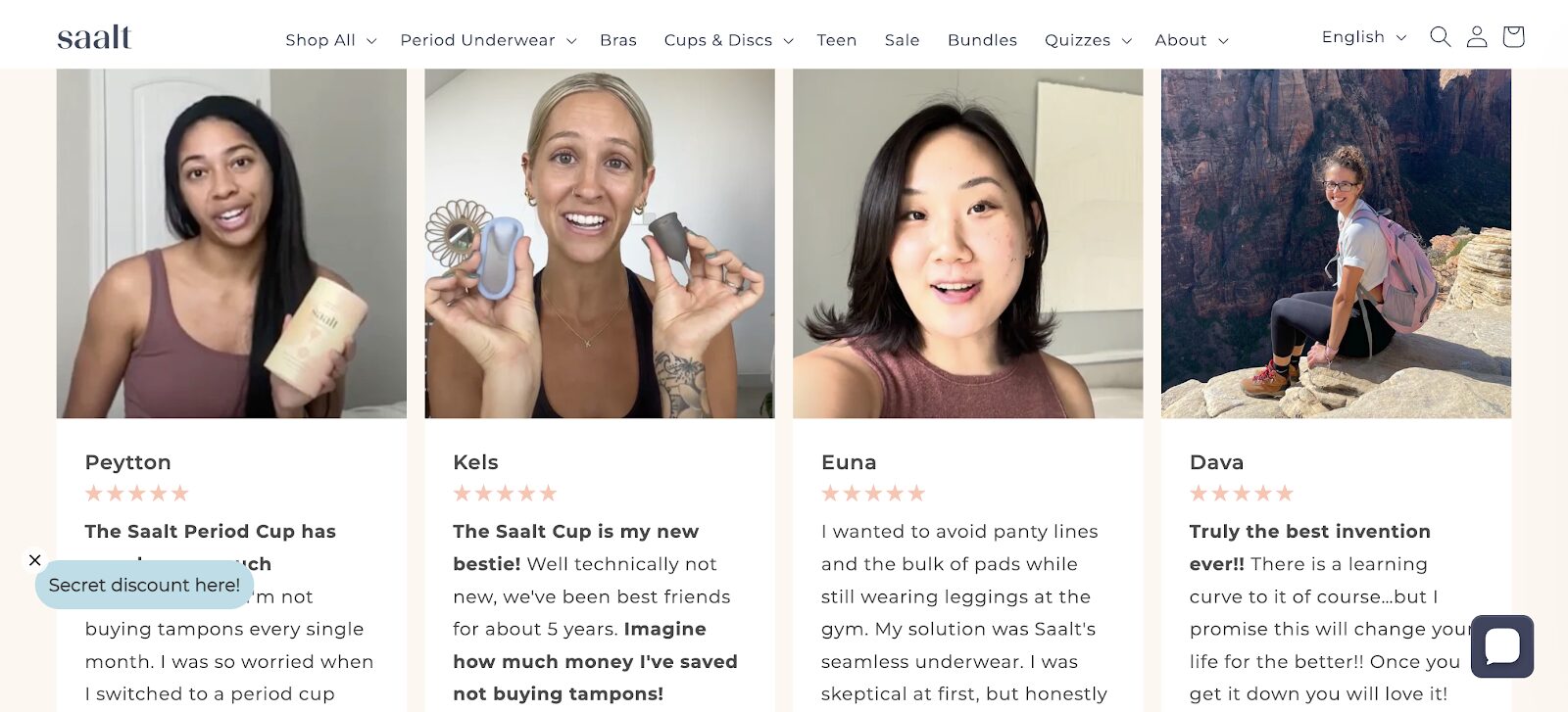
What we love:
- Descriptive product pages with questions answered in a chat box
- Multiple payment options displayed for customer convenience
- Key product details are clearly highlighted on the product pages
35. Finn
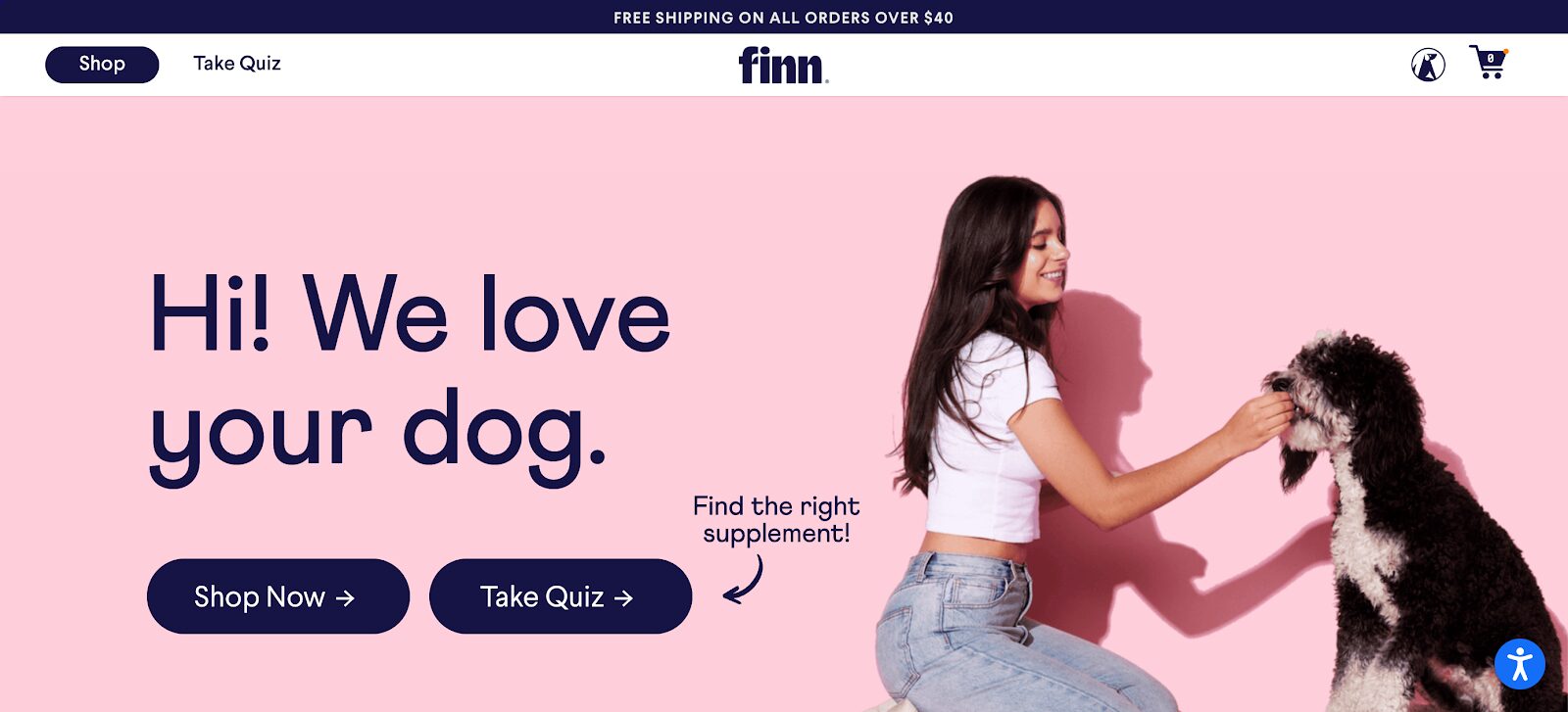
Finn, a dog care brand, uses joyful imagery of happy dogs paired with friendly fonts to make the site visually appealing.
The design incorporates a quiz that helps visitors find personalized product recommendations based on their dog’s needs.

Finn’s product pages are efficient, using icons and images to clearly communicate the value of each item.
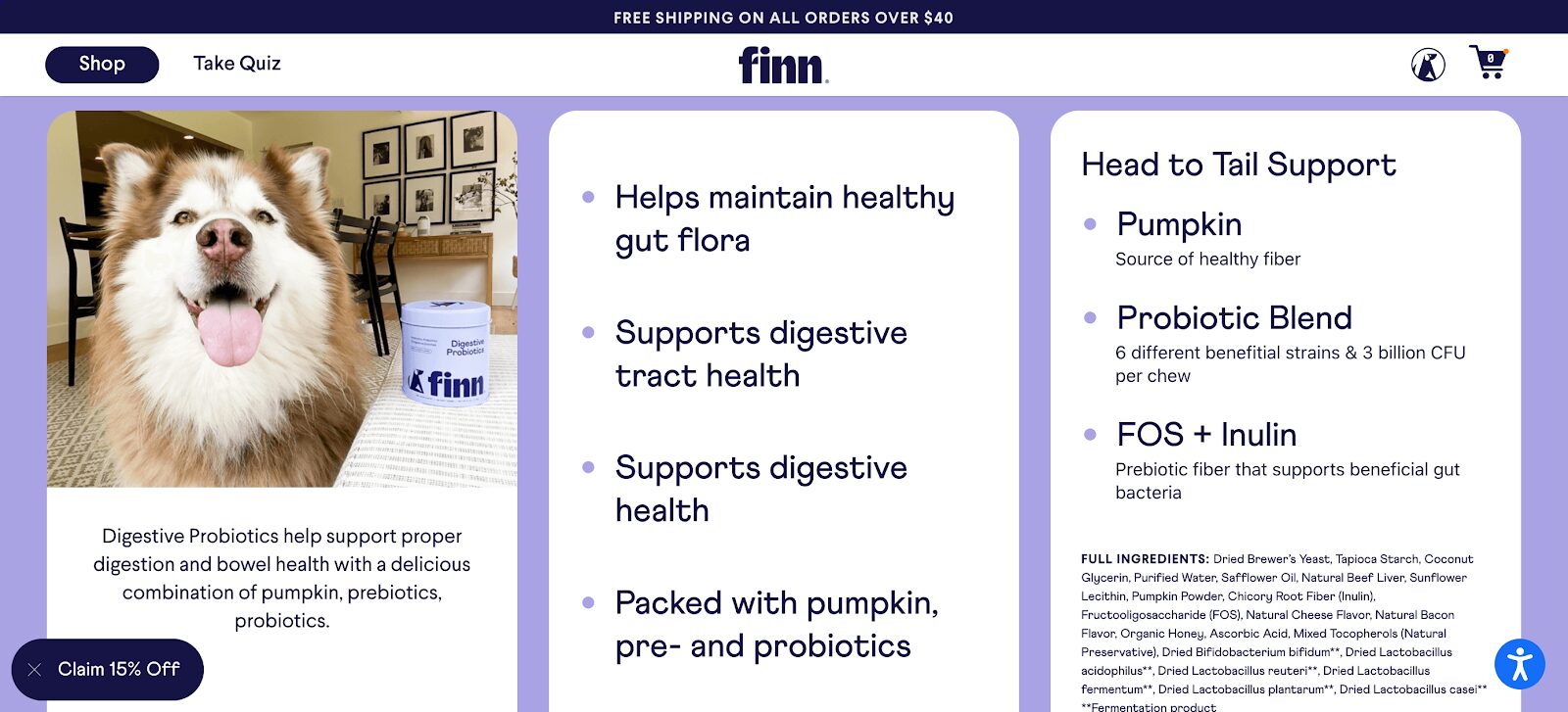
What we love:
- Smart page hierarchy that keeps the site easy to navigate
- Shopping bundles on product pages that encourage bulk purchases
- A wide footer that consolidates important links and information
36. BlendJet
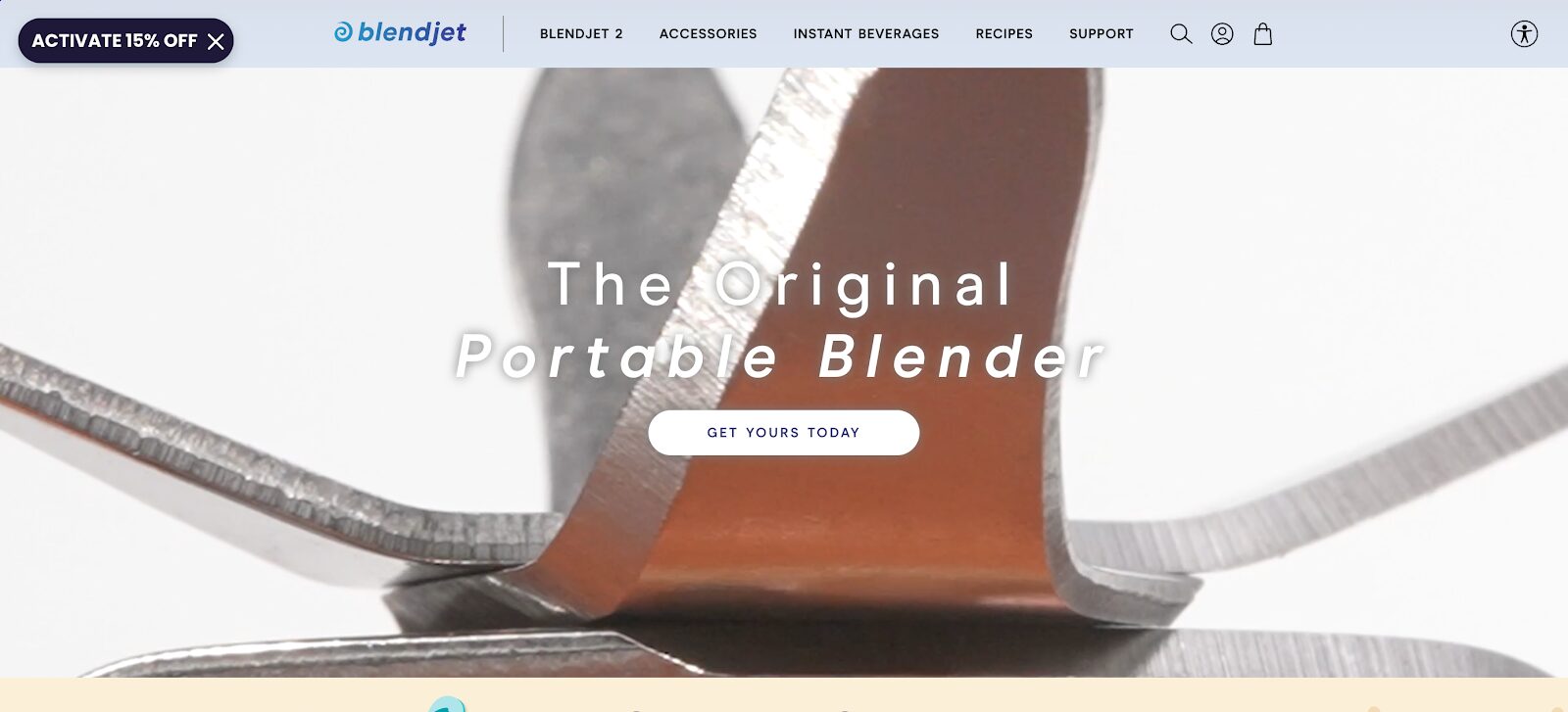
BlendJet’s website design is sleek and simple, with a focus on high-converting elements.
The homepage features a fullscreen popup promoting a sale and a 15% discount, instantly grabbing attention.

The product pages are designed like landing pages, highlighting the unique selling points of the blenders and providing a great value proposition for visitors to act on.
What we love:
- Product pages designed like landing pages to increase conversions
- Fullscreen discount popup that creates excitement and urgency
- Clear value propositions on product pages to encourage purchases
Discover how BlendJet boosted their revenue by nearly 40% with OptiMonk.
37. Highway Robery
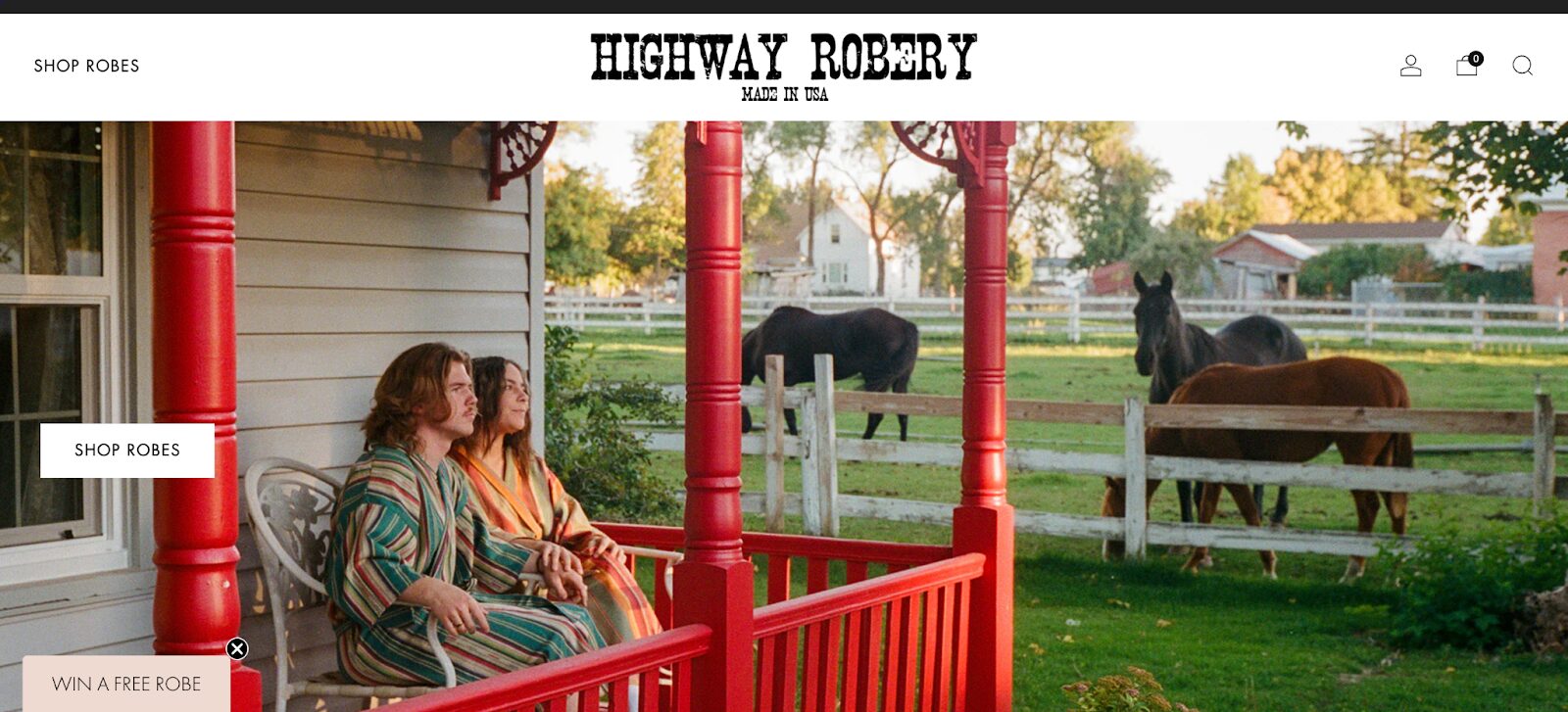
Highway Robery offers ethically made robes, and their website design highlights this by focusing on product quality and sustainability.

The product pages feature detailed descriptions about the thickness, stretch, and softness of each robe, helping customers make informed decisions.
The content is easy to scan, and their clever, almost poetic copy enhances the shopping experience.
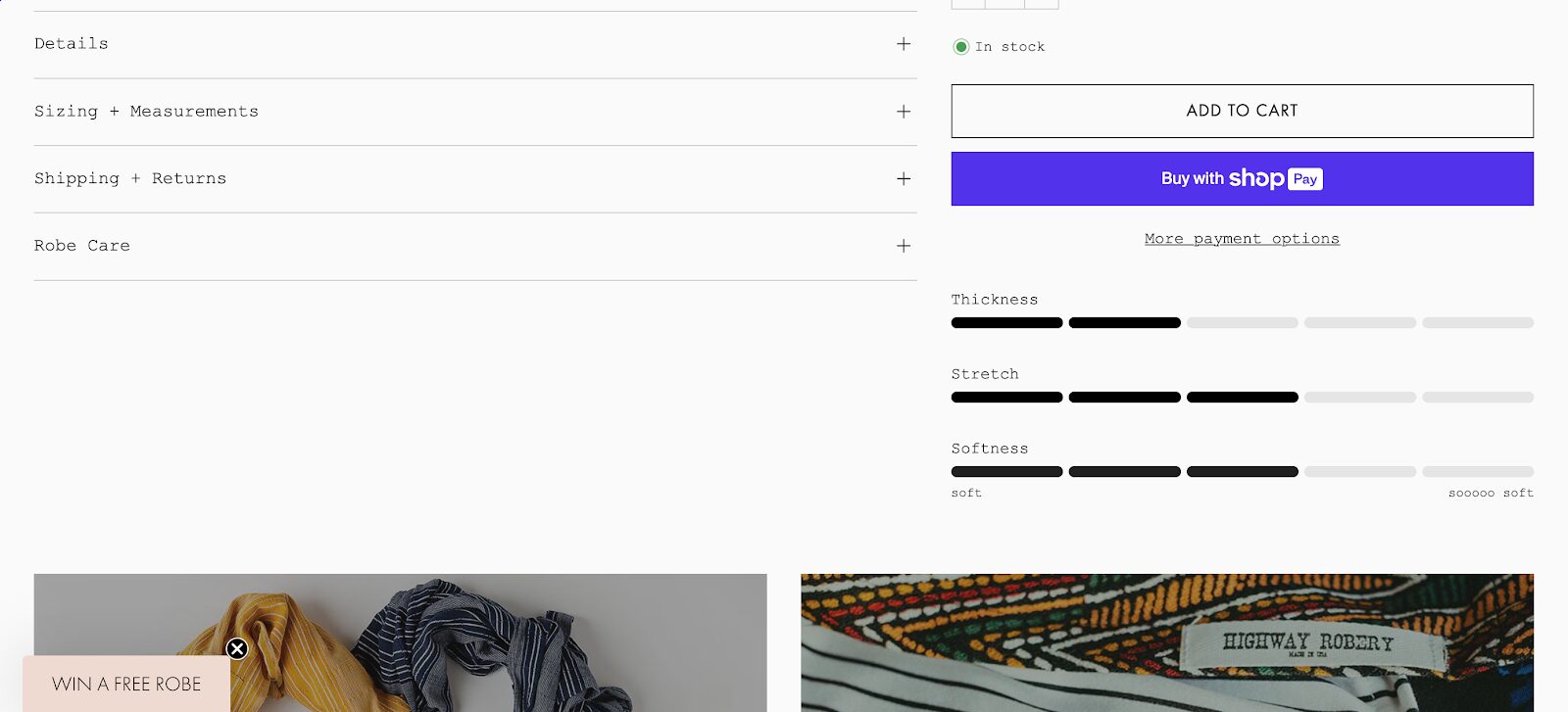
What we love:
- Descriptive product pages that provide clear information
- Easy-to-scan content that keeps the site organized
- Smart and engaging copy that gives personality to the brand
Wrapping up
These 37 ecommerce website design examples show how simplicity, functionality, and smart design can truly elevate your brand.
From scannable layouts to dynamic shipping bars, these brands have mastered ecommerce design. Apply these strategies to your own ecommerce business and watch your conversions, engagement, and satisfaction soar. Happy designing!
Migration has never been easier
We made switching a no-brainer with our free, white-glove onboarding service so you can get started in the blink of an eye.
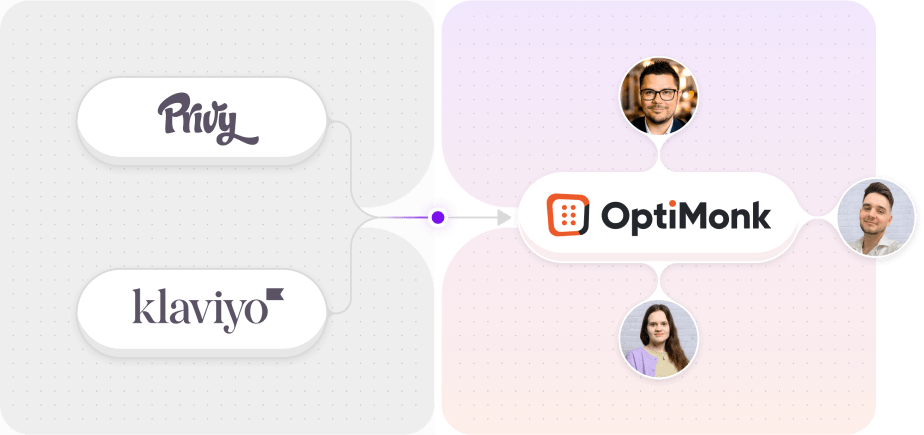
What should you do next?
Thanks for reading till the end. Here are 4 ways we can help you grow your business:
Boost conversions with proven use cases
Explore our Use Case Library, filled with actionable personalization examples and step-by-step guides to unlock your website's full potential. Check out Use Case Library
Create a free OptiMonk account
Create a free OptiMonk account and easily get started with popups and conversion rate optimization. Get OptiMonk free
Get advice from a CRO expert
Schedule a personalized discovery call with one of our experts to explore how OptiMonk can help you grow your business. Book a demo
Join our weekly newsletter
Real CRO insights & marketing tips. No fluff. Straight to your inbox. Subscribe now
Barbara Bartucz
- Posted in
- Ecommerce
Partner with us
- © OptiMonk. All rights reserved!
- Terms of Use
- Privacy Policy
- Cookie Policy
